ABBE, WALTER (1841-1924). Private, 37th Regiment, New York State National Guard, Company F. A New York City native, Abbe was first educated in private schools, then attended public schools until 1856, when he entered the Free Academy of New York City from which he graduated in 1862. During the Civil War, he enlisted as a private on May 29, 1862, at New York City, and immediately mustered into the 37th Regiment. He mustered out after three months on September 2, 1862, at New York City.
Civil War Bio Search
As per the census of 1880, Abbe lived in New York City with his mother and siblings, was single, and was employed by the Atlantic White Lead Works. On January 27, 1881, he married Ida Beulah Patten in New York City. As per his family’s genealogy, he worked with the Atlantic White Lead Works where he worked to improve its efficiency until 1892 when that company was absorbed by the National White Lead Company. At the time of the census of 1900, he had been married for nineteen years, lived on St. Marks Avenue in Brooklyn with his wife and four children, and was employed in the patent industry. His family records note that he worked for Howson and Howson, patent solicitors and attorneys in New York City. In 1905, he filed for and was granted an invalid pension, certificate 1,108,060; as of June 1918, he received $30 per month. Abbe last lived in South Windham, Connecticut, where he died from a cerebral hemorrhage. Ida Beulah Abbe, who is interred with him, applied for and was granted a widow’s pension in 1924, certificate 962,396. Section 53, lot 6325.
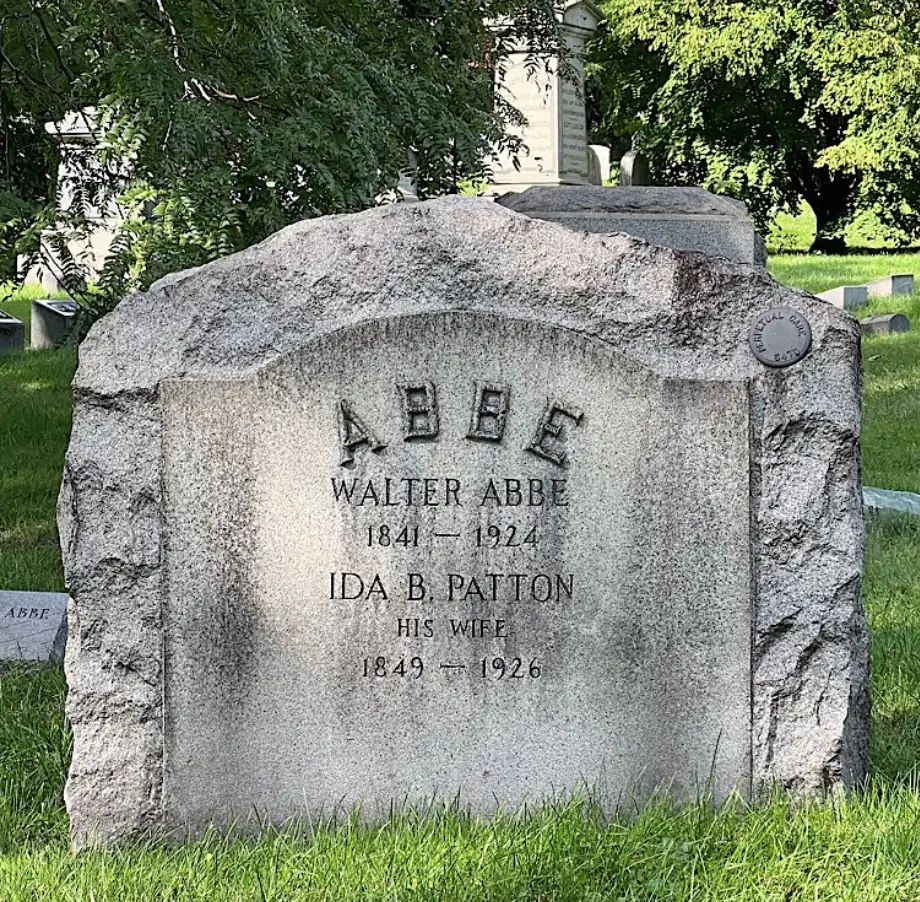
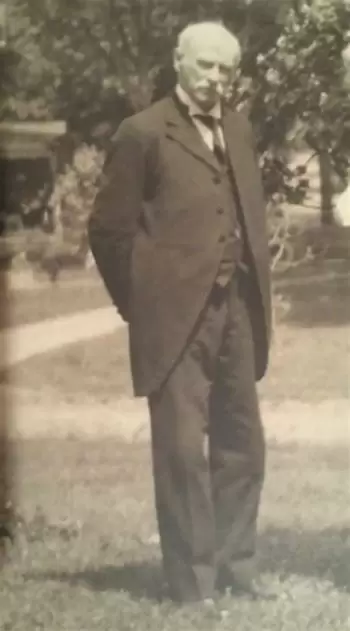
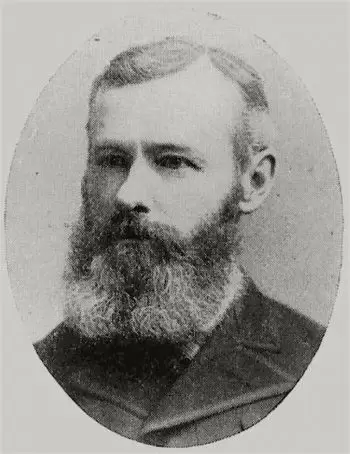
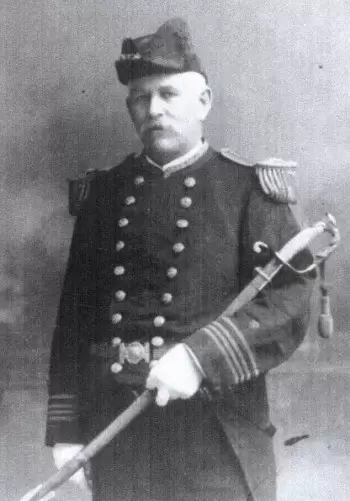
ABBEY, CHARLES AUGUSTUS (1841-1919). Third lieutenant, United States Revenue Marines. Abbey, who was born in Rondout, New York, and was a resident of Syracuse, began service in the Revenue Marine in 1864 as a third lieutenant. His initial assignment was on the Walter B. Forward, a cutter that was part of the Atlantic Blockading Squadron off Wilmington, North Carolina. In March 1865, when he was officially commissioned as a third lieutenant, he was in charge of the Emmaline Johnson, a warship in New York Harbor.
After the war, Abbey continued his service and became a second lieutenant on June 6, 1866, a first lieutenant on January 9, 1867, and a captain on April 26, 1872. He was captain of the USRC Corwin, which patrolled the waters off Alaska and the Pacific coast. The Revenue Marine later merged with the Coast Guard. In 1886, he was assigned as Inspector of Life Saving Stations in New York, and three years later, was made Inspector General of the Life Saving Service and Superintendent of Construction for all of the coasts of the United States, except Alaska.
Among Abbey’s commands was the Bear, the vessel that Admiral Richard Byrd took to Antarctica. Abbey’s accomplishments were recorded in the book, Before the Mast in the Clippers (1937), by Harpur Allen Gosnell, and acknowledged by his fellow senior officers who promoted him to senior captain a year after he retired in 1898. After the Civil War, he first lived in New Berne, North Carolina, then moved to Northport, Long Island, and Brooklyn. A one-time trustee of the village of Northport, he died there from heart disease in 1919. Section 65, lot 12118.
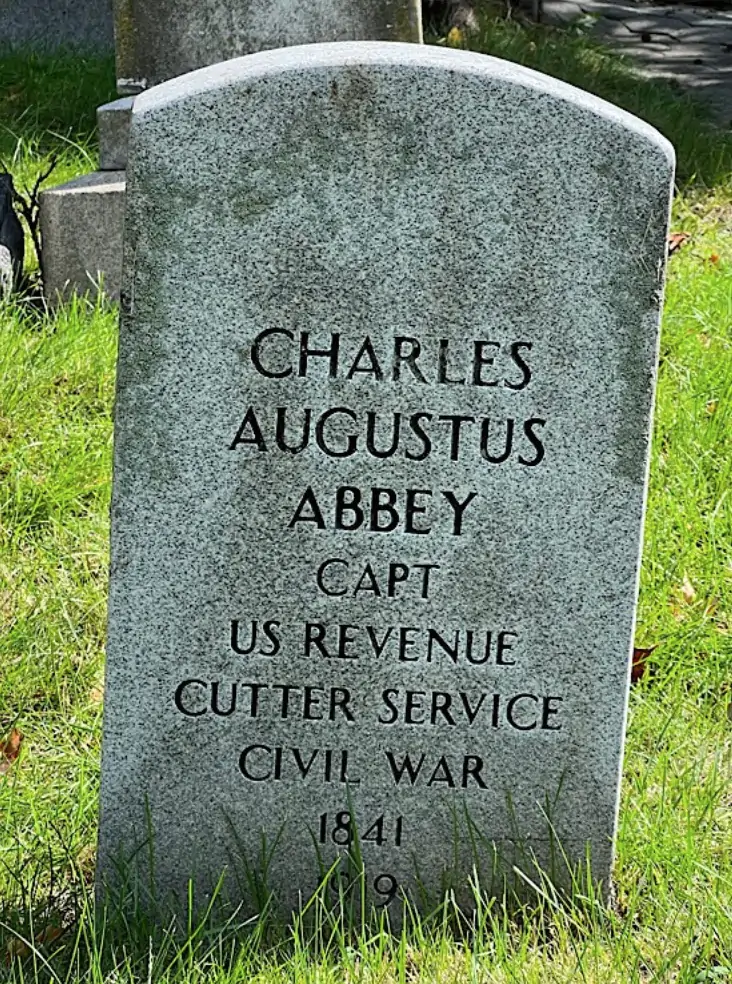
ABBEY, CHARLES F. (1845-1884). Sergeant, 107th New York Infantry, Company C. According to his muster roll and the 1860 census, Abbey was born in Schuyler County, New York; his death certificate incorrectly indicates that he was born in Connecticut. At the time of the 1860 census, he lived in Reading, New York, attended school and lived with his parents and sibling. After Abbey enlisted as a private on July 30, 1862, at Elmira, New York, he mustered immediately into Company C of the 107th New York. As per his muster roll, he was a farmer who was 5′ 7″ tall with gray eyes, auburn hair and a light complexion. He was promoted to corporal of his company on May 1, 1863. At the Battle of Averysboro, North Carolina, on March 16, 1865, Abbey was severely wounded in the left leg, necessitating its amputation. Subsequently promoted to sergeant on April 1, 1865, he was hospitalized at the time of his discharge on August 23, 1865. On February 10, 1866, his application for an invalid pension was granted, certificate 65,086.
As per his obituary in the New York Herald, which confirms his Civil War service, Abbey had been associated with the Lorillard Insurance Company in New York City before he relocated to Colorado in hopes of restoring his wife’s health; his wife died in 1882. Abbey was involved in the mining industry in that state and, at the time of his death, was the mayor of Virginia City. His death certificate notes that he was a widower and was a miner.
Abbey last lived in Colorado but died at 44 East 34th Street in Manhattan after fracturing his arm and suffering other injuries after a fall down an elevator shaft at the Burlington Flats. As per a letter written by his cousin, and noted in the Express, a newspaper from Watkins, New York, Abbey visited a friend at the Burlington Flats and, when he left at 10:00 p.m., stepped into the elevator which the porter had left for a moment. After the elevator started to go upward, Abbey reached for the cable to halt its progress but the elevator continued upward squeezing Abbey’s right arm and striking his left shoulder; ultimately, Abbey was ejected from the elevator and fell five stories. He died a week after his fall. His funeral took place at the Seventh Presbyterian Church on Broome Street in Manhattan. Section 169, lot 14285.
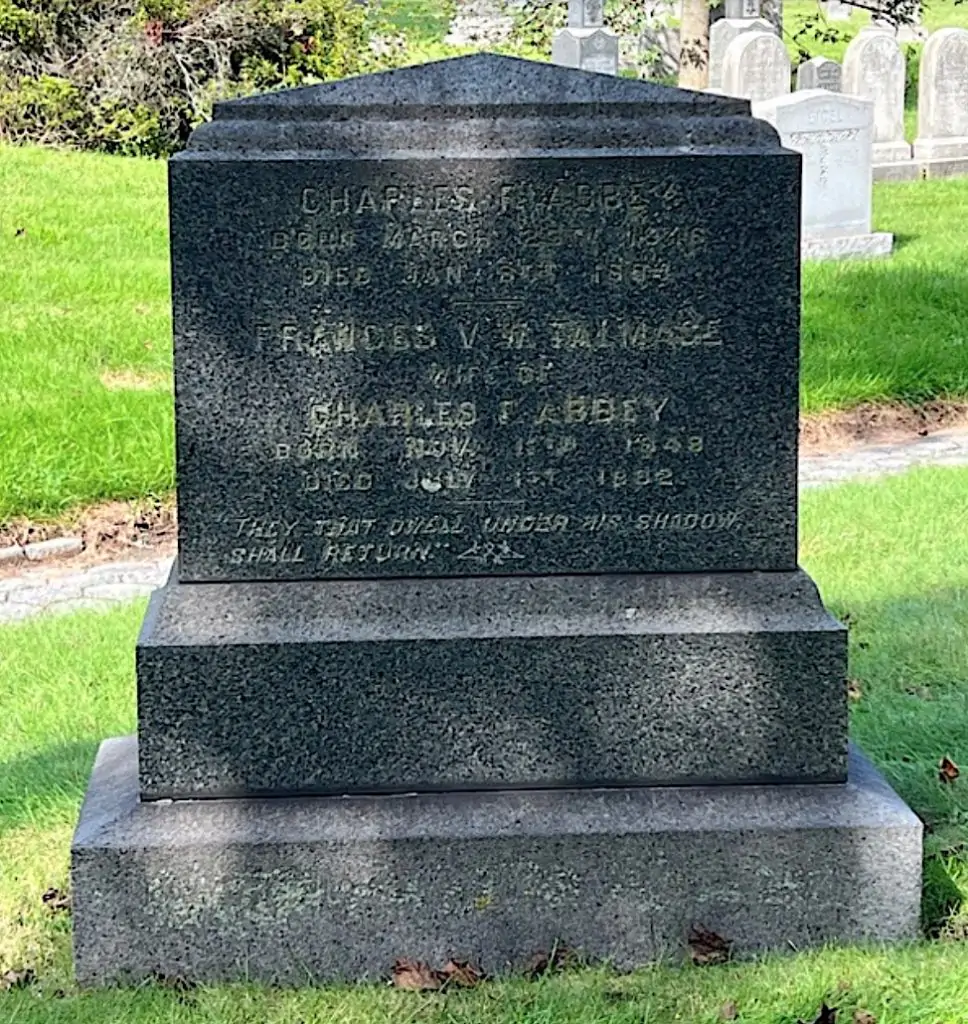
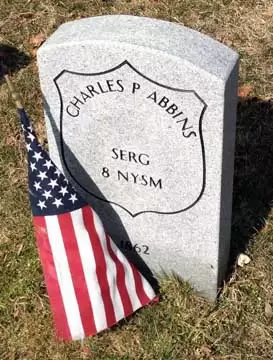
ABBINS, CHARLES P. (1839-1862). Sergeant, 8th Regiment, New York State National Guard, Company I. After enlisting as a sergeant at New York City on May 29, 1862, Abbins immediately mustered into the 8th Regiment. He died of typhoid fever at Yorktown, Virginia, on July 29, 1862, and was interred in the Soldiers’ Lot at Green-Wood on November 20 of that year. In 1868, his mother, Sarah Albin, applied for and received a pension, certificate 130,002. Section 115, lot 13536 (Soldiers’ Lot), grave 45.
ABBOTT, GEORGE ELY (1834-1916). First lieutenant, 131st New York Infantry, Companies B and K; private, 13th Regiment, New York State Militia, Company G. Abbott was born in New Hampshire. As per the 1850 census, he lived in Brooklyn with his parents and siblings. After serving for three months in the 13th New York State Militia in 1861, he re-enlisted as a second lieutenant at New York City on August 20, 1862, was commissioned into Company B of the 131st New York on September 6, and was promoted to first lieutenant on November 25, 1863, effective upon his transfer to Company K. Colonel Edward L. Molineux, Commander of the Second Brigade, singled out Abbott for “his conspicuous gallantry” in battle near Harrisonburg, Virginia, on September 26, 1864. Although he was promoted to captain on December 8, 1864, he never mustered in as a captain. He mustered out on July 26, 1865, at Savannah, Georgia. In 1907, his application for an invalid pension was granted, certificate 1,136,562. He last resided at 1217 45th Street in Brooklyn. Abbott’s death certificate notes that he was single. His death was attributed to arteriosclerosis. Section 36, lot 3333.
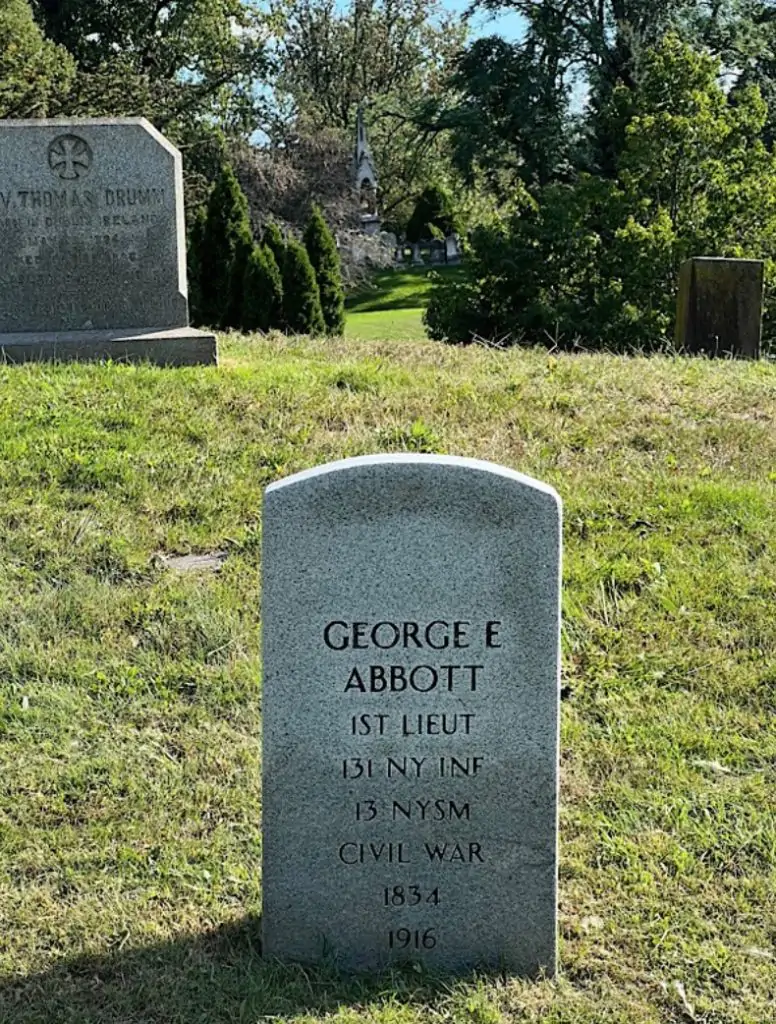
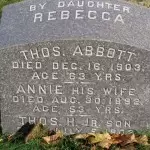
ABBOTT, THOMAS H. (1840-1903). Sergeant, 84th New York (14th Brooklyn) Infantry, Company B. Abbott, who was of Irish origin, enlisted at Brooklyn on April 18, 1861, as a private, and mustered into the 14th Brooklyn on May 23. On September 17, 1862, he was wounded in action at the Battle of Antietam, Maryland. On January 1, 1863, he was promoted to sergeant of his company. After he was wounded on May 8, 1864, at the Battle of Laurel Hill, Virginia, Abbott mustered out at New York City a month later on June 5. He applied for an invalid pension in July 1864, application 48,607, but no certification number is indicated. He last lived at 844 Greenwich Street in Manhattan. He died from myocarditis. Section 135, lot 27263, grave 2029.
ABBOTT, WILLIAM (enlisted as JONES, WILLIAM) (1832-1870). Private, 63rd New York Infantry, Company H; 133rd New York Infantry, Company A; 4th Artillery, United States Army, Company K. Born in Ireland, he enlisted as a private on September 16, 1861, at New York City, and mustered immediately into the 63rd New York. Although records indicate that he deserted at Staten Island on September 21, 1861, he re-enlisted as a private at New York City on August 16, 1862, mustered into the 133rd New York on September 24, and was transferred into the 4th Artillery, United States Army, on November 1 of that year. His soldier history indicates that he used the alias William Jones. His last residence was 324 East 31st Street in Manhattan where his death was attributed to tuberculosis. In 1880, his widow applied for a pension, application 275,024. Section B, lot 11005, grave 377.
ABBOTT, WILLIAM M. (1839-1919). Private, 72nd New York Infantry, Company C; 120th New York Infantry, Company K. A native of New York City, Abbott enlisted as a private at Newton, New York, on September 6, 1862, and mustered into the 72nd New York Infantry that same day. His soldier record indicates that he was released at City Point, Virginia, on March 15, 1863, but there is no additional information. On May 3, 1863, he was wounded at Chancellorsville, Virginia. On July 23, 1864, he transferred into the 120th New York Infantry. He mustered out at Camp Parole at Annapolis, Maryland, on June 21, 1865.
The 1903 Jersey City Directory indicates that Abbott worked as a manager. In 1905, his application for an invalid pension was approved under certificate 1,114,748. Abbott last lived at 218 West 21st Street in Manhattan. He died from heart disease at Hoboken, New Jersey. Section 24, lot 6780.
ABEEL, JOSEPH C. (1839-1911). Sergeant, 115th New York Infantry, Company C. Originally from Albany, New York, Abeel enlisted as a corporal at Northumberland, New York, on August 1, 1862, and mustered into the 115th New York ten days later. Taken as a prisoner of war at Harpers Ferry, Virginia, on September 15, 1862, he was paroled the next day. As per his obituary in the Brooklyn Daily Eagle, Abeel fought in all of the engagements of the 115th New York which were largely confined to the South Atlantic states, most notably at the Battle of Olustee, Florida. He was promoted to sergeant at some point before mustering out on June 17, 1865, at Raleigh, North Carolina.
Abeel married Harriet G. White in Sandy Hill, New York, on an unknown date. In civilian life, he was employed in the wholesale business trade. In 1890, his application for an invalid pension was granted, certificate 614,502. Remaining active in military affairs, his obituary indicates that he was a member of the George C. Strong Post #534 of the G.A.R., the Society of the Department of the South and South Atlantic Blockading Squadron and an associate member of the Veteran Associations of the 47th and 48th Regiments. In addition, he was a Freemason and secretary and treasurer of the Mount Olivet Presbyterian Sunday School at its inception. His obituary notes that he was well-known in the Bedford district of Brooklyn and held in high esteem by his neighbors and large circle of friends. A widower, he last lived at 801 Lafayette Avenue in Brooklyn; he was survived by a son and daughter. His death was attributed to cystitis. Section 149, lot 19554, grave 3.
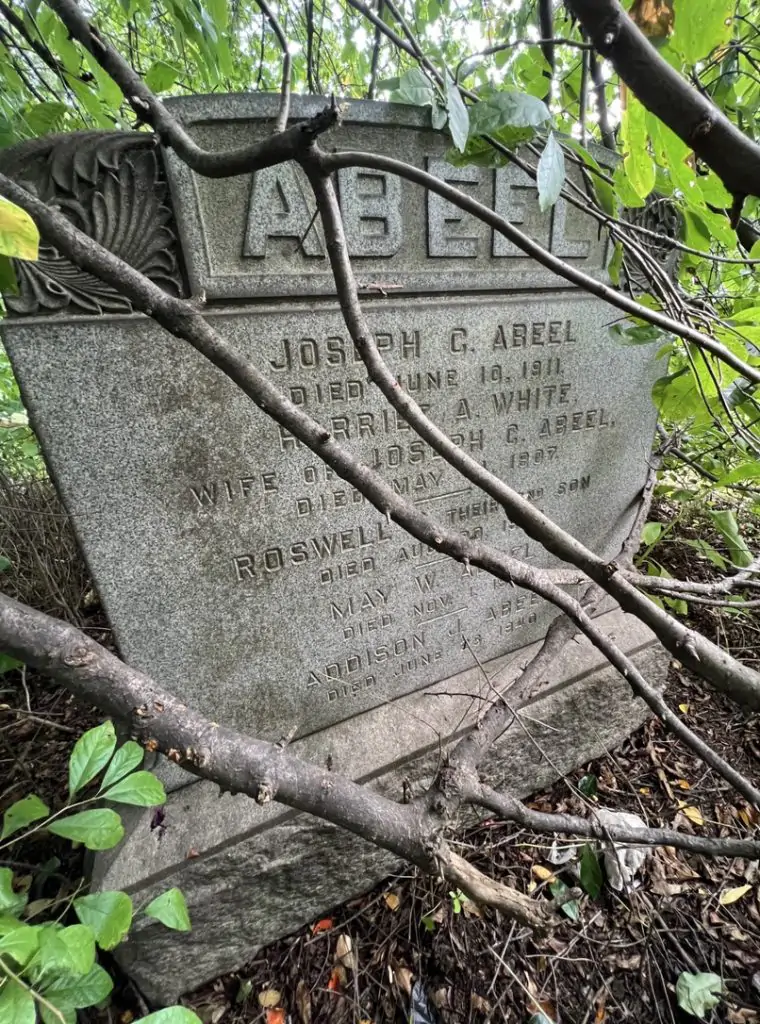
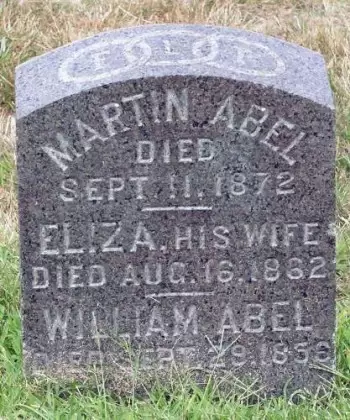
ABEL, MARTIN (1843-1872). Private, 9th New York Heavy Artillery, Company I. Abel enlisted as a private at Auburn, New York, on August 9, 1862, mustered immediately into the 9th Heavy Artillery, and mustered out on July 6, 1865, at Washington, D.C. His descendant belonged to the Sons of Union Veterans. He last resided at 388 Cherry Street in Manhattan. He died from pneumonia. Section A, lot 8998, grave 361.
ABER, FRANK (or FRANCIS) L. (1848-1926). Seaman first class, United States Navy. Born in Indiana, he served in the Navy as a seaman first class during the Civil War. Further details of that service are not known. According to his pension record, he was also a corporal in Battalion D of the United States Engineers from June 4, 1869-February 18, 1871. In addition, he served in the General Mounted Service, but those dates are not specified. The 1870 and 1880 censuses listed him as living in the Army barracks in St. Louis, Missouri. He was living in New York by 1900 and last lived in Spring Valley, New York. His gravestone identifies him as “a Civil War Navy veteran.” Shortly after his death from pneumonia, Josephine Aber, his widow who is interred with him, was awarded a pension, certificate a5-23-27. Section 199, lot 24726.
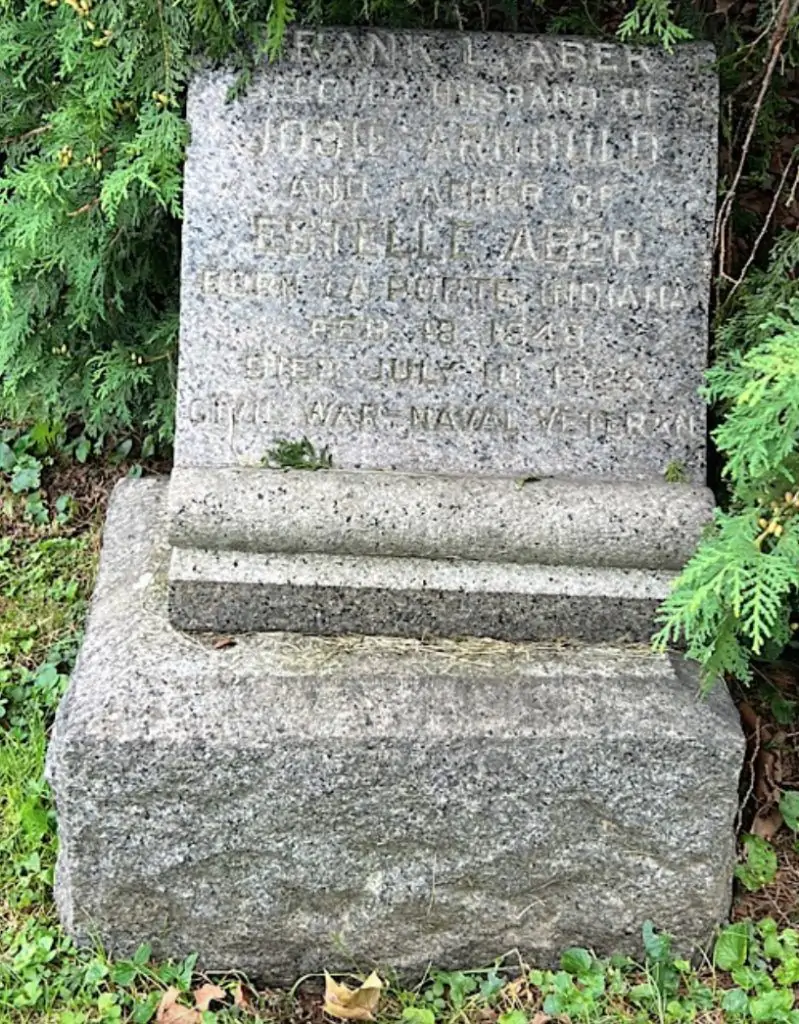
ABERNETHY, JOHN A. (1845-1923). Musician, 66th New York Infantry, Company D. Abernethy was born in New York. On December 24, 1861, he enlisted as a musician at New York City, and mustered immediately into Company D of the 66th New York. He was wounded on June 1, 1862, at Fair Oaks, Virginia, taken as a prisoner of war at Bristoe, Station, Virginia, on October 14, 1863, and paroled on November 20, 1864, at Savannah, Georgia. Abernethy mustered out at New York City on January 17, 1865.
Abernethy applied for and received an invalid pension in 1880, certificate 235,909. The 1910 census indicates that he earned his own income, was married for 38 years, and lived on 12th Street. As per the 1920 census, he was an office assistant. His last address was 213 Webster Avenue in Brooklyn. He died from cancer at St. Mary’s Hospital in Brooklyn. Section 154, lot 22263.
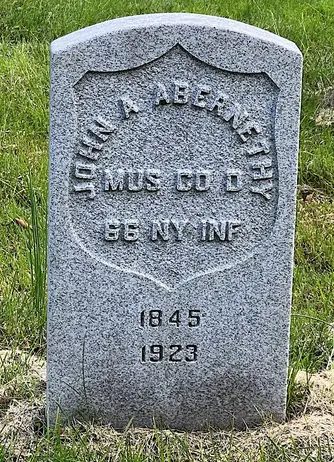
ABRAMS, JAMES (1846-1908). Private, 14th New York Heavy Artillery. Originally from Ireland, Abrams enlisted at Tarrytown, New York, on January 7, 1864, and mustered that day into the 14th New York Heavy Artillery without being assigned to a company. He mustered out on an unknown date. He last resided on East 20th Street in Manhattan where he succumbed to endocarditis. Section 15, lot 17263, grave 474.
ACKER, LEVI J. (1840-1928). Private, 50th New York Engineers, Company B. Originally from Pennsylvania and a harness-maker by trade, Acker was 5′ 8″ tall with blue eyes, light hair and a light complexion. He enlisted at Avon, New York, on May 9, 1864, mustered into the 50th New York Engineers on September 5, and mustered out with his company at Fort Barry, Virginia, on June 13, 1865. While stationed in Virginia, the men in his regiment built an elaborate wooden chapel.
The 1873-1876 Brooklyn Directory lists Acker among the harness-makers and saddlers; his home address was 797 Fulton Street. According to the 1880 census, he was married and working as a harness-maker; the 1880-1882 Brooklyn Directory reports that he was a harness-maker and saddler who lived at 974 Fulton Street. In 1905, his application for a pension was approved under certificate 1,118,696. The 1910 census reports that he was a widower working as a harness-maker and living on Bergen Street in Brooklyn. Acker died from heart disease at Kings County Hospital in Brooklyn. Section 17, lot 17245, grave 121.
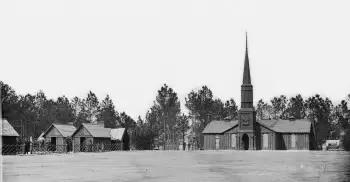
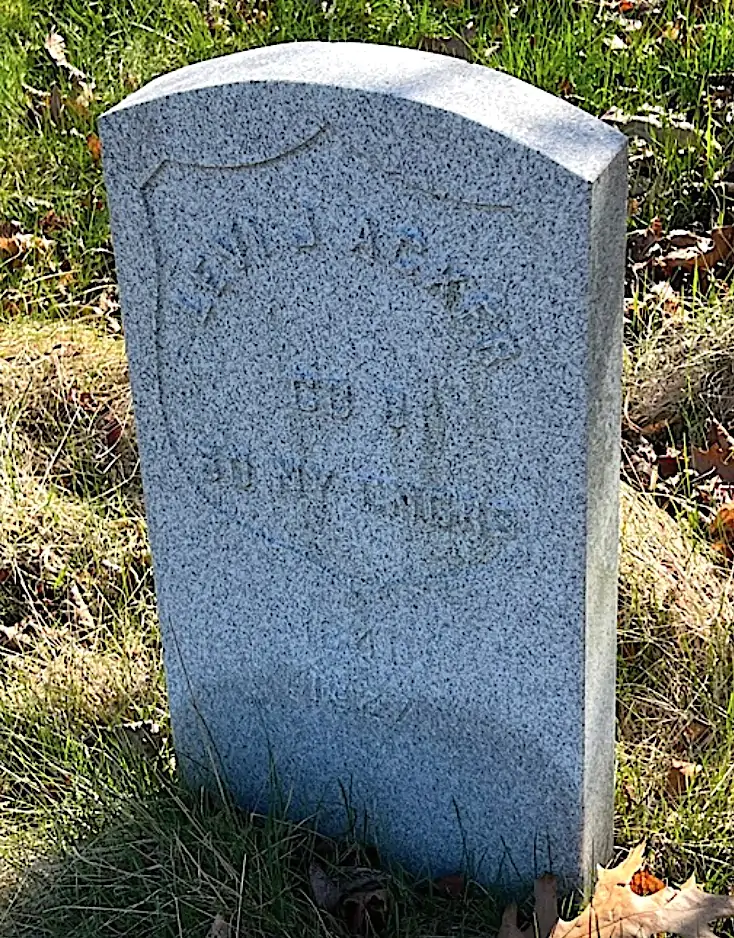
ACKERMAN, ABRAHAM (1832-1907). Private, 170th New York Infantry, Company F. After enlisting as a private on August 13, 1862, at New York City, Ackerman mustered into the 170th on October 7, and mustered out on July 15, 1865, at Washington, D.C. His application for an invalid pension in 1898 was granted, certificate 1,000,108. He last resided at 1412 Amsterdam Avenue in Manhattan where he died from nephristis. His widow, Annie Ackerman, applied for and received a pension after his death in 1907, certificate 625,814. Section 199, lot 24098, grave 3.
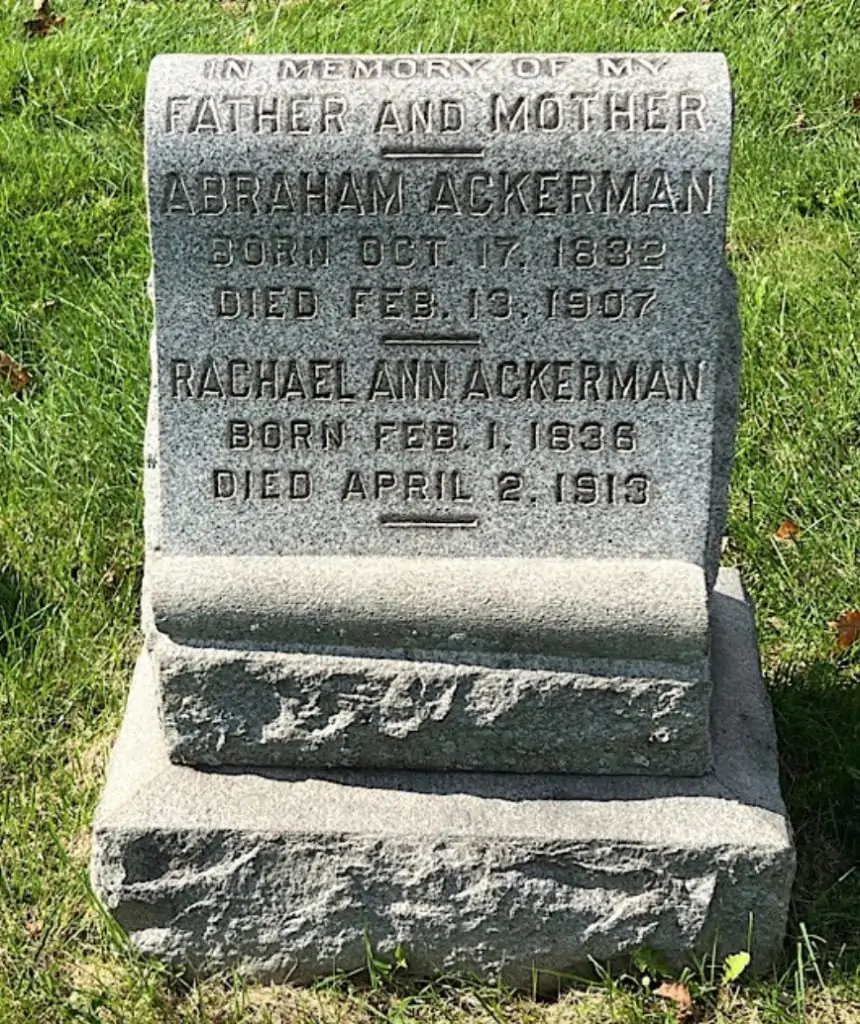
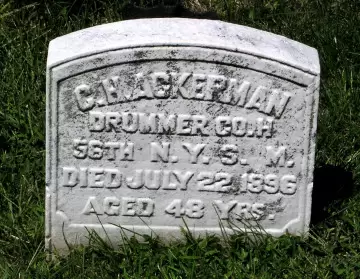
ACKERMAN, CLARK H. (1847-1896). Private and drummer, 56th Regiment, New York State National Guard, Company H. A Brooklyn native, he was educated in the public schools there. His obituary in The New York Times indicated that he joined the 13th Regiment and went to the front as a drummer boy at the onset on the War but there are no details related to that service or any related information on his pension record. Ackerman enlisted in the 56th New York National Guard for 100 days in 1864.
According to his obituary, Ackerman was a member of the Loyal Legion, the George C. Strong Post #534 of the G.A.R., and the Freemasons. Employed in the metal business at 149 Water Street in New York City, which was started by his two brothers, he died on the Gates Avenue trolley car on his way home from work of an apparent heart attack. He was the brother of Samuel (see). His last residence was 508 Monroe Street in Brooklyn. In 1897, Emily Ackerman applied for and received a widow’s pension, certificate 507,672. Section 193, lot 26142, grave 2.
ACKERMAN, JOHN (1839-1869). Sergeant, 165th New York Infantry, Company D. Ackerman, who was born in New York State, enlisted at New York City as a private on September 5, 1862, and mustered into the 165th New York at Camp Washington, Staten Island, on November 28, 1862. On August 16, 1863, he was promoted to corporal and on January 24, 1864, to sergeant. He was reduced in rank to private on November 6, 1864, and was discharged from military service on September 1, 1865. His last residence was 3 West 15th Street in Manhattan. Section 85, lot 5212.
ACKERMAN, JOHN H. (1828-1903). First lieutenant, 12th New York Infantry, Company E; unknown rank, 25th New York Infantry, Company G. A native of New York City, Ackerman last served in Company G of the 25th New York Regiment. His pension record indicates that he also served as a first lieutenant on the 12th New York Infantry. He last lived at 653 Seventh Avenue in Brooklyn. Shortly after his death in 1903, his wife applied for a widow’s pension, application 794,600, but it was never certified. Section 183, lot 22198, grave 1415.
ACKERMAN, SAMUEL A. (1842-1907). Sergeant, 13th Regiment, New York State National Guard, Company A. Ackerman enlisted on May 28, 1862, mustered into the 13th Regiment, and mustered out on September 12 after serving three months. In civilian life, he was a store clerk in 1880 and then an attendant at the Gates Avenue Municipal Court. Also, he was a member of the Freemasons. In 1904, he was awarded a pension, application 1,094,615. He was the brother of Clark (see). He last lived at 510 Monroe Street in Brooklyn where he died from nephritis. Mary Ackerman, who is interred with him, applied for and received a widow’s pension, certificate 626,412. Section 193, lot 26141.
ACKERSON, GEORGE (1840-1868). Private, 9th New York Infantry, Company G. Born in New York, he enlisted at New York City as a private on May 3, 1861, and mustered into Company G of the 9th New York the next day. He mustered out on May 20, 1863, at New York City. His last residence was 518 West 52nd Street in Manhattan. Section 121, lot 11189, grave 187.
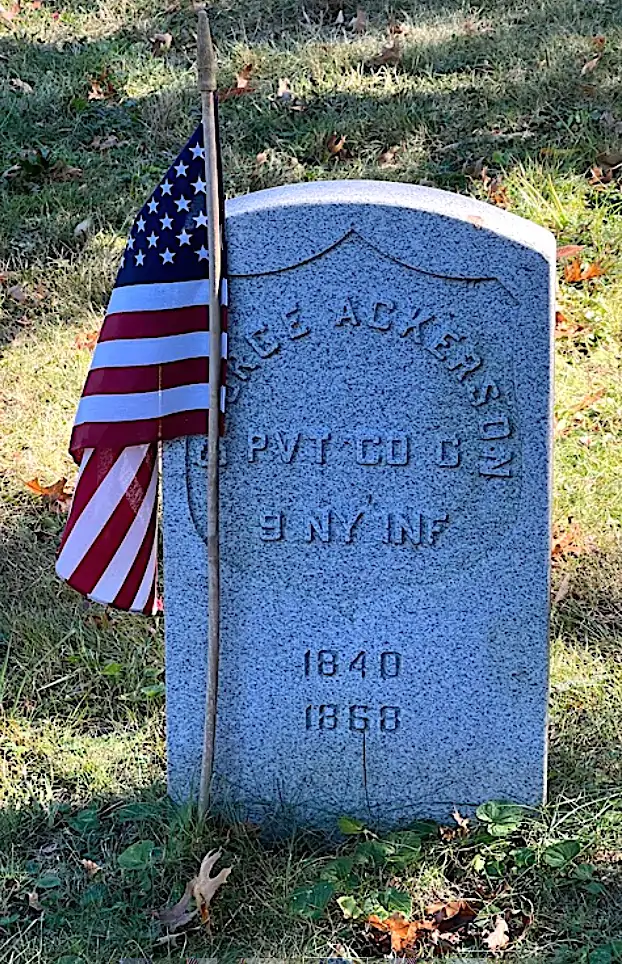
ACKLEY, ANDREW (1842-1905). Second lieutenant, 84th New York (14th Brooklyn) Infantry, Companies H and G. Ackley enlisted as a private at Brooklyn on April 18, 1861, and mustered into Company H of the 14th on May 23. He rose through the ranks to corporal on July 1, 1861, sergeant on March 1, 1862, and second lieutenant on October 24, 1862. On May 29, 1863, he was transferred to Company G and was transferred back to Company H on January 9, 1864.
In 1891, Ackley applied for an invalid pension, application 1,017,469. He last lived at 264 West 22nd Street in Manhattan. His death was caused by pneumonia. Emma Ackley applied for a widow’s pension in 1905, application 820,942. Section 2, lot 5499, grave 2068.
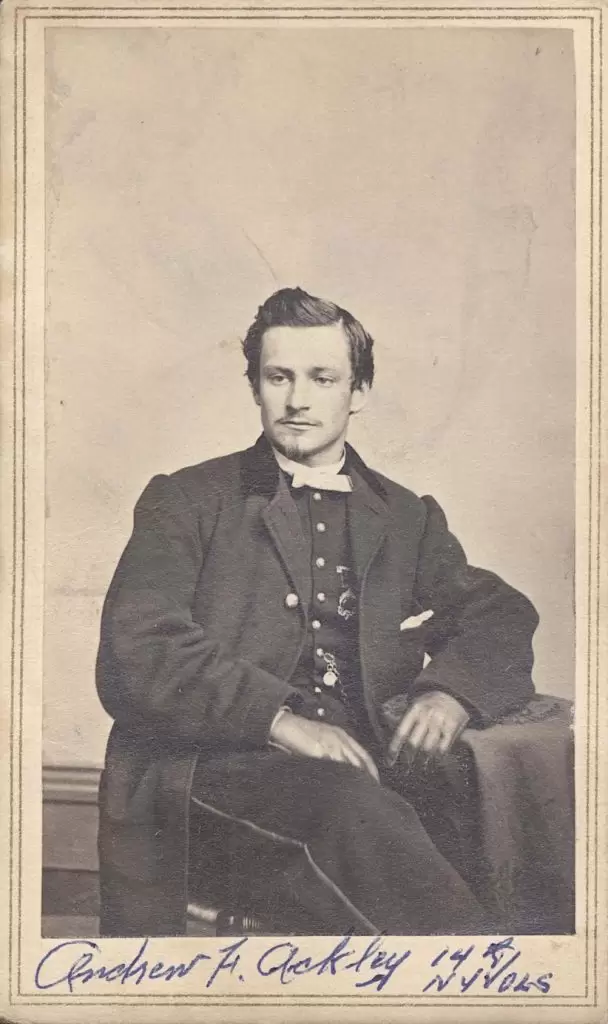
ADAMS, AUSTIN (1843-1922). Private, 7th Regiment, New York State National Guard, Company I. Born and raised in Williamsburg, Brooklyn, Adams graduated from the Polytechnic Institute. During the summer of 1863, he served for 30 days during which time the 7th was called to help suppress the New York City Draft Riots.
In civilian life, he worked with his father in the exporting business, then was in hardware where he tried to invent practical devices. One obituary which validated his service in the 7th Regiment noted that he was a descendant of President John Adams, but there is no other proof to substantiate this claim. His obituary in the New York Evening Telegram also notes that he was a “direct lineal descendant” of John Adams. That obituary noted that he was a Civil War veteran and an inventor. He last lived with his son at 164 Argyle Road in Brooklyn but died from pneumonia as a resident of the Albert Hotel in New York City. Section 23, lot 2194.
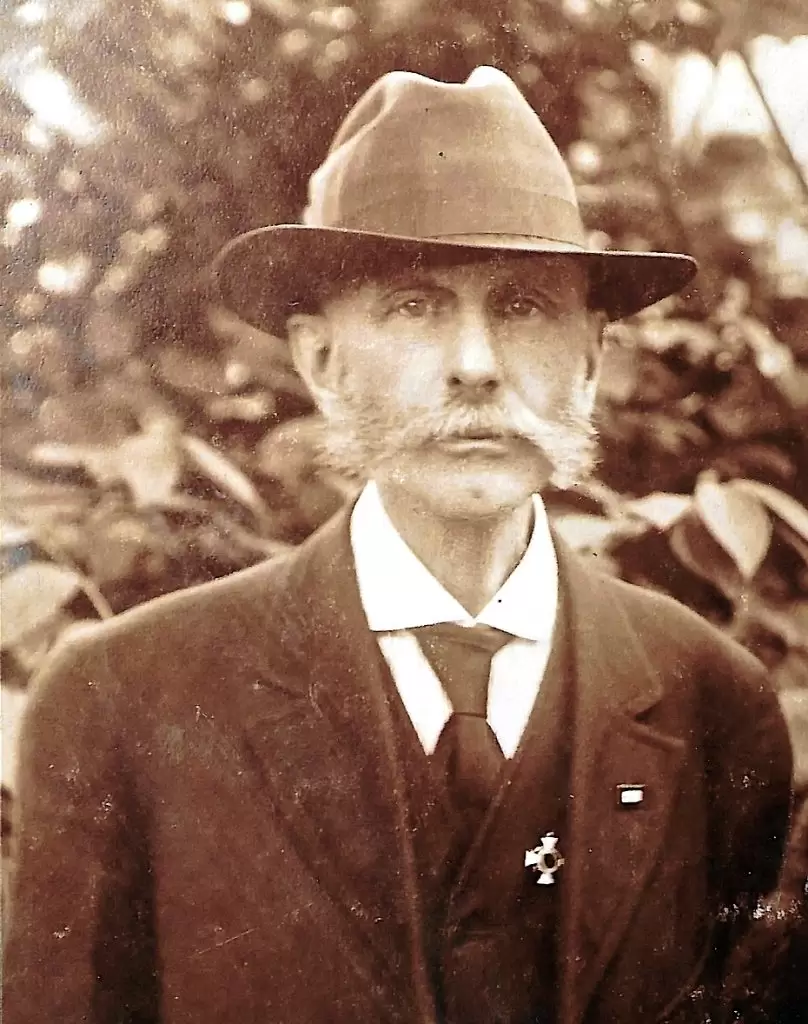
ADAMS, JAMES ERWIN (1839-1919). Captain, 56th Regiment, New York State National Guard, Company I; corporal, 15th Massachusetts Infantry, Company F. Adams was born in Ashford, Connecticut, and was the brother of the John Quincy Adams (see) who was colonel of the 56th Regiment. A shoemaker and resident of Brookfield, Massachusetts, he enlisted as a corporal on July 12, 1861, and mustered immediately in the 15th Massachusetts at Camp Scott in Worchester. Adams was 5′ 9″ tall with blue eyes, brown hair and a light complexion. Wounded at the Battle of Ball’s Bluff, Virginia, on October 21, he suffered a gunshot wound to the scalp and partial paralysis of the left arm. His muster roll of October 31, 1861, indicates that he was hospitalized due to those injuries; his muster roll of December 31, 1861, notes that he was on a 60 day furlough from November 20, 1861 through January 19, 1862. On his February 28, 1862, muster roll, he was listed as sick at Poolesville, Maryland. Adams was discharged for disability on March 8, 1862. His medical records show that he had atrophy and loss of sensibility in his left arm after his injury and that his ability to perform his duties was reduced by one-half. After re-enlisting on July 11, 1864, at Brooklyn, he was commissioned into the 56th Regiment on August 2, and mustered out on November 6, 1864, at New York City.
A merchant in civilian life, Adams was a member of the Ulysses S. Grant Post #327 of the G.A.R. In 1880, his application for an invalid pension was approved, certificate 230,274. The 1910 census recorded that he was employed as a salesman. His obituary in the Brooklyn Standard Union confirms his Civil War service and notes that he lived in Brooklyn for nearly his entire life. He last resided at 2196 Clarendon Road in Brooklyn where he succumbed to heart disease. Adams’s funeral was held at the home of his niece at 1707 Ditmas Avenue in Brooklyn; he was survived by his widow, Hannah Williams Adams. Section 23, lot 2456.
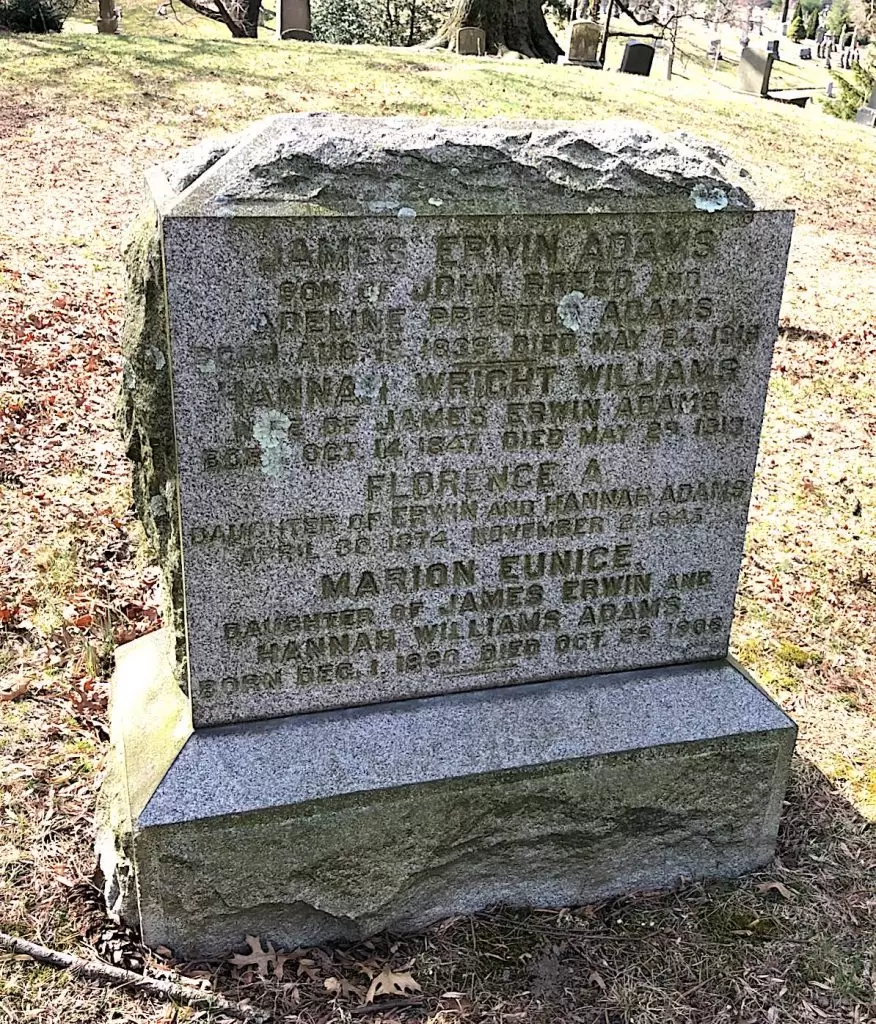
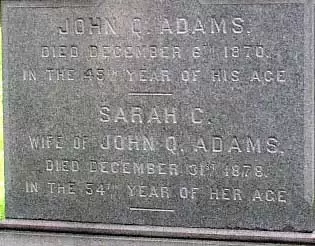
ADAMS, JOHN QUINCY (1826-1870). Colonel, 56th Regiment, New York State National Guard. Born in Ashford, Connecticut, Adams resided in Brooklyn and was a civil lawyer and justice of the 2nd District Court at the outbreak of the Civil War. His father was a soldier in the War of 1812 and participated in the burning of New London, Connecticut.
After serving as a second lieutenant in the 12th New York, Adams was promoted to captain in 1862 and began service in the 56th Regiment, New York State National Guard. He rose to major in July 1862, to lieutenant colonel in March 1863, and to colonel on June 25, 1863, at Harrisburg, Pennsylvania. He engaged in a skirmish at Harrisburg on June 30, 1863, and was in charge of guarding prisoners of war at Elmira, New York, from July 11, 1864-November 4, 1864, before mustering out on November 10.
Two of his brothers also served in the Civil War; James E. Adams (see) of the 15th Massachusetts, who was wounded at Balls Bluff, Virginia, and permanently disabled, and Henry who served in the 16th Connecticut, was captured at Kingston and died in a Confederate prison in Florence, South Carolina, in October 1864. Adams was a member of the Freemasons. In 1868, he was elected the first commander of the Stephen Thatford Post #3 of the Grand Army of the Republic. His last residence was 248 Cumberland Street in New York City. He died from peritonitis. Section 61, lot 12774.
ADAMS, JOSEPH (1836-1910). Corporal, 13th Regiment, New York State Militia, Company C. Originally from Philadelphia, Pennsylvania, Adams enlisted as a private in the 13th at Brooklyn on April 23, 1861, served three months and mustered out at Brooklyn on August 6 of that year. He re-enlisted in 1862 with the 13th, then part of the National Guard, and served as corporal. In 1892, his application for an invalid pension was approved, certificate 992,158. At the time of his death, he was a resident of the Soldiers’ Home in Bath, New York. He died from nephritis. Section 13, lot 8799, grave 1.
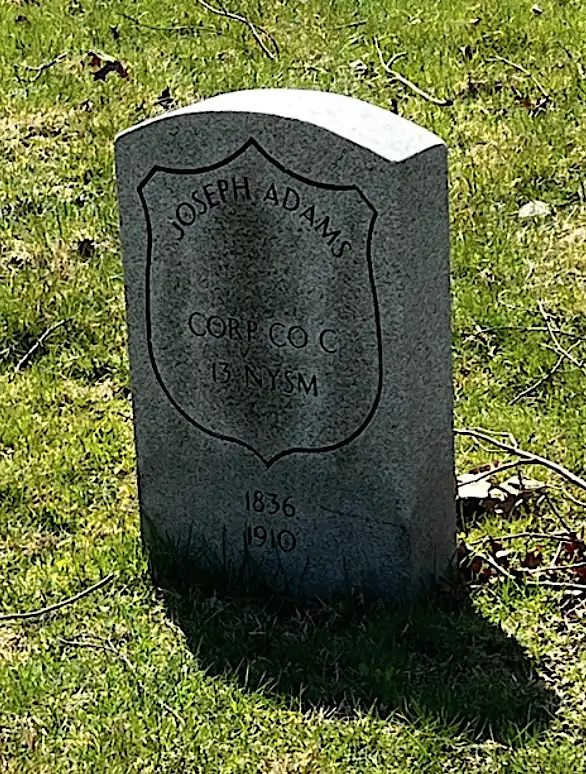
ADAMS, JULIUS WALKER (1812-1899). Colonel, 67th New York Infantry; 178th New York Infantry. Born in Boston, Mass., his mother’s ancestry could be traced to the Mayflower. He attended the United States Military Academy, entering with the class of 1830, but did not graduate. After resigning from the Academy in 1832, he joined his uncle as an assistant engineer on the Paterson and Hudson River Railroad. He worked for many railroads in the 1830s, 40s and 50s, designed Brooklyn’s Second Presbyterian Church, was resident engineer of the United States Dry Docks, served as Indiana State Engineer (1835) and New York City consulting engineer (1850), and designed and built the Brooklyn sewer system (1857-60).
During the Civil War, Adams enlisted on May 14, 1861, at Brooklyn, as colonel of the 67th New York, mustered in on June 24, and served under General McClellan in the Army of the Potomac, rising to command of the 2nd Brigade, 1st Division of the 4th Corps. During the Peninsula Campaign, he commanded the 67th at the Battle of Williamsburg, Virginia, on May 5, 1862. He also led the regiment at the Battle of Fair Oaks, Virginia, where he was wounded. He was discharged for disability on October 19, 1862, and was appointed colonel of the 178th New York Infantry (Second Hawkins Zouaves) the next month. Though he was discharged on June 22, 1863, due to consolidation of the 178th with the Blair Rifles, he commanded the troops that guarded New York City’s Printing House Square during the Draft Riots of July 1863.
Adams was later chief engineer of the city works of Brooklyn, a founder and president of the American Society of Civil Engineers, and wrote Sewers and Drains and The Dictionary of Engineering. Adams was hired by William Kingsley in 1865 to prepare a design and cost estimates for the Brooklyn Bridge. However, though he had previously dabbled in designs for this bridge, and had many influential friends, Adams had never built a bridge of any consequence. His role, it appears, was to come up with a lowball estimate for the cost of the Bridge, allowing its promoters to sell it to the public and public officials. Adams concluded that the Brooklyn Bridge could be built for $5,000,000; ultimately it would be built by the Roeblings for three times that amount. He was the father of Julius W. Adams (see) and Stephen D. Adams (see). His home was at 55 Congress Street in Brooklyn. Section 93, lot 2018, grave 25.
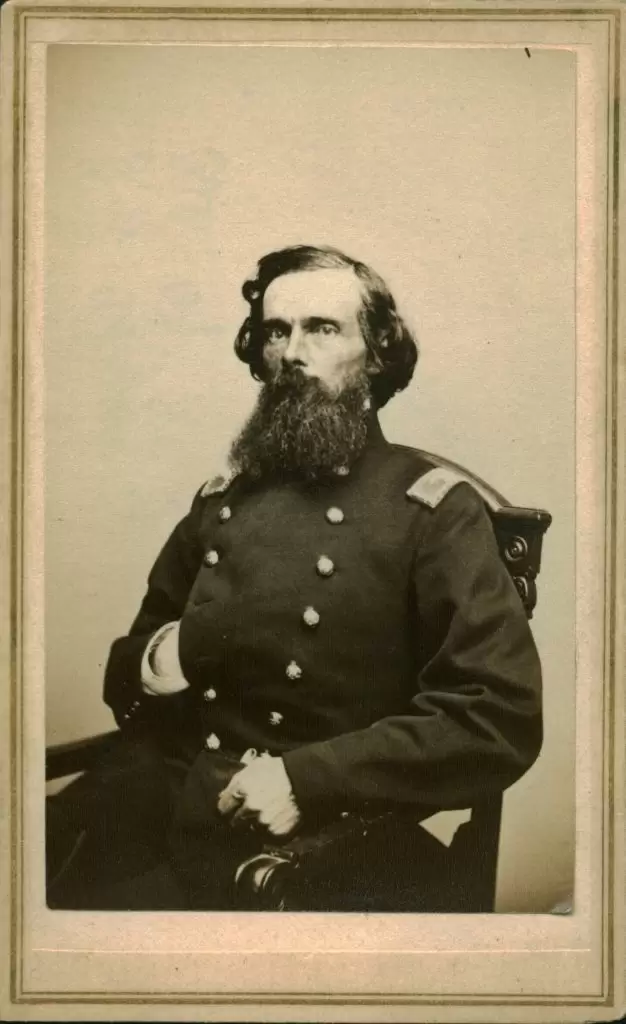
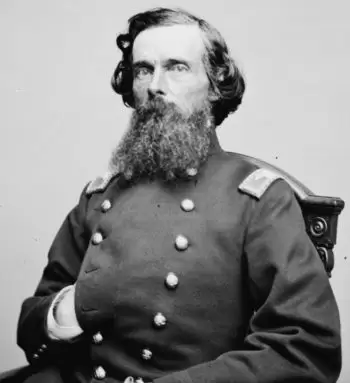
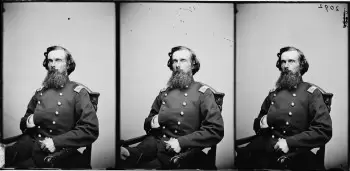
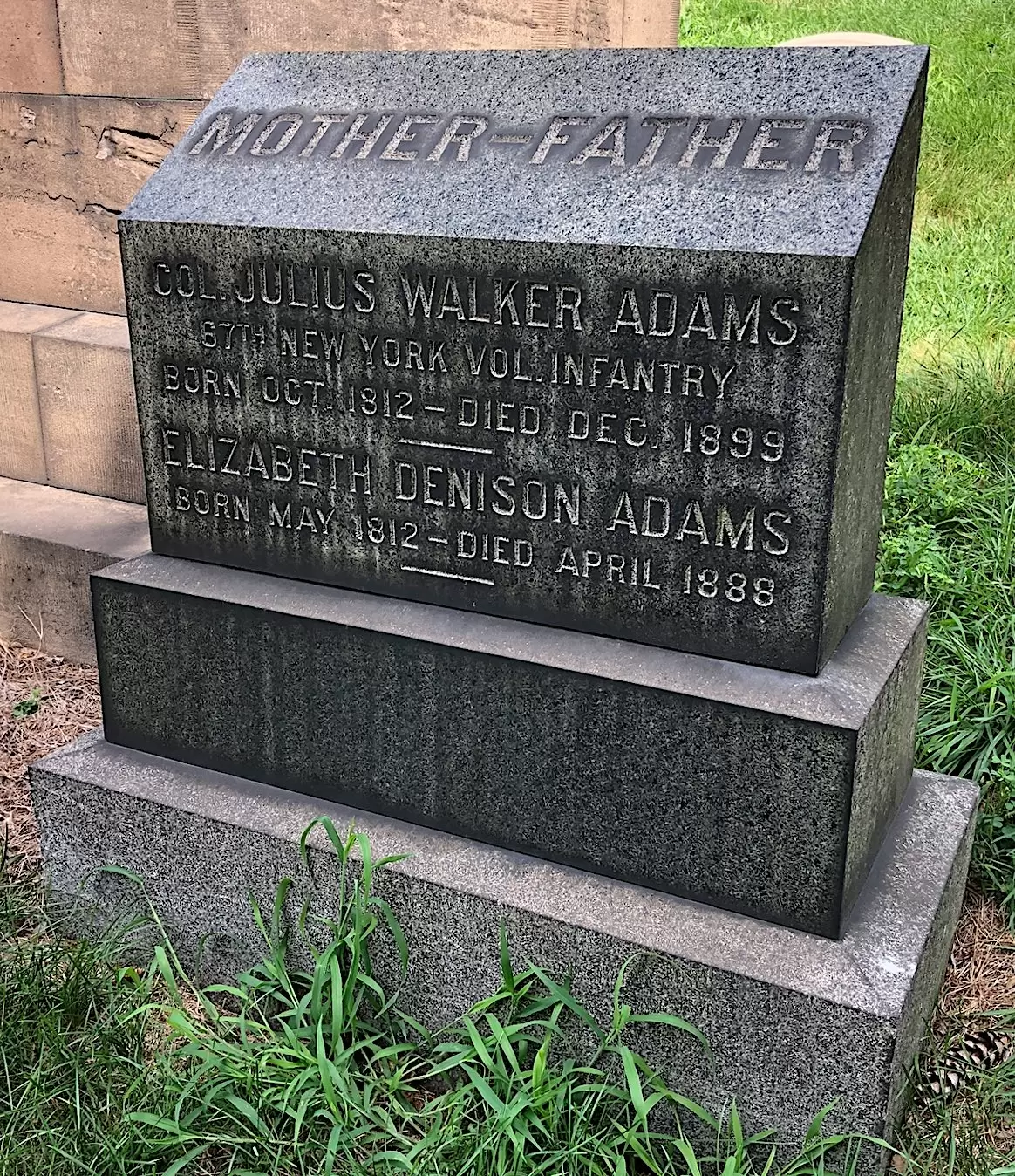
ADAMS, JR., JULIUS W. (1840-1865). Captain, United States Army, 4th Infantry. The son of Julius Walker Adams (see), and brother of Stephen (see), he was born in Massachusetts, graduated from the United States Military Academy in 1861, and enlisted in June of that year as a second lieutenant in the 4th United States Infantry. He served as an assistant instructor of infantry tactics at West Point in 1862. Shortly after being wounded and captured at the Battle of Gaines’ Mill, Virginia, on June 27, 1862, he was promoted to captain on August 9. He later commanded a regiment at the Battle of Gettysburg, Pennsylvania, in July 1863, and was wounded at Cold Harbor, Virginia, a battle that lasted from May 31 to June 12, 1864. He resigned on June 29, 1864. Adams last lived at 112 Schermerhorn Street, Brooklyn. He died from pulmonary phthisis. Section 93, lot 3490.
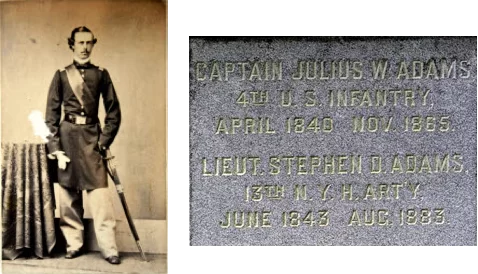
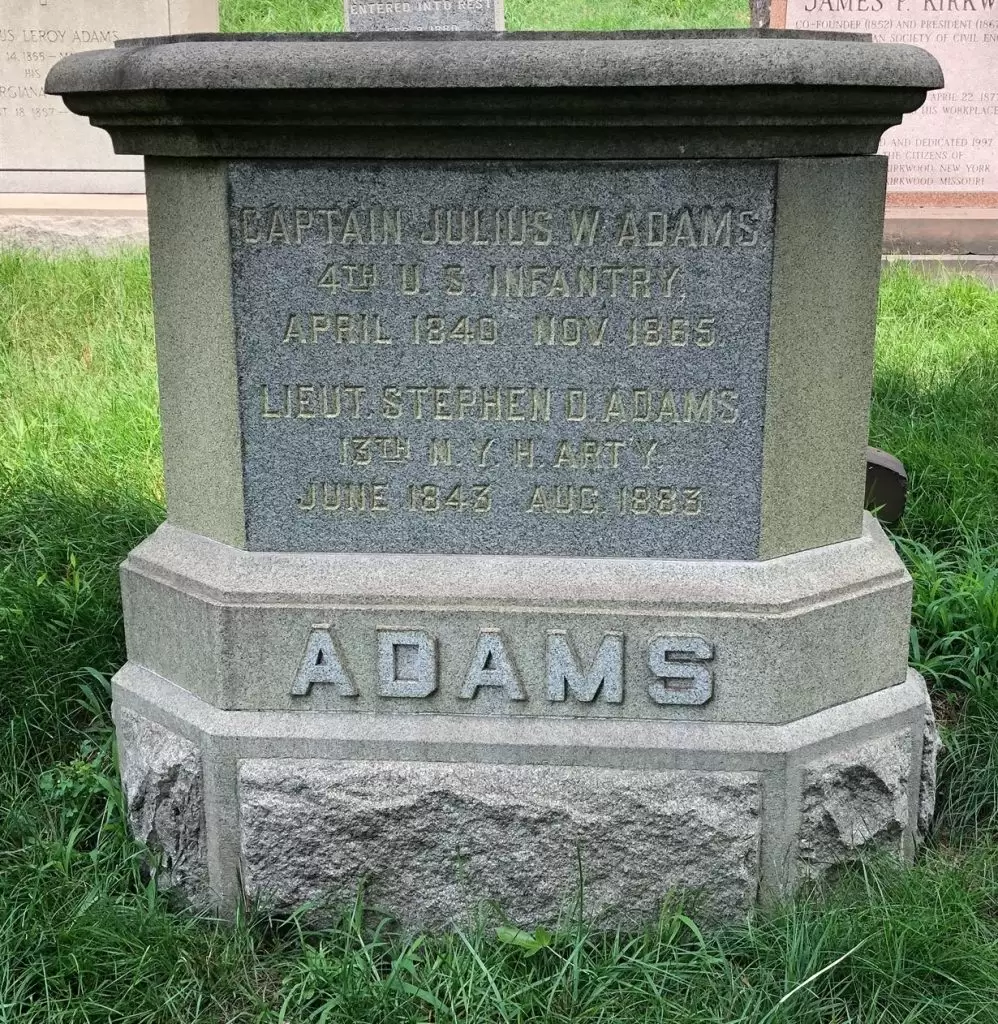
ADAMS, RICHARD A. (1844-1877). Corporal, 16th New York Cavalry, Company L; drummer, 9th New York Infantry, Companies G, C, and D. A New Yorker by birth, Adams served with two New York regiments. On May 3, 1861, he enlisted as a drummer at New York City, and mustered into Company G of the 9th New York Infantry a day later. Adams was transferred to Company C on December 15 of that year, then to Company D on June 6, 1862, and mustered out with his company on May 20, 1863. A few months later, he re-enlisted as a private at Greenburg, New York, on September 3, 1863, and mustered into the 16th New York Cavalry two days later. During his service with the 16th Cavalry, he rose to sergeant on an unknown date, to corporal on September 6, 1863, and was reduced to the rank of private on January 18, 1864. He was listed as confined on March 15, 1865, at Fort Delaware, and deserted on June 15, 1865, at Lincoln Barracks. Adams last resided in Newark, New Jersey. He succumbed to heart disease. Section 103, lot 6998.
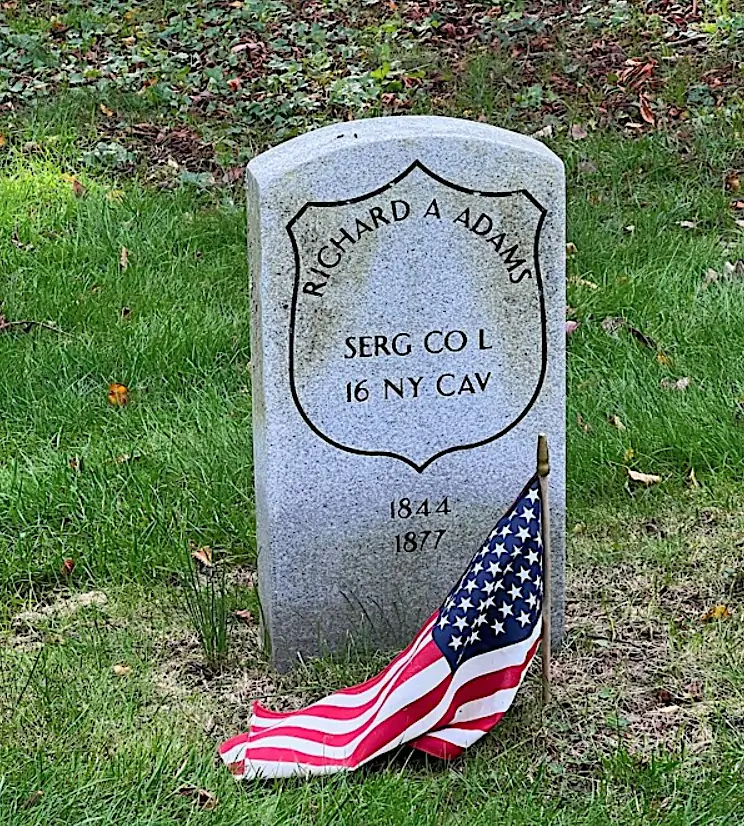
ADAMS, STEPHEN D. (1844-1883). Second lieutenant, 13th New York Heavy Artillery, Company F; 6th New York Heavy Artillery, Company H. The son of Julius W. Adams (see) and brother of Julius W. Adams Jr. (see), he enlisted as a second lieutenant on January 21, 1865, at Norfolk, Virginia, was immediately commissioned into the 13th Heavy Artillery, and was transferred into the 6th New York Heavy Artillery on July 18, 1865. He mustered out on August 24, 1865, at Washington, D.C. Adams last lived at 155 Congress Street in Brooklyn. He died from enteritis. Section 93, lot 2018.
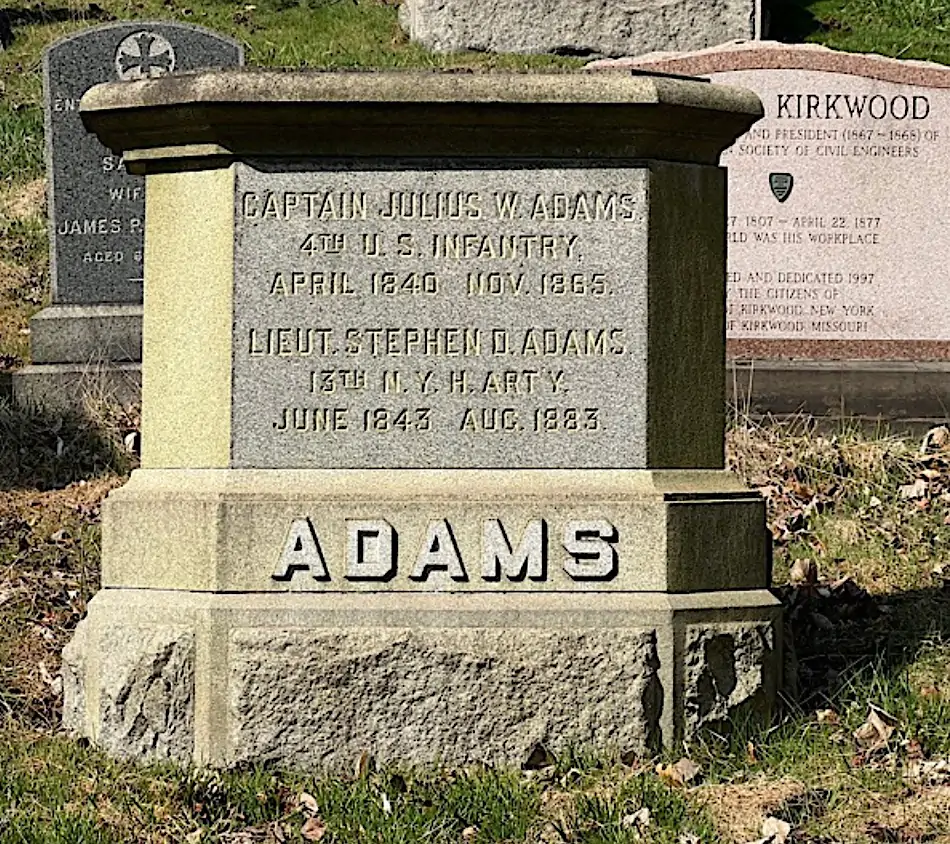
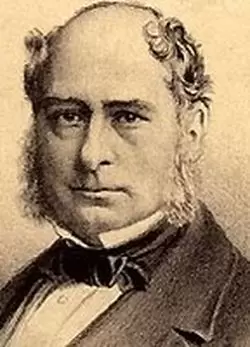
ADAMS, THOMAS (1818-1905). Civil War photographer. A New York City native, Adams was a photographer early in his working life. During the Civil War, he was a government-appointed Civil War photographer assigned to the Army of the Potomac. His equipment was transported in a heavy photographic wagon. Each division of the Army of the Potomac had its own approved “photographist” and Adams was the photographer with Gibbon’s Second Division, (First Corps), both in 1863 and 1865. His name appears on three registers of civilians approved to do business with the Army; these registers are now in the National Archives. In addition, his name appears in the Catalogue of Civil War Photographers, compiled by George F. Witham, as an Army photographer for the Department of the Cumberland. This document is now in the United States Army War College and Carlisle Barracks in Carlisle, Pennsylvania. As per his obituary in The New York Times, he served for three years assisted by his son Thomas; both names appear in the Army registers.
According to his passport application of 1868, Adams was 5′ 11″ tall with a high forehead, blue eyes, gray hair, a florid complexion and a straight nose. In civilian life, he pursued his interest in science. He was intrigued by the rubber industry and experimented with chicle, hoping that it was the key to the vulcanization of rubber. Although that was not the case, he did find a use for chicle, chewing gum, after he popped a piece into his mouth. In 1869, he started the Adams Chewing Gum business when the industry was in its infancy. As per the census of 1880, he was a manufacturer and a confectioner. By 1888, he had a large factory on Sands Street in Brooklyn and was the leading manufacturer of chewing gum in the United States. Among the famous products of the American Chicle Company, which included his own company and other chewing gum companies, were the trademarked “Black Jack” gum (1884) and Chiclets (1899). A popular innovation was the Tutti Frutti machine that Adams installed along the elevated train lines in 1888 and then in the subways in which a penny was inserted and a piece of gum was dispensed. His son Thomas took over the business when he retired in 1898; the factory moved to Newark, New Jersey in 1903. Adams is listed as a retired photographer on the census of 1900. He last lived at 314 Washington Avenue in Brooklyn. He died from pneumonia. Section 139, lot 29432.
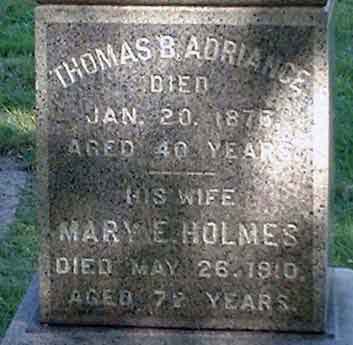
ADRIANCE, THOMAS B. (1837-1876). Corporal, 22nd Regiment, New York State National Guard, Company B. A native New Yorker, he enlisted there on May 28, 1862, and immediately mustered into the 22nd New York. He was listed as absent on furlough on June 13, but returned to service and was discharged on a later date. He was likely the brother of William (see). His last residence was 173 Pacific Street in Jersey City, New Jersey. His death was attributed to typhoid malarial fever. Section 161, lot 8976.
ADRIANCE, WILLIAM J. (1839-1910). Private, 22nd Regiment, New York State National Guard, Company C. After enlisting and mustering into the 22nd Regiment on May 28, 1862, he mustered out after three months on September 5 at New York City. In 1909, Adriance applied for and received an invalid pension, certificate 115,627, as did his widow in 1910, certificate 703,533. He was likely the brother of Thomas (see). He last lived at 42 Hart Street in Brooklyn. He succumbed to nephritis. Section 161, lot 8976.
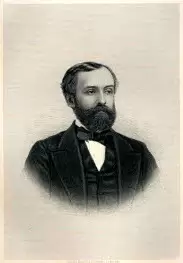
AGNEW, CORNELIUS REA (1830-1888). Medical director, New York State Hospital for Volunteers and an organizer of the United States Sanitary Commission. Born in New York City, Agnew graduated from Columbia College at the age of nineteen in 1849. His father was a prominent tobacco, shipping, and commission merchant building upon the enterprise of Cornelius Agnew’s grandfather. After receiving his M.D. from the College of Physicians and Surgeons in 1852, he interned at New York Hospital, spent a year in the copper mining area of Michigan and was appointed to the staff of the New York Eye and Ear Infirmary. Resuming his studies, Agnew went to Europe to complete his study of diseases of the eye and ear in Dublin, Ireland, and then continued his study of ophthalmology in London and Paris. The pre-eminent specialist of his time, Agnew served as surgeon at the Eye and Ear Infirmary from 1856 through 1864, and was appointed surgeon general of New York in 1858. As per the papers of Frederick Law Olmsted (1871), Agnew served as surgeon general for the New York State Militia throughout the Civil War.
At the onset of the Civil War, Agnew was medical director of the New York State Hospital for Volunteers. He was an organizer of the United States Sanitary Commission, formed during the Civil War and based on a British model during the Crimean War, that provided meals and lodging to furloughed soldiers, improved hygienic conditions in camps (drainage, placement of latrines, water supply, and cooking), and treated the wounded (sending hospital ships and trains to evacuate and treat the injured). Agnew was the youngest member of the Executive Committee of the Sanitary Commission and considered a driving force in the implementation of its goals. Olmsted noted that Agnew was deeply committed to the Sanitary Commission and that Agnew had sailed on the first hospital ship to Virginia to support Union troops during the Peninsula Campaign that began in the spring of 1862. Considering his work on the Sanitary Commission to be of primary importance, Agnew resigned his position at the New York Eye and Ear Infirmary in 1864 to devote himself to assisting the soldiers. According to his obituary in The New York Times, Agnew’s work was instrumental at the Battles of Antietam, Maryland, and Wilderness, Virginia, and in aiding soldiers who returned home from Confederate prisons. According to Frank W. Newell, in his biography of Agnew, Agnew visited President Abraham Lincoln and Generals Joseph Hooker and Ulysses S. Grant in the field.
By 1864, the Sanitary Commission had 7,000 local affiliates throughout the North. Fairs were held to raise money for its work. As a political force, it broke the power of the seniority-controlled Medical Bureau. The Judiciary Square Hospital in Washington, D.C., which became the model for the pavilion system of hospitals, was planned by Agnew and two others. The diarist George Templeton Strong wrote of a meeting that he and Agnew had with Secretary of War Edwin M. Stanton in Washington, D.C., in May 1864 to discuss the Sanitary Commission. Though Stanton was well-informed of its movements and doings, Strong did not like Stanton personally and thought that he was not a “first-rate man morally or intellectually” but was amazed that the secretary of war acknowledged the importance of their organization and its public support. At the aforementioned meeting, President Lincoln came into the room at which time the President and Stanton went into a side room and then Lincoln entered the telegraph office, waiting for dispatches.
On February 12, 1866, in electing Agnew into its ranks, the Pennsylvania Commandery of the Military Order of the Loyal Legion, a patriotic organization of Union officers who had served during the Civil War, cited Agnew’s work as one of the founders of the Sanitary Commission, noting his “practical skill, executive ability, generosity of personal toil, valuable experience as Medical Director, and keen interest in the details of the service, rendered perfectly successful the plans of the Commission, in the relief which it afforded on so vast a scale in their life-saving work on the battle-fields of the war, and the succor which it was able to minister to soldiers returning from Southern prisons.”
Agnew helped to organize the Union League Club (and served as its vice president), the School of Mines at Columbia (1864), the Ophthalmic Clinic at the College of Physicians and Surgeons (1868), the Brooklyn Eye and Ear Hospital (1868), and the Manhattan Eye and Ear Hospital (1869). At the time of his passport application of May 1872, he was 5′ 6″ tall with dark eyes, dark hair, small mouth, straight nose, high forehead, full face and a dark complexion. In addition, he was a manager at the New York State Hospital for the Insane at Poughkeepsie, New York, an author of many articles in medical journals, a popular lecturer, and a professor of diseases of the eye and ear until his death. Appointed by President Chester Arthur as the Indian Commissioner, he visited Indian Territory and returned to New York with a Native American who was nearly blind, treated him at Manhattan Eye and Ear, and sent him home months later with his sight much improved. He was also president of the board of New York City’s public schools, the Medical Society of the State of New York, and the American Ophthalmological Society, and as a member of the Sanitary Reform Association, helped draft health laws for New York City. He last lived at 266 Madison Avenue in Manhattan where he died from an inflammation of the vermiform appendix. The New York Public Library houses 1,200 boxes of Sanitary Commission records. Section 161, lot 28342, grave 10.
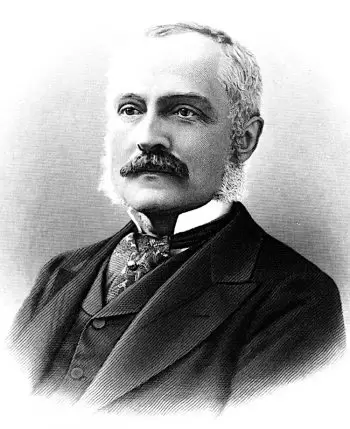
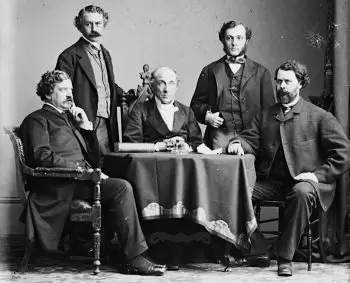
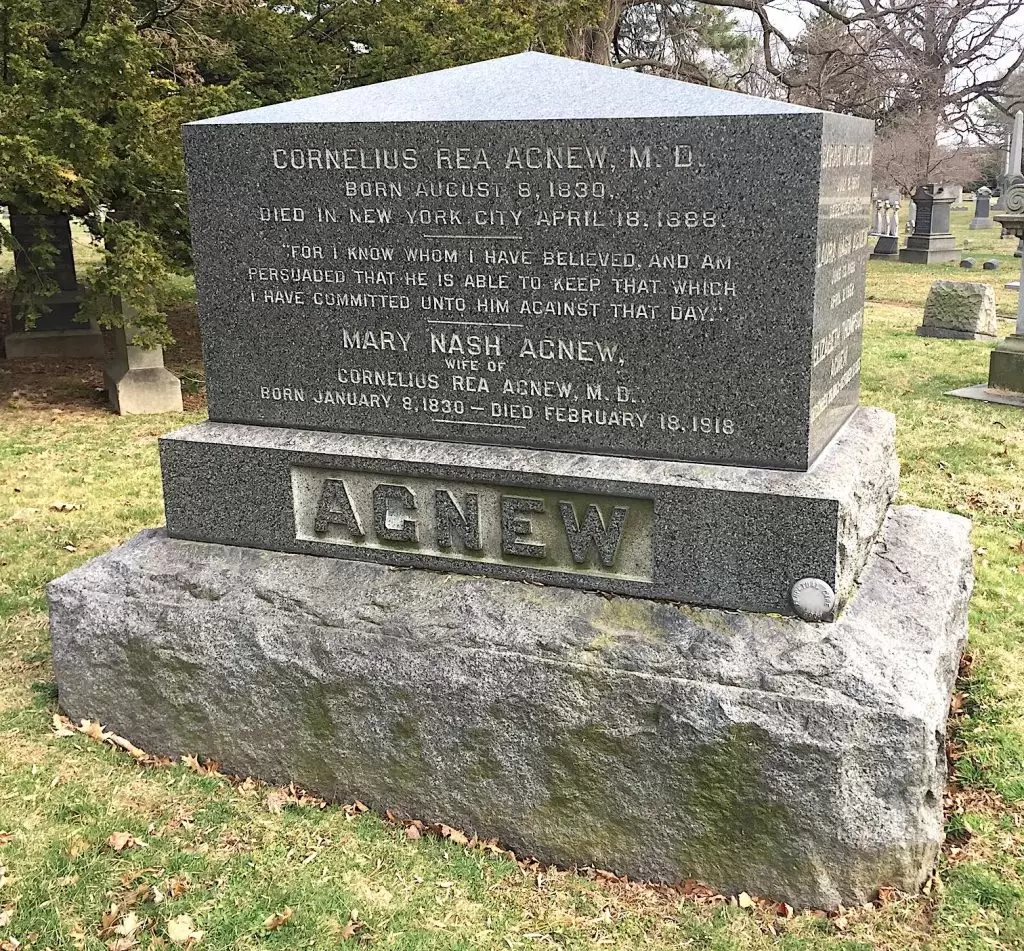
AHEARN, WILLIAM (1835-1899). Private, 38th New York Infantry, Company F; 17th New York Infantry, Company K. A native of New York City, he enlisted there as a private on May 11, 1861, mustered into the 38th on June 3, and was discharged for disability at Convalescent Camp, Virginia, on May 9, 1863. Subsequently, he served in the 17th New York but details of that service are not specified. His last residence was in Far Rockaway, New York. His death was attributed to diabetes. Section 76, lot 2905, grave 11.
AHMUTY, JOHN (enlisted as MOODY, JOHN) (1822-1898). Private, 6th New York Heavy Artillery, Company C; 14th Veteran Reserve Corps, Company F. Under the alias John Moody, he enlisted as a private at West Farms, New York, on August 19, 1862, mustered into the 6th New York Heavy Artillery on September 2, and transferred into the Veteran Reserve Corps on February 3, 1865. In 1882, his application for an invalid pension was granted, certificate 269,645. (His pension application lists him as serving in the 135th New York Infantry but that became the 6th New York Heavy Artillery.) He may have been a relative of William Ahmuty (see). He last lived at 352 Bleecker Street in Manhattan. Ahmuty died from bronchitis. Section 17, lot 17245, grave 916.
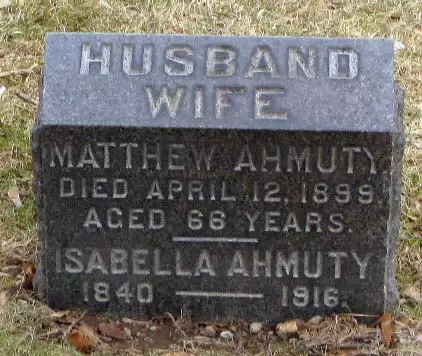
AHMUTY, MATTHEW (1833-1899). First lieutenant, 84th Regiment, New York State National Guard, Company A; sergeant, 11th New York Infantry, Company A. Born in Ireland, Ahmuty served with two New York regiments. He enlisted as a private at New York City on April 20, 1861, mustered into the 11th New York on May 7, was promoted to sergeant on September 1 of that year, and mustered out on June 2, 1862, at New York City. Subsequently, he re-enlisted as a first lieutenant at New York City on July 3, 1863, was commissioned the same day into Company A of the 84th National Guard, and mustered out on August 4, 1863, at New York City. When the 84th was reactivated a year later, he was commissioned into the same company on July 13, 1864, and mustered out on October 29, 1864, at New York City.
Ahmuty successfully applied for an invalid pension in 1890, certificate 775,591. A printer by trade, he last resided at 325 Ninth Avenue in Manhattan. He died from cirrhosis. His remains were moved to the current location on June 24, 1899, two months after his initial interment. Isabella Ahmuty, who is interred with him, applied for and received a widow’s pension in 1899, certificate 480,117. Section 135, lot 30010, grave 641.
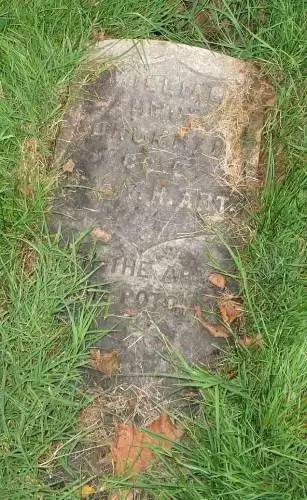
AHMUTY (or AHMITY), WILLIAM (enlisted as MOODY, WILLIAM) (1843-1899). Drummer, 135th New York Infantry, Company C; 6th New York Heavy Artillery, Company C. Using the alias William Moody, he enlisted as a drummer on August 22, 1862, at West Farms, New York, and mustered into the 135th New York’s Company C on September 2. The 135th was reorganized in August 1862 and was converted into an artillery unit that was designated as the 6th New York Heavy Artillery on October 3, 1862. He mustered out on June 28, 1865, at Petersburg, Virginia.
A carpenter by trade, he may have been a relative of John Ahmuty (see). His last address was 235 West 60 Street in Manhattan. The cause of his death was alcoholism. In 1902, Elizabeth Ahmuty, applied for and was granted a widow’s pension, certificate 550,399. William R. Ahmuty, his son, applied to the War Department for a government-issued headstone on October 1, 1936, citing his father’s Civil War service. Section 135, lot 27263, grave 2297.
AHRBERG, HENRY (1828-1915). Private, 1st New Jersey Light Artillery, Battery A. Born in Germany, he enlisted as a private on July 30, 1861, mustered into the 1st New Jersey Light Artillery on August 12, and mustered out on August 18, 1864. He applied for a pension in 1890, application 960,060.
As per his death certificate, he was a general carpenter. His obituary in the Brooklyn Standard Union confirms his Civil War service. Ahrberg last lived at 91st Street and 12th Avenue in Brooklyn where he died from atheroma (arterial plaques). He was survived by his wife and three daughters. Wilhelmina Ahrberg applied for and received a widow’s pension shortly after his death in 1915, application 1,043,518. Section 135, lot 30010, grave 547.
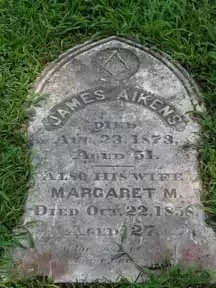
AIKENS (or AIKEN), JAMES (1819-1873). Sergeant, 51st New York Infantry, Companies C and D. A native of Ireland, he enlisted at New York City on August 20, 1861, mustered into Company C of the 51st New York on September 12, transferred to Company D on January 4, 1862, and was discharged for disability at Philadelphia, Pennsylvania, on January 28, 1863. Aikens last resided at 3 Ninth Avenue in Manhattan. He died from tuberculosis. Section 180, lot 13489.
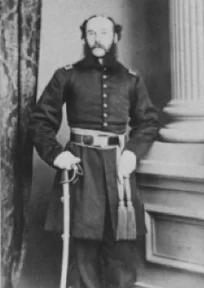
AITKEN (or AIKEN), WILLIAM F. (1832-1885). Captain, 6th New York Cavalry, Companies H, L, and B. Born in London, England, Aitken enlisted as a first lieutenant at New York City on September 15, 1861, and was commissioned into Company H of the 6th New York Cavalry on October 28. On October 26, 1862, he was promoted to captain effective upon his transfer to Company L. He was transferred to Company B on February 9, 1863. Wounded at Spotsylvania Court House, Virginia, on April 30, 1863, and taken as a prisoner of war on that day, he was paroled on May 3, 1863, at City Point, Virginia. After he returned to the field, he was wounded again on October 11, 1863, at Morton’s Ford, Virginia, and then wounded and hospitalized on September 26, 1864. He mustered out at Winchester, Virginia, on December 22, 1864.
In 1869, Aitken applied for an invalid pension, certificate 100,121. In 1870, he was elected second vice president of the Officers’ Association of the Sixth New York Veteran Cavalry. He also served as a Brooklyn alderman. He last lived at 350 State Street in Brooklyn. Section 95, lot 1604.
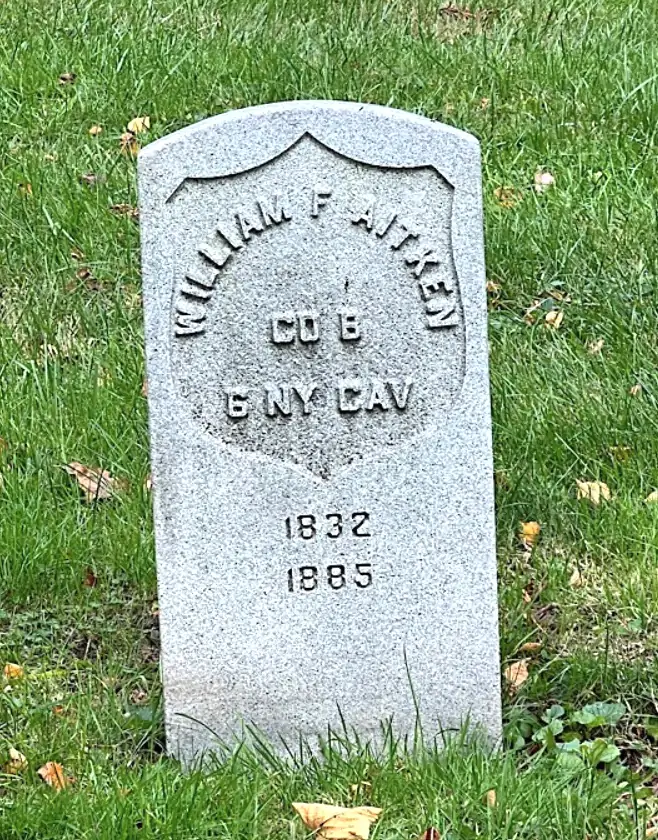
ALDIS, CHARLES JAMES (1846-1874). Second lieutenant, 25th Connecticut Infantry. A New York City native, he was a student at Rutgers College (called Queen’s College until 1825) from 1861-1862. According to school records, he was a second lieutenant in the 25th Connecticut. There are no soldier histories that verify that information or provide additional details. He last lived at 227 West 25th Street in Manhattan. He died from diphtheria. Section 116, lot 4073, grave 715.
ALDRICH, ROBERT (1841-1895). Private, 182nd New York Infantry, Company E. Aldrich enlisted on September 27, 1862, at New York City, mustered into the 182nd on November 17, and mustered out at Washington, D.C., on July 15, 1865. His last residence was 987 Fulton Street, Brooklyn. Aldrich succumbed to a stroke. Section 2, lot 5499, grave 1870.
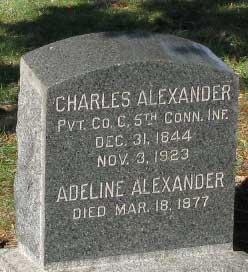
ALEXANDER, CHARLES (1844-1923). Private, 5th Connecticut Infantry, Company G. Born in New York City and a resident of Bridgeport, Connecticut, at the time of his enrollment, he enlisted as a replacement on March 3, 1864, mustered the same day into Company G of the 5th Connecticut Infantry as a private, and mustered out at Alexandria, Virginia, on July 19, 1865. According to his obituary in the Long Islander (Huntington), he lied about his age and pretended to be 18 when he was 16 so that he could go to the frontlines.
After the war, Alexander was a clerk in the New York State Assembly, a foreman for the Street Cleaning Department, and also worked in the New York Assay Office. Active in the Democratic Party, he was member of the Manhattan Post of the G.A.R. and the L. L. Mitchell Post #34 in St. Cloud, Florida. Alexander applied for a pension in 1897, application 1,188,618. For many years a resident of Brooklyn, he moved to Florida for his health late in life and died in Tampa from pneumonia. Section 190, lot 16047.
ALEXANDER, GEORGE (1841-1924). Private, 13th Regiment, New York State National Guard, Company D. A Brooklyn native, Alexander enlisted there as a private on May 28, 1862, mustered immediately into Company D of the 13th Regiment, and mustered out with his company on September 12, 1862, at Brooklyn.
The 1875 New York State census notes that he was a stair builder. Alexander applied for and received an invalid pension in the early 1900s, application 1,323,953. As per the 1920 census, he lived on Dean Street in Brooklyn with his wife, Josephine, and was a house trimmer. He last lived at 487 East 24th Street in Brooklyn but died in Stamford, Connecticut. The cause of his death was hypostatic pneumonia (lung congestion resulting from lying in the same position for long periods). Shortly after his death in 1924, his wife’s application for a widow’s pension was granted, certificate 949,459. Section 20, lot 20944.
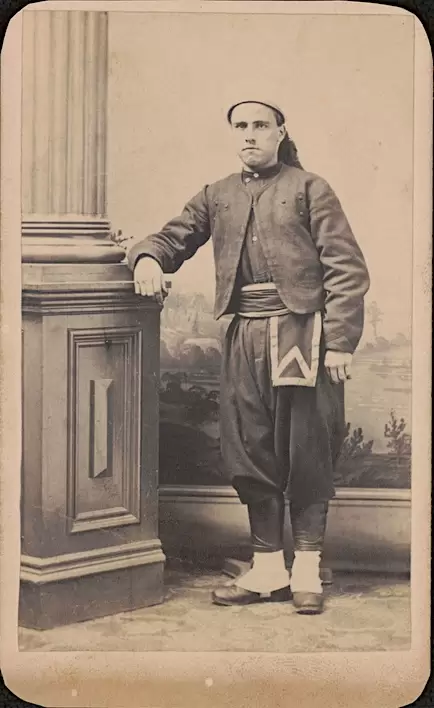
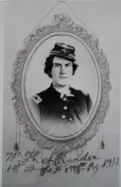
ALEXANDER, JR., WILLIAM H. (1844-1864). First lieutenant, 139th New York Infantry, Companies E and F; corporal, 67th New York Infantry, Company A. Before the Civil War, Alexander lived at 59 Hoyt Street in Brooklyn. After enlisting as a private at Brooklyn on May 1, 1861, he mustered into the 67th New York, also known as the “Phalanx,” on June 20, 1861, possibly as a sergeant, but was reduced to ranks in August of that year. The 67th, under Major General George B. McClellan, fought at Second Bull Run and the battles of the Peninsular Campaign including the Battle of Fair Oaks (also called the Battle of Seven Pines), Virginia, on May 31, 1862, where the regiment suffered heavy losses, both of enlisted men and officers. He was promoted to corporal on June 15, 1862, and was discharged for promotion to second lieutenant of the 139th New York on September 9, 1862. One obituary describes him as having a powerful frame and standing 6′ 2″ tall.
While stationed in Virginia, he married Mary Ann Kelly on March 1, 1863, at Fortress Monroe; they had two sons. The second child, born after Alexander’s death, died in infancy. As per an online biography, he was brought up on court-martial charges in July 1863 for accusing a first lieutenant of “bilking” his servants and never paying them anything. Ultimately, that case was settled and both Alexander and the first lieutenant retained their positions. On December 19, 1863, he became a first lieutenant in Company F. It is likely that his men gave him as a farewell gift a presentation sword, which has survived, when he received the commission.
The 139th, as part of the Army of the James, saw action at Proctor’s Creek, Drewry’s Bluff, and Bermuda Hundred. Although his obituary notes that he was serving as captain when he died, it is unclear if he was ever commissioned in that rank. Alexander was mortally wounded by gunshot at the Battle of Fair Oaks, Virginia (also called the Battle of Boydton Plank Road), on October 29, 1864; after engaging in about twenty battles, he was one of the two men in his regiment who died in that engagement. Among the entries about his death was one from the surgeon who noted, “He had the top of his head cut off by solid shot.”
The lieutenant colonel of the 81st New York, John Raulston, who was the commanding officer at Petersburg, praised him as a “brave and efficient” officer in his field report of that battle. Although one document states that he died at Petersburg, Virginia, on November 7, that is apparently incorrect. His superior officer, Colonel Thomas Mulcahy, wrote that he died instantly after the enemy, aided by dense fog and woods, moved in silently, surprising the fatigued troops:
…Captain Alexander was standing at my left elbow, facing the fire, and saying a word or two to me, when a solid shot hit him over the right eye, cutting half the skull off: he fell on his right side without uttering a word or moan, and died instantly. A pool of blood and braise gushed from his head and his long black hair dabbed in it. I called on Drs. Bart and Brady, who were present, to examine the wound, but it was no use; all was over. The brave fellow, the patriotic, noble Alexander was no more. I ordered his body to the rear to be embalmed at Bermuda Hundred, and sent two non-commissioned officers and four men of his late company to perform that sad duty, who wrapped him in a rubber blanket and carried him off. With the exception of the brave Alexander, our casualties were small.
One obituary published this tribute to those who died in battle:
Glorious in death to those who fall in battle,
Amid the sabres’ clashing and musket rattle:
True to their God, their country, and their cause,
They gave their lives for the Union and the laws.
The regimental commander wrote to his wife, “He was a brave officer and has been with me in every battle in which this regiment has been engaged. He is a great loss to his country, to you, and to me. I was very much attached to him for his many good and manly qualities.” His brother brought home his body, trunk and personal effects, including a sword and crimson silk officer’s sash.
According to one of Alexander’s obituaries, “He was truly loved by the men under his command, for although he was a martinet, yet by his courteous and affable manner he gained and secured their affections.” He was buried at Green-Wood on November 13, 1864. Members of his regiments, who were in New York City, were invited to attend his funeral at the corner of Hoyt and Bergen Streets. His widow, Mary A. Alexander, applied for and received a pension in 1865, application 113,934. He was also survived by his father and one son. In 2020, Alexander’s foot officer’s presentation sword with a silver grip and elaborate etching, dating to 1850, was offered for sale at $8,500, by The Horse Soldier, a store and website specializing in military Americana. The sword’s scabbard, of black leather with brass mounts, was regulation for a lieutenant or captain; the sash was wrapped around the sword. Section 98, lot 10067.
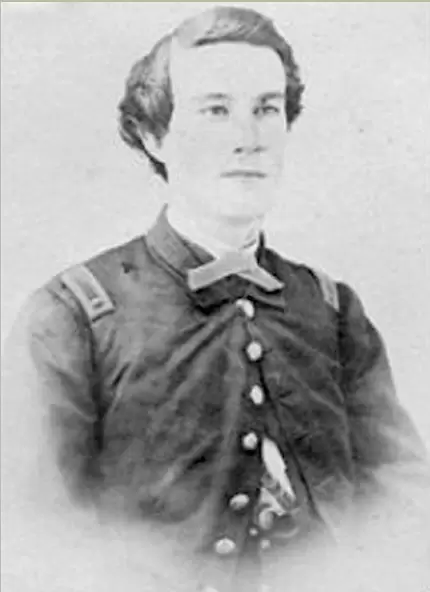
ALFORD, CHARLES, CARROLL (1844-1871). Rank unknown, 22nd New York State National Guard, Company C. Charles C. Alford was born on August 18,1844, to Edwin Madison Alford and Ann Maria Honeywell Alford. Four-year-old Charles was baptized in 1848, according to the Presbyterian Church Records of the Seventh Presbyterian Church, New York City.
By the 1850 federal census, six-year-old Charles lived in New York City with his parents and siblings: Mary Jane Alford Marshall (23), Laura (21), Edwin (13), Thomas (11), John (9), and Ann (4). The Alford household also included: Thomas F. Marshall (25, Mary’s husband), and Theressa Hoffer (22, relationship unknown).
According to the 1860 federal census,16-year-old Charles was still living at home and listed his employment as “errands.” By that time, the family household had expanded to include Charles’s sisters-in-law Frances Alford (22) and Mary Alford (20), his nephew, William (2) and Mary McGovern (relationship unknown).
While the military records found for Charles are scant, The United States Civil War Draft Registration Records of 1863-1865 shows that Alford was single and a clerk. The New York State U.S. Registers of Officers and Enlisted Men Mustered into Federal Service 1861-1865, details that 20-year-old Charles mustered into the 22nd New York State National Guard in August 1864. At the time, he had listed his “trade or occupation” as bookkeeper. We do not have information about his rank or service or when he left, although the war ended in the spring of 1865, so his service was short.
At the time of the 1870 census, Charles and his sister Anna were still living with their parents in New York City; Charles’s occupation was bookkeeper. On June 6, 1870, 26-year-old Charles married Ellen Maria Simpson. Nearly a year later, on May 13,1871, 27-year-old Charles died. Alford’s online family tree lists a daughter, Esther Alford, who died in 1871.
Charles, during his short post-war life, had become active in community-related organizations, as evidenced by listings in his obituary in the New York Herald. The obituary read: “The relatives and friends of the family, Enterprise Lodge No. 228, F and A.M., Eckford Lodge, I.O of O.F., and Company C, Twenty-second regiment, N.Y.S.M., are respectfully invited to attend the funeral, from the Willett Street Methodist Episcopal Church, Willett Street, between Grand and Broome, this (Monday) afternoon, at two o’clock.”
Alford’s lodge published this notice: “Enterprise Lodge No. 228, F and A.M.—The members of Enterprise Lodge No. 228, F and A.M., are hereby summoned to attend an emergent communication at their rooms, Corinthian Room, Odd Fellows’ Hall, on Monday, 15th inst., at twelve o’clock M., to pay the last tribute of respect to the remains of our late worthy brother Secretary, Charles C. Alford.”
The Enterprise Lodge was a local lodge of the Freemasons, and the Eckford Lodge, I.O. of O.F., was the local lodge of the International Order of Odd Fellows. Both were fraternal organizations whose stated goals were to work toward the benefit of their communities. Section 19, lot 5812.
ALLASON, ROBERT F. (1826-1865). Lieutenant colonel, 38th New York Infantry, Company C. A New Yorker by birth, Allason enlisted as a captain on May 7, 1861, at East New York, and was commissioned into the 38th on June 3. He was wounded on July 21, 1861, at Bull Run, Virginia, and was promoted to lieutenant colonel on January 26, 1863, effective upon his intra-regimental transfer to the Field and Staff on February 3. He mustered out on June 22, 1863, at East New York. His last residence was 175 West 50th Street in Manhattan. He died from consumption. Section 188, lot 14967.
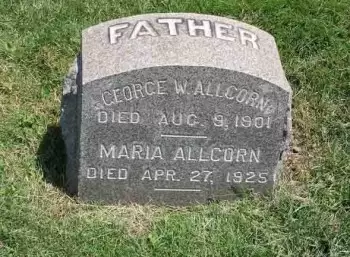
ALLCORN (or ALLCOM, ALCORN), GEORGE (1837-1901). Private, 15th New York Engineers, Company K; 5th New York Heavy Artillery, Company D. Of English birth, he enlisted as a private at New York City on May 25, 1861, mustered into the 15th New York Engineers a month later on June 17, and mustered out on June 25, 1863. After re-enlisting and mustering into the 5th New York Heavy Artillery on March 4, 1864, he was wounded at Piedmont, Virginia, on June 5, 1864, and mustered out on June 13, 1865, at Harpers Ferry, West Virginia.
After the war, Allcorn was employed at the Brooklyn Navy Yard and was a member of the Mansfield Post #35 of the G.A.R. In 1882, he applied for and received an invalid pension, certificate, 331,273. Allcorn last resided on Jefferson Avenue in Brooklyn. He died from tuberculosis. Maria Allcorn applied for and received a widow’s pension shortly after his death in 1901. Section 135, lot 28307, grave 281.
ALLEN, AARON C. (1841–1908). First lieutenant, 22nd Regiment, New York State National Guard, Company B. After enlisting and being commissioned into the 22nd New York on May 28, 1862, Allen, who was born in New Jersey, served for three months and mustered out on September 5 at New York City. A year later, on June 18, 1863, he was commissioned into the same regiment and company and resigned a week later on June 27. In 1890, he applied for and was granted an invalid pension. His last residence was on West 76th Street, Manhattan. The cause of his death was a kidney abscess. In 1909, Mary J. Allen applied for and received a widow’s pension. Section 28, lot 10776.
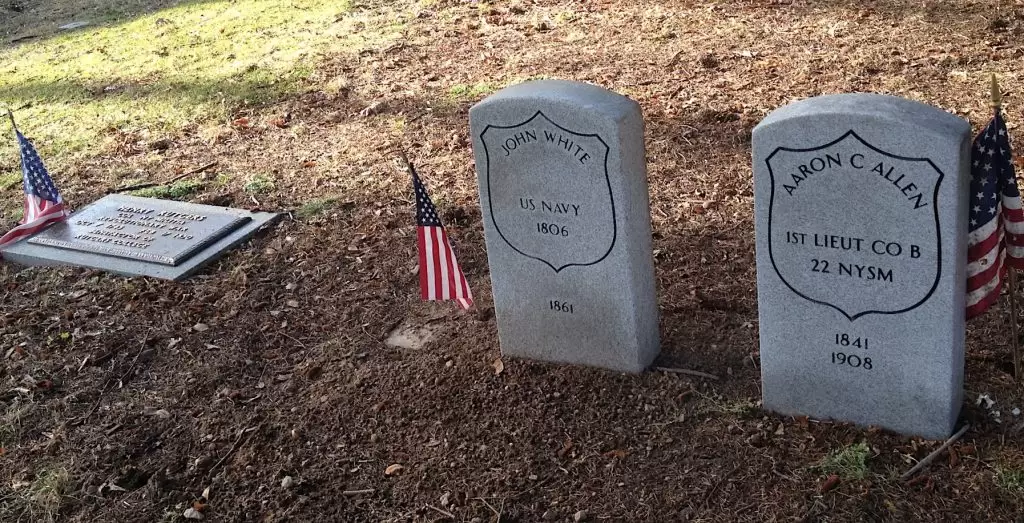
ALLEN, JR., ABRAM (or ABRAHAM) (1839-1931). Corporal, 23rd Regiment, New York State National Guard, Company A. Allen’s birthplace was likely Missouri; the New York State census for 1865 and the 1870 census report that he was born in Missouri and his family had ties to that state. As per his obituary, Allen’s father, who bore the same name, served with the Missouri Volunteers during the Mexican War. During the Civil War, he served for 30 days in 1863 with the 23rd Regiment. According to a descendant, he fought at Gettysburg.
As per the 1865 New York State census , Allen lived in Brooklyn with his parents and siblings and worked as a clerk. The 1870 census shows that he lived in Brooklyn with his parents, worked as a cotton broker, and had a personal estate of $4,000; at the time of the 1875 census, he still lived with his parents and siblings in Brooklyn. On November 9, 1875, Allen married Maria Matilda Demund, the daughter of James H. Demund (see), in Brooklyn; both Allen and his father-in-law were in the cotton business. In 1876, he became a second lieutenant in the 23rd Regiment. The 1880 census shows that he lived in Brooklyn on Pierrepont Street with his wife and parents and worked as a cotton broker. According to his wife’s obituary in the Brooklyn Daily Eagle, Allen, who was still alive, was the last known survivor of the 23rd Regiment; his obituary, which confirms his Civil War service, notes that he was a lieutenant at Gettysburg. He was a member of the Officers and Veterans Association of the 23rd Regiment. Allen last lived on Halsey Street in Brooklyn; he was survived by his son. His funeral took place at St. Bartholomew’s Church on Bedford Avenue in Brooklyn. Section 52, lot 6295.
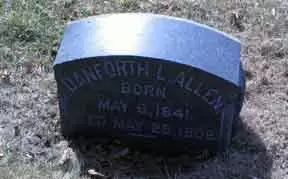
ALLEN, DANFORTH L. (1841-1909). Private, 4th Maine Infantry, Company G; 38th New York Infantry, Company E. Allen, who was born in Maine and resided there in Wiscasset, enlisted as a private on June 15, 1861, the same date that he mustered into the 4th Maine Infantry. On September 21, 1861, he transferred into the 38th New York, returned to the 4th Maine on June 4, 1863, and was discharged on an unknown date. Allen last resided at 11 Louis Place, Brooklyn. He succumbed to bronchitis. Section 6, lot 20118, grave 827.
ALLEN, FREDERICK (1849-1897). Third class apprentice, United States Navy. A native of England, Allen enlisted in the United States Navy on September 3, 1864. He was assigned as a third class apprentice on the USS Sabine as of that date and continued to serve in that capacity until May 31, 1865. He was then served as a first class apprentice on the following vessels: USS Colorado (until August 31, 1867); USS Vermont (until October 24, 1867); USS Sabine (until January 31, 1868); USS Kearsarge (until April 1869); USS Powhatan (until July 1869). Promoted to ordinary seaman, he was discharged on September 24, 1869. He re-enlisted on August 22, 1873, and was honorably discharged on October 4, 1876.
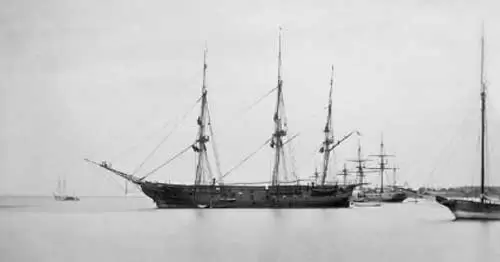
On December 14, 1892, Allen mustered into the Grand Army of the Republic, an organization for veterans of the Civil War. According to the G.A.R. Mortuary Table of 1897, he served as a seaman in the Navy. In civilian life, he was employed as a salesman. His last residence was 286 Court Street in Brooklyn. Allen died from Bright’s disease. In 1897, Henrietta Allen applied for and received a widow’s pension for herself and her three minor children, certificate 12,470. Section 17, lot 17245, grave 75.USS Sabine in Hampton Roads, VA 1864
ALLEN, GEORGE E. (1833-1887). First lieutenant, 83rd New York Infantry, Company I. After enlisting as a sergeant at New York City on July 17, 1861, Allen mustered into Company I of the 83rd New York that same day. He was promoted to second lieutenant on December 21, 1861, then rose to first lieutenant on May 22, 1862. He was wounded at the Battle of Fredericksburg, Virginia, on December 13, 1862, and was discharged for disability on February 28, 1863. Mary Allen applied for and received a widow’s pension in 1887, certificate 352,248. Section 195, lot 25717.
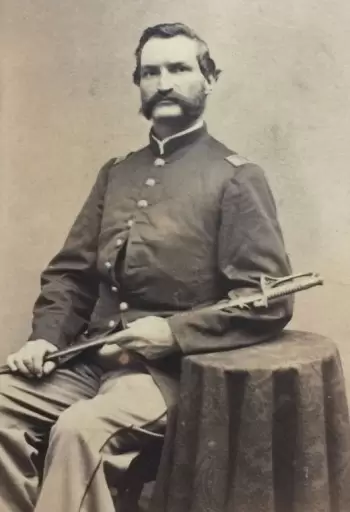
ALLEN, GEORGE O. (enlisted as BROWN, GEORGE W.) (1841-1923). Sergeant, 102nd New York Infantry, Company H; 15th Regiment, New York State National Guard, Company B. After enlisting as a corporal at Brooklyn on December 18, 1861, Allen, a native of New York State, mustered into the 102nd New York that day, rose to sergeant, and mustered out at Washington, D.C., on August 13, 1862. Using the alias George W. Brown, he enlisted as a sergeant on June 6, 1864, mustered into the 15th Regiment, New York State National Guard, Company B, and was honorably discharged on July 7, 1864. He worked as a wheelwright, lived in Jersey City, New Jersey, and spent the last three years of his life at the New Jersey Home for Disabled Soldiers in Kearney, New Jersey. He died from heart disease. Section 67, lot 2270.
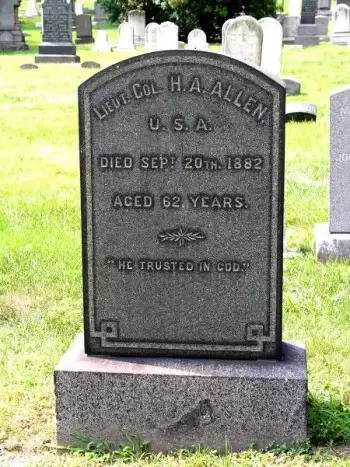
ALLEN, HARVEY ABNER (1820-1882). Major, 2nd United States Artillery, Battery K. Born in North Carolina, he graduated from the United States Military Academy as an artillerist in 1841. After serving as a second lieutenant at the garrisons at Fort Columbus, New York, and Fort Militia, Pennsylvania, he returned to West Point as an Assistant Professor of Mathematics for two years. He then rejoined his regiment in the Mexican War where he fought at numerous battles including Vera Cruz, Cerro Gordo, San Antonio, Churubusco, and Molino Del Ray. Allen was promoted to first lieutenant on March 3, 1847, and was brevetted to captain on September 8, 1847, “for gallant and meritorious conduct in the Battle of Molina Del Ray, Mexico.” He then fought in the Florida Indian Wars from 1853 to 1856, becoming a captain in 1854.
In 1860, while a captain in the 2nd Artillery, Allen commanded Fort Hamilton in Brooklyn. Reporting from Fort Pickens, Florida, on November 25, 1861, Lewis G. Arnold, Major of the 1st United States Artillery, commended Allen for his actions. Arnold wrote of him, “My thanks are especially due to the officers serving with the batteries for the valuable services rendered by them and the cool and efficient manner they commanded their guns…” By early 1863, he was commanding the 2nd United States Artillery, Battery K, in the 19th Corps, District of West Florida. On August 1, 1863, he was promoted to major.
During part of the Civil War, Allen was in charge of Fort Warren in Boston Harbor where some Confederate prisoners were held. In fact, two of the Confederate Naval officers who were imprisoned there are now interred at Green-Wood—Reid Sanders (see), who died at Fort Warren and Leslie King (see). While there, prisoners refused to recognize him or shake his hand upon departure because, with his North Carolina roots, they felt his allegiance should not have been to the Union. (See William Best Hesseltine, Civil War Prisons, 1962, p. 46.) At the close of the War, he was ordered to San Francisco, California, where he commanded the harbor and other defenses in the West.
From June 1867 to July 1868, as a major, Allen commanded American forces facing off against British troops in the Washington territory. In 1871 and 1872, he was the military governor and chief executive of Alaska, which was under War Department jurisdiction. In 1873, he returned to Fort Macon and Raleigh, North Carolina, then was placed in charge of the Washington Arsenal. Made lieutenant colonel of his regiment in 1877, he was stationed at Fort McHenry, Maryland, until his retirement on April 10, 1879. He last lived in Schraalenburgh, New Jersey. His death was attributed to a stroke. His widow, Mary Allen, received a pension under certificate 201,298. Battery Harvey Allen, at Fort Canby State Park on the Columbia River in the state of Washington, which was built 1904-1906, and is named for him, is currently open to visitors. Section 181, lot 12202.
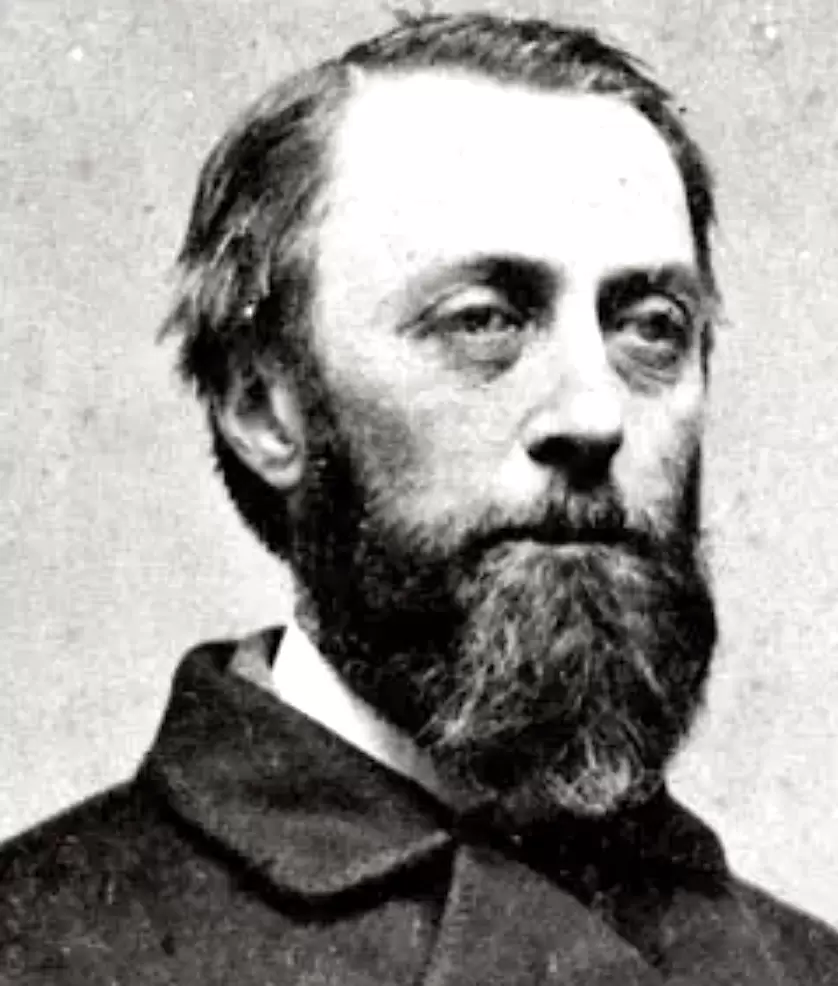
ALLEN, HENRY C. (1838-1905). Major, 106th New York Infantry. Born in New York City to Joseph and Catherine Allen, he lived in his family’s mansion on Washington Square and also grew up in Vermont. A graduate of Williams College in the 1850s, he enlisted as a major on September 8, 1864, was commissioned into the Field and Staff of the 106th New York Infantry on November 14 of that same year, and was discharged from service on December 20, 1864, the same date on which he was promoted to lieutenant colonel (but did not muster at that rank), as per the Report of the New York Adjutant-General 1893-1906. He seems to have had substantial connections: though he only served a month during the Civil War, and started his service as a major, by order of the Headquarters Department of the East, United States Army, dated April 23, 1865, he was named a member of the Guard of Honor detailed to stand near the body of the assassinated President Abraham Lincoln as it was put on view in the City Hall of New York City.
After the war, he became a Democrat and was a prominent criminal defense lawyer in New York City in the 1870s, known for his extraordinary memory. Subsequently, he lost his sight; he was widely known as “the blind lawyer.” One of the lawyers who prosecuted Boss Tweed for corruption, he later served, in the 1880s, as an assistant district attorney in New York County. After he left that position, he was sought out as a consultant on criminal cases. He never married.
According to Green-Wood’s interment records, he last lived at 42 Lexington Avenue in Manhattan. As per his obituary in The Brooklyn Citizen, he died of “diabetic blood poisoning.” Each of his obituaries in local newspapers referred to him as “Colonel Henry C. Allen.” Section 99, lot 14825.
ALLEN, HENRY T. (1845-1881). First lieutenant, 102nd Regiment, New York State National Guard, Company C. Serving in 1864, he enlisted at New York City on August 6, was commissioned into the 102nd National Guard the same day, and mustered out at New York City on November 13. He last lived on Fifth Avenue in Manhattan. He died from Bright’s disease. Section 92, lot 2773.
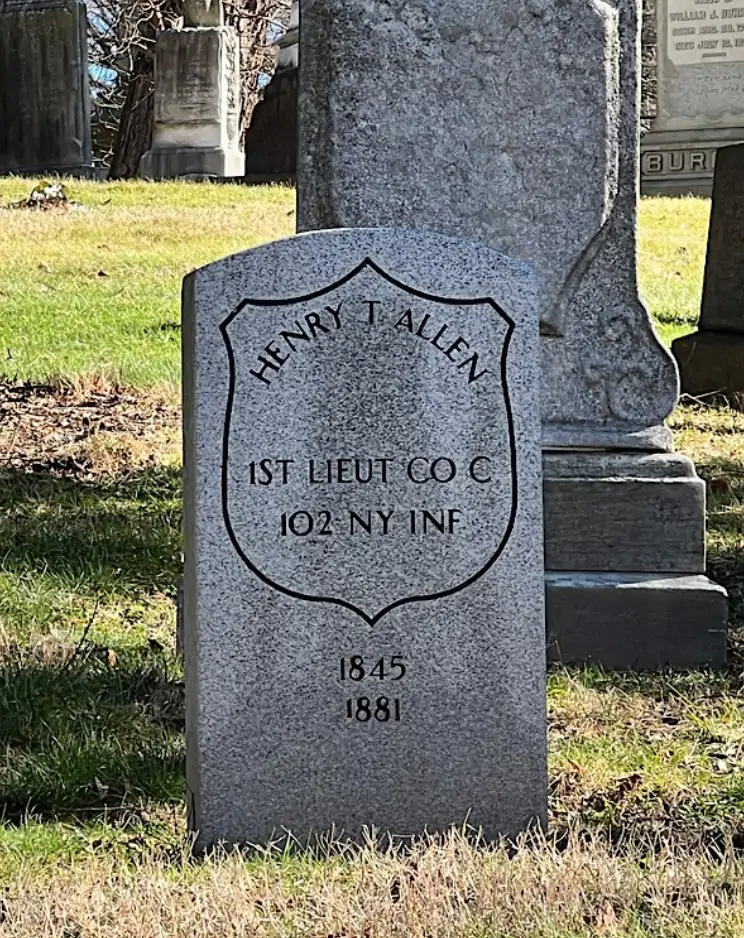
ALLEN, JAMES M. (1831-1902). Surgeon, United States Navy; contract surgeon, United States Army. Originally from Boston, Massachusetts, he graduated from Harvard College in 1849 and Columbia Medical School in 1857. During the Civil War, he first served as a Navy surgeon for about eight months and then was a contract surgeon for the United States Army stationed at Staten Island. Further information is not available. He relocated to Milwaukee, Wisconsin, after the Civil War where he was a county physician for several terms and had a private practice. A linguist, he was conversant in Greek, Latin, French, Spanish, German and Italian. He last lived in Milwaukee. He died from gastritis. Section 10, lot 9954.
ALLEN, JOHN G. (?-1894). Corporal, 1st New York Infantry, Companies H and G. After enlisting as a corporal at New York City on May 7, 1861, he mustered into Company H of the 1st New York that same day, transferred to Company G a day later, was reduced to ranks, and deserted the next month on June 17. Section 181, lot 1118.
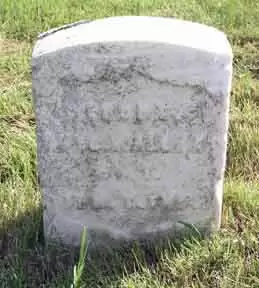
ALLEN, JOHN H. (1835-1898). Corporal, 11th New York Infantry, Company I. Born in New York City, he enlisted there as a private on April 20, 1861. On May 7, he mustered into Company I of the 11th New York and was promoted to corporal of his company that September 1. He was discharged for a disability received in action on an unspecified date.
According to the 1870 census, Allen was employed as a coachman. In 1880, the census listed his occupation as truck driver. In 1891, he applied for an invalid pension that was granted under certificate 996,257. His last residence was 58 Sullivan Street in Manhattan. Allen’s cause of death was cancer of the rectum. After his death in 1898, Charlotte M. Allen applied for and was granted a widow’s pension, certificate 476,766. Section 134, lot 29725, grave 310.
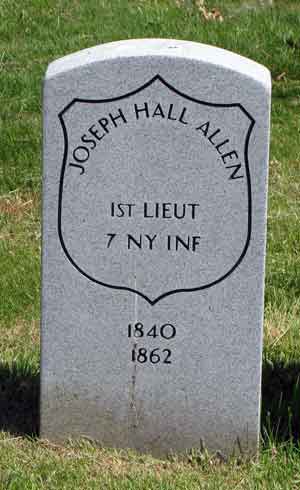
ALLEN (or ALLAN), JOSEPH HALL (1840-1862). First lieutenant, 7th New York Infantry, Companies I, D, and F. After enlisting as a second lieutenant at New York City on April 23, 1861, he was commissioned that day into Company I of the 7th New York. He was transferred to Company D on November 1, 1861, promoted to first lieutenant on January 17, 1862, and transferred to Company F four days later. His regiment fought in battles in Richmond, Virginia, and although unhurt, he contracted typhoid fever. Allen resigned from service on July 20, 1862, and succumbed to his illness at his Brooklyn home on August 10. He last lived on Suydam Street in Brooklyn. His obituary notes that his remains were interred at Green-Wood in an area set apart for deceased volunteers. On April 17, 1880, he was re-interred. Section 141, lot 23123.
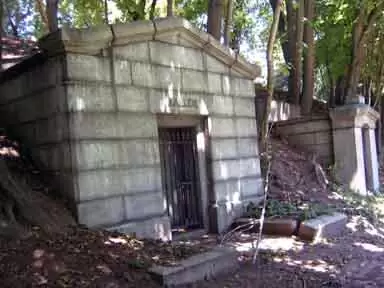
ALLEN, JOSEPH N. (1843-1890). Second lieutenant, 3rd United States Colored Troops, Company G; quartermaster sergeant, 5th New York Veteran Infantry, Company A; sergeant, 13th Michigan Infantry, Company G; private 2nd Michigan Infantry, Company I. Born in Michigan, he was a printer there in Kalamazoo County. After enlisting at Kalamazoo on April 22, 1861, he mustered into the 2nd Michigan on May 25, and was discharged for disability on November 21, 1861, at Fort Lyon, Virginia. He re-enlisted at Kalamazoo as a sergeant on January 13, 1862, mustered into the 13th Michigan four days later, and was discharged for disability on January 17, 1863, at Louisville, Kentucky.
Allen re-enlisted on July 13, 1863, at Buffalo, New York, mustered into the 5th New York Veteran Infantry as a sergeant on August 28, and was promoted to quartermaster sergeant on October 26 of that year. Captured on June 2, 1864, at Bethesda Church, Virginia, he was imprisoned at Andersonville, Georgia. In a letter to his cousin on August 28, he worried that he’d never get paroled and wrote of the horrendous conditions, “…The things were very much needed by both of us. We were entirely destitute of all clothing. I can use the drawers as pants and the shirt is good enough for a coat, during warm weather, I have not seen soap before since I was captured. If you could send some pepper red or black (ground), ginger, soda, and a few such articles, also a frying pan, 2 tin cups, plates & two knives, forks, spoons, a tin box 6 x 8 in[ches] with a cover, a needle or two with thread, a piece of camphor gum, a few onions & potatoes (I have the scurvy), a loaf or two of bread, never mind if they get hard as rocks before I get them, a bar of soap, a three quart pail or pot (we do our own cooking the rations are issued raw & I want the things to cook with . . .”
Subsequently transferred to the prison at Florence, South Carolina, Allen was paroled in December 1864, and hospitalized at Annapolis, Maryland, for treatment of chronic diarrhea, scurvy, and joint problems. On December 5, 1864, he was reduced to ranks, then served as a second lieutenant in the 3rd United States Colored Troops (USCT) in May 1865, and was discharged on June 15, 1865.
After the Civil War, Allen returned to his job as a compositor, lived in Kalamazoo and Chicago before moving to New York City in 1868 and to Brooklyn in 1878. As per the 1875-1876 New York City Directory, he was a printer who lived at 913 Second Avenue in Manhattan. In 1889, he applied for and was granted an invalid pension, certificate 446,086. His widow, Jeannette Allen, received a pension in 1891, certificate 311,262. Her assertion that his suicide by inhaling chloroform was because of “temporary insanity” led to controversy after his death was investigated by the Pension Bureau. Although he took chloroform to ease his joint pain, he apparently led a double life, pretending to be a widower and was engaged to another woman. Ultimately, the ruling by the special examiner was in his wife’s favor- that Allen’s death was due to his wartime debilities. His name is displayed on the African American Civil War Memorial in Washington, D.C., plaque A-8. Allen last lived at 61 Hicks Street in Brooklyn, where he took his life. Section 99, lot 14825.
ALLEN, MARTIN L. (1830-1912). First lieutenant, 67th New York Infantry, Companies B, D, and I. Of Swedish birth, he enlisted as a first sergeant at Brooklyn on June 13, 1861, and mustered into Company B on June 20. Promoted to the rank of sergeant major on October 1, 1861, and transferred to Field and Staff on November 1, 1861, he was reduced to the rank of private the next month on December 1, and transferred on that date to Company D. On January 8, 1862, he was promoted to sergeant major and attained the rank of second lieutenant on June 1, 1862, when he received another intra-regimental transfer to Company I until October 19, 1862, when he rejoined Company B. He rejoined Company I on November 21, 1862, and was promoted to first lieutenant on December 25, 1862. His service career reached an ignominious end when he was cashiered out on April 18, 1863. He died of senility at the Sailors’ Residence at Snug Harbor, Staten Island. Section 13, lot 19694, grave 90.
ALLEN, THEODORE (1839-1872). First lieutenant, 25th New York Infantry, Company D. After enlisting at New York City as a second lieutenant on May 11, 1861, he was commissioned into the 25th New York on June 14, 1861. He was promoted to first lieutenant on June 20, and resigned August 2 of that year. He lived in New York City at the time of his death from tuberculosis. Section 122, lot 17806, grave 272.
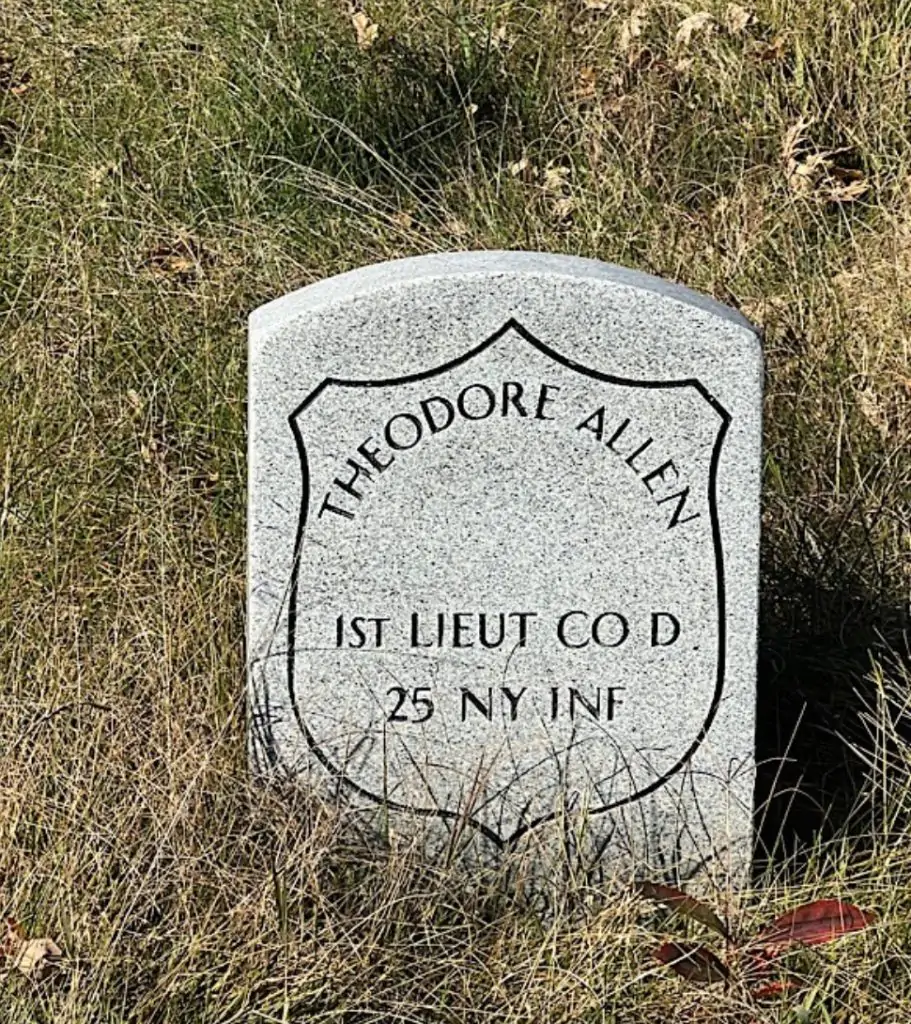
ALLEN, THOMAS WELLAN (1838-1872). Private, 5th New York Infantry, Company E, 146th New York Infantry, Company E. A native of New York, the 1850 census reports that Allen was attending school and lived in New York City with his parents and five younger siblings. That census and his soldier record suggest a birth year of 1838 but the 1860 census suggests 1836 and the Green-Wood database indicates 1834. As per the 1855 New York State census, he continued to live at home and his family had added a seventh child. The 1860 census shows that he was married with an infant, living with his wife and child in New York City and working as a plasterer; that census indicates that his personal estate was valued at $200.
During the Civil War, Allen enlisted as a private at New York City on August 14, 1862. As per his muster roll, he was a carman who had gray eyes, brown hair and a light complexion. On May 4, 1863, he was transferred to Company E of the 146th New York from which he was discharged for disability on March 10, 1864. He last lived at 537 Fifth Avenue in Brooklyn. His death was attributed to phthisis. Section 17, lot 17245, grave 471.
ALLEN, WILLARD (or WILLIARD) T. (1843-1897). Corporal, 27th New York Infantry, Company B; private, 9th New York Heavy Artillery, Company D; 2nd New York Heavy Artillery, Company M. A New York native, Allen was a farmer in Lyons, New York, who lived with his mother and four younger siblings, according to the 1860 census. After enlisting as a corporal on May 2, 1861, at Albion, New York, Allen mustered into Company B of the 27th New York on May 21. He mustered out with his company at Elmira, New York, on May 31, 1863. He re-enlisted as a private at Lyons, New York, on January 1, 1864, and mustered into Company D of the 9th Heavy Artillery three days later. On June 27, 1865, Allen was transferred into Company M of the 2nd New York Heavy Artillery, was listed as absent and sick on August 15, 1865, and was discharged on an unstated date. His muster roll notes that he was a veteran and that he was absent and sick when his company mustered out.
The 1880 census indicates that Allen was married, living in Brooklyn, and working in a store as a clerk. In 1887, his application for an invalid pension was granted, certificate 852,944. He last lived in Patchogue, New York. He died in Brooklyn from asphyxia. Shortly after his death, Emily Allen, who is interred with him, applied for and received a widow’s pension, certificate 466,606. Section 69, lot 11811, grave 8.
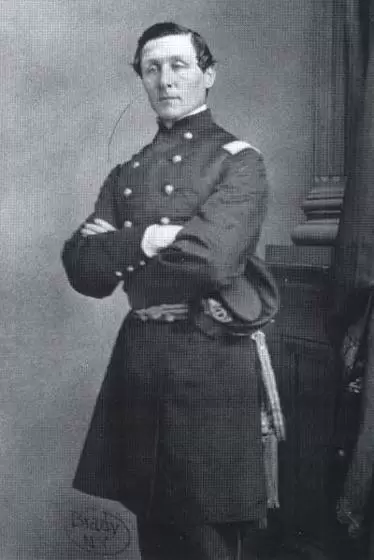
ALLEN, WILLIAM H. (1821-1867). Colonel, 1st New York Infantry. A civil engineer from Ireland who constructed bridges, William Allen joined the 1st New York Infantry as colonel in the early days of the War, enlisting at New York City on May 7, 1861, the same day he was commissioned in. He served at Fortress Monroe and at the Battle of Big Bethel, Virginia. After an incident in which his men burned a wheat field, he was court-martialed (the first Union officer to be tried) and cashiered on September 10, 1861, for disobeying orders and “maliciously causing private property to be destroyed.” In his field report of July 3, 1861, from Fort Monroe, Virginia, Major General Benjamin Butler wrote of that occurrence, “… I caused him to be arrested and held for trial. I have caused enlisted men to be punished for the destruction of private property, and I believe this act of Colonel Allen was a most unnecessary, not to say wanton, destruction and waste.”
In 1862, Allen was commissioned colonel of the 145th New York Infantry on September 11, after being authorized by special order of President Lincoln to raise a regiment but his appointment was canceled that November when the secretary of war detailed a new colonel to command the regiment. He served as an aide during the Draft Riots in New York City in 1863. Allen is listed on the roll of honor in William Swinton’s History of the Seventh Regiment (1876), as a veteran of the 7th’s Company B; this service may have occurred before the Civil War. Following the War, Allen worked as a pension claims agent. He died in Washington, D.C., from ulceration of the lungs. His stone has the inscription, “William H. Gallagher.” Section 94, lot 10875.
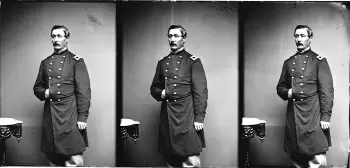
ALLEN, WILLIAM HENRY (1843-1909). Corporal, 7th Regiment, New York State National Guard, Company C. Allen served for 30 days with the 7th Regiment when it was activated in 1863. He successfully applied for an invalid pension in 1906, certificate 1,128,668. He last lived at 1301 Dean Street in Brooklyn. He died from nephritis. In 1910, Maria Allen applied for and received a widow’s pension, certificate 704,102. Section 95, lot 6473.
ALLIEN, HENRY V. (1814-1889). Civil War uniform supplier. Born in New York, his father was a French naval officer who served on Napoleon’s ill-fated Haiti expedition in 1802, then moved to New York City. A merchant and silk importer, he joined his father’s business in New York City in 1850, then became affiliated with Horstmann Bros. & Allien, an outfitter which supplied uniform buttons, shoulder epaulettes and other uniform regalia. He operated the manufacturing plant in New York City, an arm of the main branch in Philadelphia, Pennsylvania.
He became the president of the company in 1877, after which it bore his name, Henry V. Allien & Co. The company’s buttons and trim were on the uniforms of both Union and Confederate soldiers and are still of interest to many Civil War collectors and re-enactors. Buttons were also used in games and leisure activities as exemplified by a button that was pounded flat bearing the Horstmann & Allien name that was used as a poker chip. The New York City Directories for 1875 and 1876-1878 note that he dealt in military goods and accessories at 7 Bond Street.
Henry Allien was a member of the Light Guard, the Geographic Society, the Volunteer Fire Brigade and the Society for the Prevention of Cruelty to Children. His last residence was 27 West 17th Street in Manhattan where he succumbed to acute uremia. As per his obituary in the New York Herald, his funeral took place at the Church of St. Vincent de Paul at 23rd Street near 6th Avenue in Manhattan.
The Allien Company, last located at 734 Broadway in Manhattan, supplied military regalia and army equipment from 1877 through the end of World War II. When an Arkansas Civil War button bearing the company’s mark was shown on The Antiques Roadshow television program in 2008 (episode 1318), it was valued at over $5,000 because of the rarity of that state’s button from a Northern manufacturer. Section 42, lot 9789.
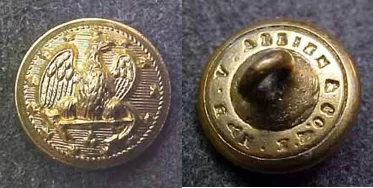
ALLIEN, JULIEN (or JULIAN, JULIUS) E. (1843-1915). Second lieutenant, 83rd New York Infantry, Companies D and I. Allien, who was born in New York City, enlisted there as a private on May 27, 1861. He immediately mustered into Company D of the 83rd New York, was promoted to corporal at some point, rose to second lieutenant on May 22, 1862, effective upon his transfer that day to Company I, and was discharged on October 10 of that year.
Allien’s affiliation with 83rd Regiment (also called the 9th Militia or Ninth Infantry National Guard) was noted in his obituary in the New York Herald. His last address was 245 West 126th Street in Manhattan. His death was attributed to nephritis. He was survived by his wife, Bessie S. Brady. Section 94, lot 1188.
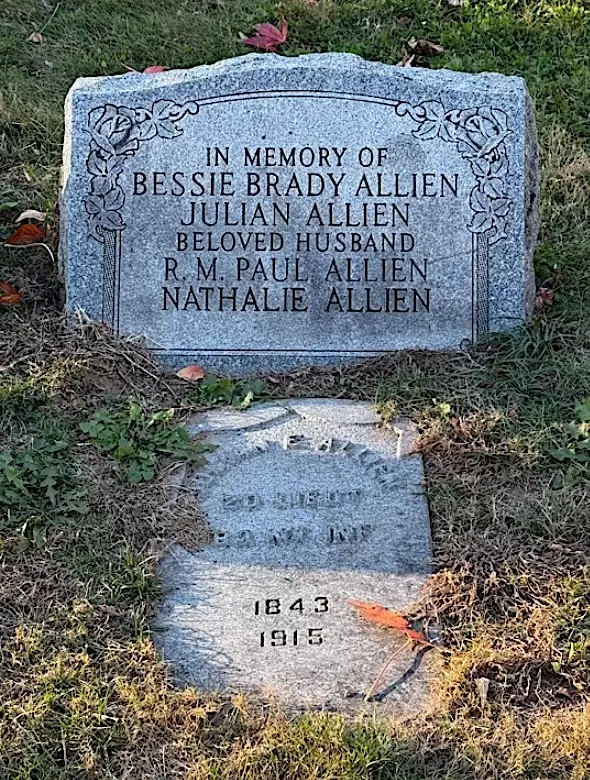
ALLISON, WILLIAM (1836-1869). Private 7th Regiment, New York State Militia, Company B. A native of New York State, Allison enlisted as a private on April 19, 1861, at New York City, and mustered into the 7th Regiment for 30 days. When his regiment was reactivated in 1862, he re-enlisted and returned to the same regiment and company for a three-month tour of duty. His last residence was 58 King Street, New York City. His cause of death was listed as mania-a-potu, or madness from drinking. Section 53, lot 3380.
ALLWOOD, JOSEPH S. D. (1843-1874). First sergeant, 124th New York Infantry, Company I. A native of Cornwall, New York, and a painter by trade, Allwood enlisted as a corporal at Newburgh, New York, on August 20, 1862, and mustered into the 124th New York on September 5. As per his muster roll, he was 5′ 6″ tall with dark eyes, brown hair and a light complexion. He was promoted to sergeant on November 1, 1863, to first sergeant on December 1, 1864, and mustered out on June 3, 1865, at Washington, D.C.
The 1871 Newburgh New York City Directory and the 1875 New York City Directory list Allwood as a painter. He last lived at 254 West 33rd Street in Manhattan. His death was attributed to congestion of the brain. Maria Allwood applied for and received a widow’s pension in 1890, application 337,299. Mrs. Allwood, who was living in Essex County, New Jersey, in 1890, confirmed her husband’s service in the Civil War for the 1890 Veterans Schedule. Section 17, lot 17245, grave 956.
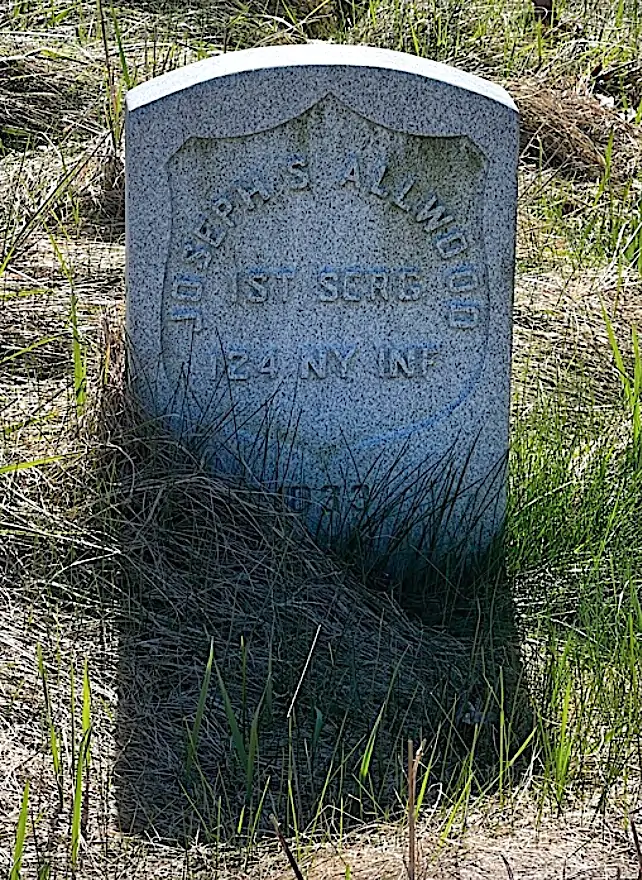
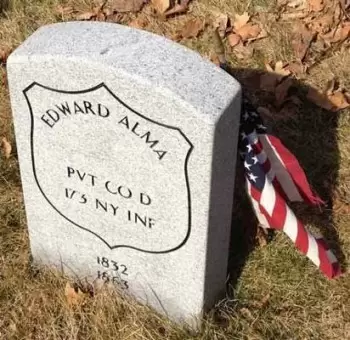
ALMA, EDWARD (1832-1863). Private, 173rd New York Infantry, Company D. Of English birth, he enlisted at Brooklyn on September 6, 1862, mustered into the 173rd on October 30 of that year, and died of chronic diarrhea in New York in 1863. Alma last lived at 44 Market Street in Manhattan. His widow, Elizabeth Alma, applied for a pension in 1863, granted under certificate 48,135. Section 115, lot 13536 (Soldiers’ Lot), grave 61.
ALT, HENRY E. (1836-1898). Second lieutenant, 28th Regiment, New York State National Guard, Company D. Born in Germany, he enlisted as a second lieutenant at Brooklyn on June 13, 1863, was commissioned the same day, and mustered out at Brooklyn after 30 days on July 22.
Alt is listed as a harness-maker and saddler at 920 Myrtle Avenue in the Brooklyn Directory for 1867-1870. The 1870 and 1880 censuses list his occupation as harness-maker; he is also listed as a harness-maker at 920 Myrtle Avenue in the Brooklyn Directory for 1870-1873 and then at 684 Myrtle Avenue in the Brooklyn Directory for 1873-1876. According to the Brooklyn Directory for 1880-1882, he was a harness-maker; the Brooklyn Directory for 1888-1890 notes that he was employed as a saddler.
The 1890 Veterans Schedule confirms Alt’s military status and records his address as 851 Bedford Avenue in Brooklyn. He applied for and was granted a pension in 1896, certificate 934,671. A Freemason, he also belonged to the Independent Schuetzen Corps, a German social club that focused on sharp-shooting and other group events for its members. His last residence was 659 Baltic Street, Brooklyn. His widow, Johanna C. Alt, applied for and was granted a pension shortly after his death in 1898, certificate 468,565. Section 59, lot 743, grave 39.
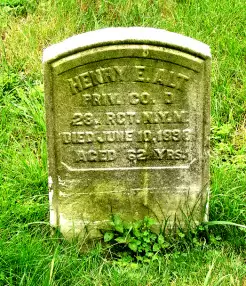
ALTON, HENRY (1836-1916). Lieutenant colonel, 12th Massachusetts Infantry. Originally from Massachusetts, Alton served with the 12th Massachusetts during the Civil War; he was discharged as lieutenant colonel as per his obituary in the Seventh Regiment Gazette. Alton was living in Brooklyn at the time of the 1900 census. His obituary in The New York Times, which confirms his Civil War service, indicates that he was a member of the Old Guard who held the rank of colonel. He last lived at 30 West 9th Street in Manhattan. Section 104, lot 16387.
AMANN (or AMEN, AMDUN, AMAUN), PHILIP (or PHILLIP) (1846-1930). Private, 158th New York Infantry, Company E. Amann was born in Hessen, Germany, and immigrated to the United States as an infant. After enlisting as a private at Brooklyn on August 30, 1862, he mustered into Company E of the 158th New York the next day. He was borne on the rolls as Philip Amen. As per his muster roll, he was a peddler who was 5′ 5″ tall with brown eyes, dark hair and a dark complexion. He mustered out at Richmond, Virginia, on June 30, 1865.
The 1880 census reports that Amann was married with five children, lived in Brooklyn, and worked as a fruit dealer. In 1892, his application for an invalid pension was approved under certificate 848,673. The census of 1910 notes that he lived at 90 19th Street in Brooklyn, had been married for 41 years, worked as a driver, had become a naturalized citizen, and was a veteran of the Union Army. The 1920 New York City Directory lists him as a chauffeur. He last lived at 90 19th Street in Brooklyn. His death was caused by carditis. Section 116, lot 15615, grave 368.
ANDERSON, AARON (or ARON) (1836-1906). Private, 144th New York Infantry, Company F. Originally from Sweden, Anderson enlisted on August 17, 1862, at Hancock, New York, as a private. He mustered into the 144th the next month on September 27 and mustered out of service on June 25, 1865, at Hilton Head, South Carolina. His last residence was at 426 DeKalb Avenue in Brooklyn. Section 135, lot 28307, grave 19.
ANDERSON, CARMEN E. (1841-1893). Private, 84th New York (14th Brooklyn) Infantry, Company E. Serving in 1861, he enlisted at Brooklyn on April 18, mustered in on May 23, and was discharged for disability on June 19 at Washington, D.C. Anderson last lived at 240 St. John’s Place in Brooklyn. He died from paralysis. Section 94, lot 7159.
ANDERSON, EUGENE HIRAM (1842-1872). Private, 71st Regiment, New York State National Guard, Company F. After enlisting at New York City on May 27, 1862, he immediately mustered into the 71st New York, and mustered out after three months on September 2. He also served with the 71st for 30 days in 1863. After the war, he belonged to a Masonic lodge and was a merchant in New York City. He last resided in Philadelphia, Pennsylvania. Section F, lot 18815.
ANDERSON, HENRY C. (1841-1893). Private, 71st Regiment, New York State National Guard, Company D. A native of Brooklyn, he served in the 71st for three months in 1862. After enlisting and mustering into Company D on May 27 at New York City, he mustered out there on September 2. He last lived in Springfield, Long Island. He succumbed to a pulmonary hemorrhage. Section 102, lot 1218, graves 9 and 10.
ANDERSON, JOHN (1812-1881). Tobacconist. A New York native, he made his fortune selling tobacco from his store on the ground floor of the St. Nicholas Hotel, at Broadway and Spring Street. As per the Find a Grave website, Anderson hired Mary Cecilia Rogers in 1838 following the practice of hiring pretty girls as clerks in cigar stores to attract male customers. The attention of the entire country was turned to that store in July of 1842 when Mary Rogers disappeared. Soon thereafter her body was found, floating near the Sibyl’s Cave in Hoboken. Her murder was never solved. Its details were used by Edgar Allan Poe in his story, “The Mystery of Marie Roget.” Anderson was arrested as a prime suspect in the case; his statement to the police was hushed by Tammany Hall politicians who intervened on his behalf. Nonetheless, Anderson’s arrest prevented him from being nominated for mayor of New York City.
Anderson used his wealth to support his close friend, the Italian patriot Garibaldi, and a variety of causes. During the Civil War, when Jersey City lacked funds to put its troops in the field, he sent $60,000 to its mayor so that it could do so. In 1873, when renowned Professor Louis Agassiz applied to the Massachusetts legislature for money to establish a school to instruct teachers in natural history and funding was denied, Anderson gave him $50,000 for that purpose.
As per his obituary in The New York Times, he was active in his business until his death. In addition to his business at 114 Liberty Street, Anderson had a country home in Tarrytown, New York. His death, in Paris on November 22, 1882, was caused by pneumonia. He was survived by his second wife, Catharine née Irwin, one son and two daughters; two other daughters predeceased him. His first wife, Mary née Easler, died in 1872. The obituary noted that his widow would return to New York City with his remains. Burial at Green-Wood was on January 3, 1882. Section K, lot 13724.
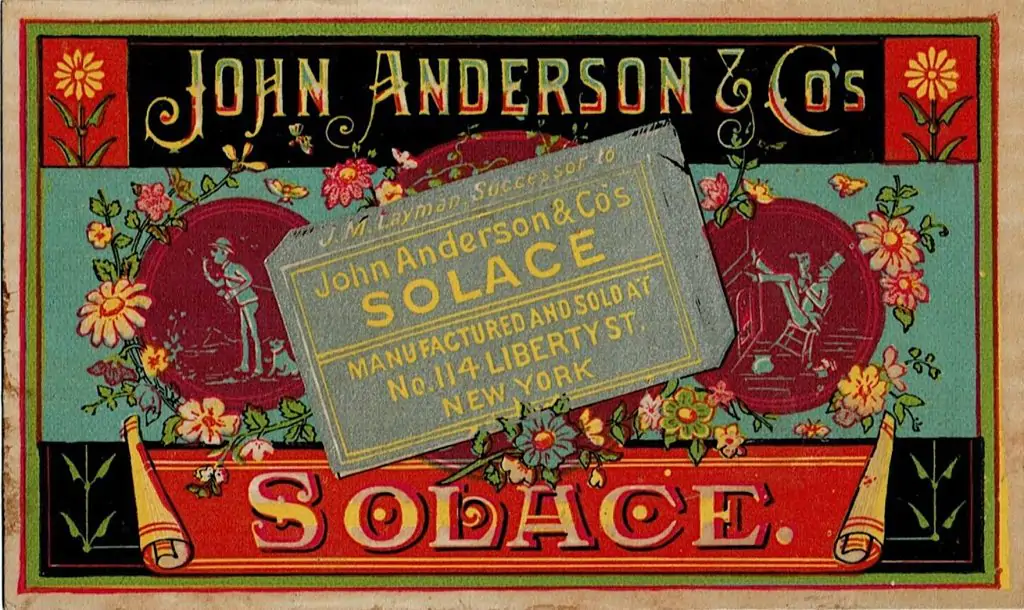
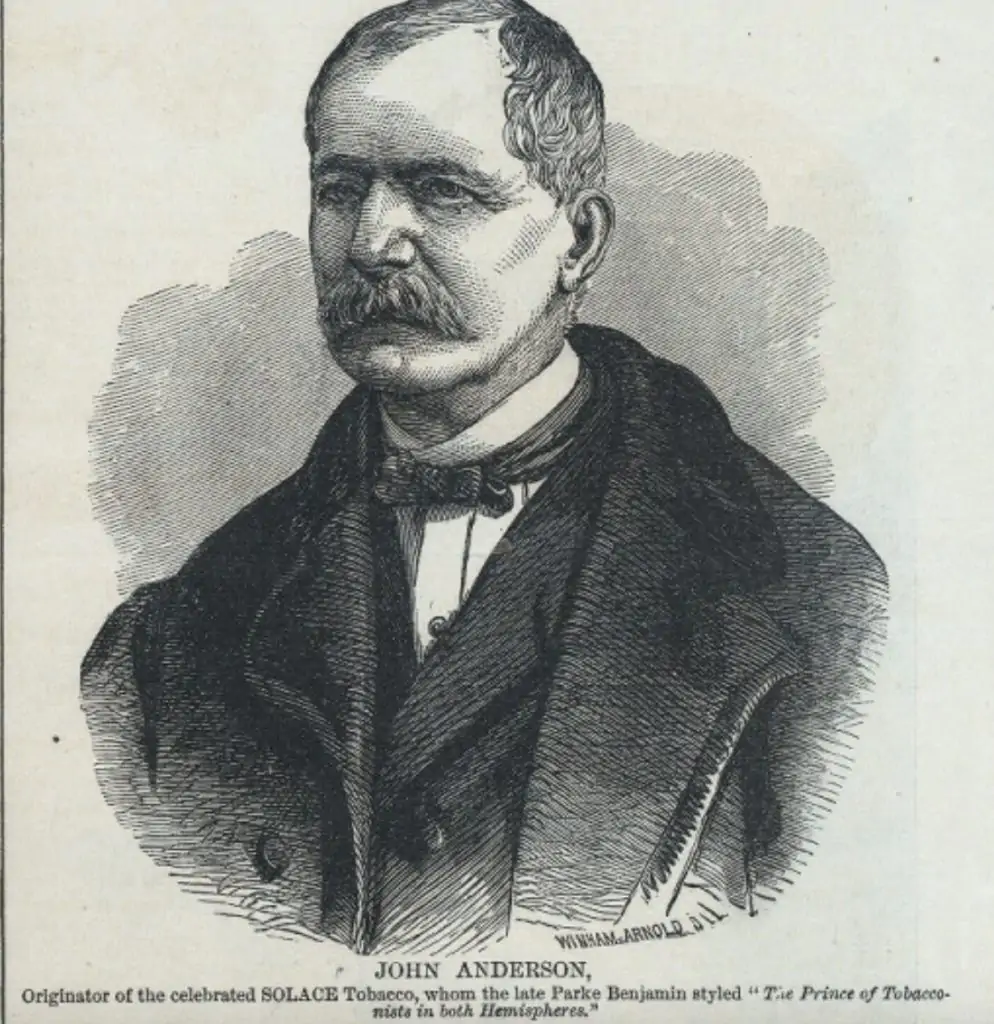
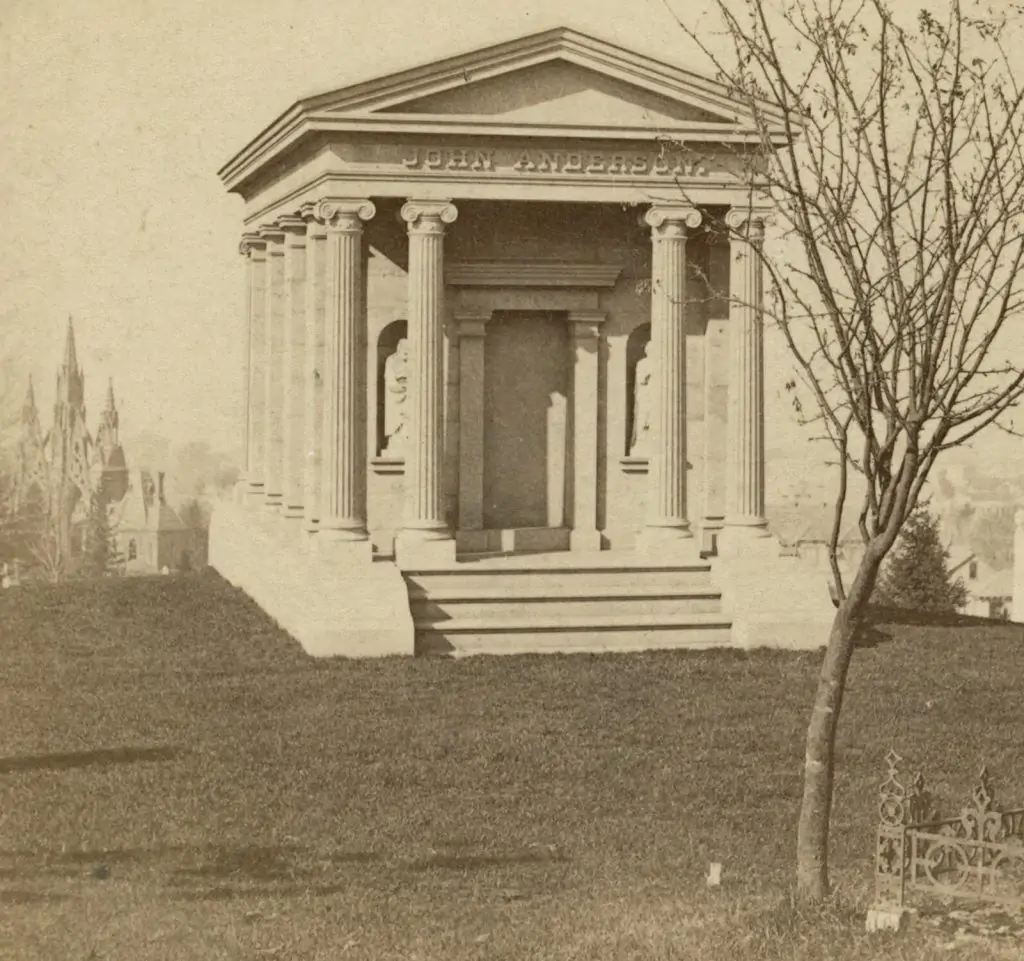
ANDERSON, JOHN HUSKE (1839-1891). Colonel, 2nd North Carolina Junior Reserves; first lieutenant, 48th North Carolina Infantry, Company D; corporal, 1st North Carolina Infantry, Company H, Confederate States of America. A native of Mobile, Alabama, Anderson’s family lived in Fayetteville, North Carolina, at the time of the census of 1850. In 1860, he was working as a clerk. Early in the Civil War, he enlisted as a corporal at Cumberland, North Carolina, on April 17, 1861; he married on May 6, 1861. He mustered into the 1st North Carolina Infantry, also known as the 1st Bethel North Carolina, on an unknown date and mustered out on November 12, 1861. Anderson re-enlisted on an unknown date and was commissioned into Company D of the 48th North Carolina on February 24, 1862. He was promoted to full second lieutenant on April 8, 1862, and then to full first lieutenant on June 28, 1862. He mustered out on February 10, 1863. His soldier records indicate that he was wounded in action and disabled in Virginia.
After his promotion to major of the 2nd Battalion Junior Reserves on May 31, 1864, Anderson was promoted to lieutenant colonel on July 16, 1864, and became colonel of the 2nd Regiment, North Carolina Junior Reserves, formed after the consolidation of the 2nd Battalion Junior Reserves, on December 7, 1864. The Junior Reserves were comprised of 17 year-olds, a year younger than those in combat duty, who were assigned to guard military posts such as bridges, railway depots or prison camps. Confederate Lieutenant General Theophilus H. Holmes praised Anderson as “an excellent officer.” He was captured at the end of the War and was paroled on May 1, 1865, at Greensboro, North Carolina.
Anderson then lived in Fayetteville and Wilmington, North Carolina, before moving to Brooklyn. One job that he held was managing a catering business. By 1880, the census notes that he was married with six children, employed as a salesman, and living in Brooklyn. He last resided at 463 Macon Street in Brooklyn. His death was attributed to cirrhosis. Section 134/135, lot 27263, grave 2236.
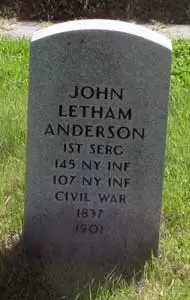
ANDERSON, JOHN LETHAM (1837–1901). First sergeant, 145th New York Infantry, Companies I and B; private, 107th New York Infantry, Company D. Born in Scotland, he enlisted as a private on August 20, 1862, at New York City, and mustered into Company I of the 145th New York on September 11, 1862. He achieved the rank of sergeant on or about April 10, 1863, but subsequently was reduced back to private a month later on May 15, effective upon his transfer to Company B. He became a first sergeant of that company on June 24, 1863. After he deserted on October 27, he was arrested on December 1, reduced in rank to private on that day, and transferred into Company D of the 107th New York on December 9. There is no other information on his service in the 107th. His last residence was 513 Third Place, Plainfield, New Jersey. Section 11, lot 6094, grave 9.
ANDERSON, JOHN PETER (1820-1874). Private, 132nd New York Infantry, Company B; 53rd New York Infantry, Company G. Originally from Denmark, Anderson enlisted at New York City as a private on June 23, 1862, and mustered into the 132nd New York. On September 10, 1862, he transferred into the 53rd New York (second organization) from which he was discharged for disabilities on May 30, 1863, at New Berne, North Carolina. His last residence was 489 Court Street, Brooklyn. He died from a stroke. Section 115, lot 11193, grave 6.
ANDERSON, WILLIAM A. (1836-1917). Sergeant major, 22nd Regiment, New York State National Guard, Company D. William was born in New York City to Jane née Kinsey and James F. Anderson. His obituary in the Brooklyn Daily Eagle notes that he began working as a clerk at the Howard Insurance Company at the age of 14; the Brooklyn Daily Times indicates that he left public school to begin his career in the insurance industry.
Although the Brooklyn Daily Eagle’s obituary states the year of his marriage as 1859, his online family tree on the Ancestry website reports that in 1858, William married Rebecca Myrick, the daughter of James and Rebecca Acken Miller. The couple had five children: James (born 1860), Frank (born 1858), William (born 1862), Elizabeth (born 1865), and Edward (born 1870). At the time of the 1860 census, the couple was living in Brooklyn with their baby James; William’s occupation was clerk. Sadly, James died in 1862.
William’s obituary in the Brooklyn Daily Times reports that during the Civil War he entered service as a private in the 22nd Regiment and accompanied his unit on two campaigns, one to Harpers Ferry and the other to Carlisle, Pennsylvania, when the regiment was activated to help turn back the invasion of the North by General Robert E. Lee’s Confederate Army of Northern Virginia. When William mustered out, he held the rank of sergeant major. However, his soldier record reports that William enlisted as a sergeant at New York City on May 26, 1862, mustered into Company D of the 22nd Regiment two days later and mustered out at New York City on September 5. Anderson’s General Index Cards of his military service show that he was present as a sergeant for three months in 1862 and for 30 days (June 18 through July 24) as a first sergeant in 1863. Frederick Phisterer, in his New York in the War of the Rebellion, 1861-1865 (published 1912), reports that during the activations of the 22nd Regiment, one officer died from disease in the 1862 campaign and one officer and two enlisted men were wounded in 1863.
As per the 1865 New York State census, William and Rebecca were living in Brooklyn with William J. (3) and Elizabeth (1); a servant, Margaret Reardon, also lived in the household. As per the 1870 census, William and Rebecca were living in Brooklyn with children William, Lizzie, and Frank (age 2); two others, relationship unknown, lived in the household. William was in the fire insurance business, had a personal estate of $1,500 and real estate valued at $5,500 (substantial amounts for the time).
After his military service, Anderson became a secretary of the Mercantile Insurance Company and became president of that company in 1870. In 1888, that company dissolved, and Anderson became superintendent of the Bureau of Survey of the New York Board of Fire Underwriters, remaining in that position until his retirement in 1911.
The 1880 census shows that the Andersons were living at 31 Monroe Street in Brooklyn Brooklyn with their four children. William was identified as president of a fire insurance company.
Prominent in his field, William was a member of the Paired Committee on Police and Origin of the Bureau of Fire Underwriters, held the position of vice president (one term) of the National Fire Protection Association and until his retirement was a member of the Board of Consulting Engineers of the National Board of Underwriters. He was a one-term treasurer of the New York Board of Fire Underwriters. He also belonged to the Veterans’ Association of the 22nd Regiment.
As per the 1910 census, the Andersons had been married for 51 years, owned their home at 31 Monroe Street in Brooklyn, and William earned his own income. Two adult sons, William and Frank, lived with them, as did Margaret Gallagher, a servant.
William’s obituary in the Brooklyn Daily Times on January 31, 1917, confirms his Civil War service and notes that the pastor of the Classon Avenue Presbyterian Church would officiate at his funeral. William’s obituary in the Sun confirms his Civil War service and career in the fire insurance industry. The Middletown Times-Press reported that the Andersons spent summers at Greenwood Lake and that William was an ardent fisherman, Civil War veteran and a “lovable man, kind-hearted and sunny always, and a most devoted husband and father.”
As per his obituary in the Brooklyn Daily Eagle, Anderson died from a complication of diseases at 31 Monroe Street, his residence of forty-seven years. His daughter, Elizabeth, died in 1899 and his wife, Rebecca, died in 1910. He was survived by three sons, William T., Frank and Edward S., and three grandchildren. Green-Wood interment records indicate the cause of death as apoplexy and note that his remains were placed in a small mausoleum.
According to the records of New York State Wills and Probate, William had $35,000 (the equivalent of about $863,000 in 2025 money) in personal estate to be divided equally among his three sons. His sister, who lived in Illinois, was bequeathed $2,000. Section 170, lot 11215.
ANDREWS, ROBERT (1835-1904). Private, 8th Regiment, New York State Militia, Company D. Andrews was a native of Ireland. According to the G.A.R.’s Mortuary Table of 1904, he served in the 8th Regiment for 30 days in 1861. He was a member of the James C. Rice Post #29 of the Grand Army of the Republic in New York City as of January 22, 1886. Andrews’s last residence was 188 West 102nd Street. He succumbed to cancer. In 1905, his wife applied for a widow’s pension, application 824,343, but it does not appear to have been certified. Section 151, lot 17561, grave 2.
ANDREWS, WILLIAM H. (1843-1903). Musician, 48th New York Infantry, Companies I and E. Andrews was born in England and enlisted at Brooklyn on July 26, 1861, as a private. He mustered into Company I of the 48th on August 16 of that year. During his service, he was promoted to musician and transferred into Company E. Andrews was wounded at Fort Wagner, South Carolina, on July 18, 1863, and discharged on an unknown date. He last lived in Manhattan at 27 East 34th Street. Andrews died from nephritis. He was buried originally at Linden Hill Cemetery in Queens, and was re-interred at Green-Wood on November 9, 1904. Section 188, lot 31649, grave 3
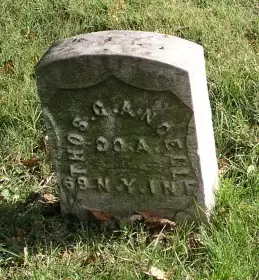
ANGEL (or ANGELL), THOMAS GEORGE (1834-1892). Corporal, 95th New York Infantry, Companies A and G; private, 69th Regiment, New York State Militia, Company A. Angel, who was born in England and became a citizen in 1855, served as a private in the 69th Regiment, New York State Militia, for three months in 1861. After re-enlisting as a private at New York City on August 23, 1863, he mustered into Company A of the 95th New York that day, and became a corporal on December 15 effective upon his simultaneous transfer to Company G. He was wounded in the hand at the Wilderness, Virginia, on May 5, 1864, and mustered out on October 24, 1864.
According to census records, Angel was a butcher by trade. In 1882, his application for an invalid pension was approved, certificate 1,078,401. He was likely the brother of William Angel (see). Angel last lived at 444 Ninth Avenue in Manhattan. His death was attributed to a stroke. His widow applied for and received a pension, certificate 571,571. Section 114, lot 8999, grave 959.
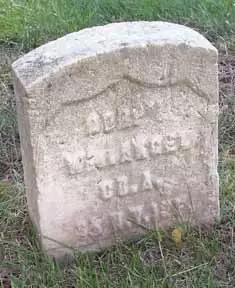
ANGEL (or ANGELL), WILLIAM (1840-1904). Corporal, 95th New York Infantry, Companies A and G. Originally from England, he enlisted as a private on December 5, 1863, and mustered into Company A of the 95th New York (where his name was spelled “Angell”). He was promoted to corporal ten days later effective upon his transfer to Company G. On April 15, 1864, he received an intra-regimental transfer and returned to Company A. Angel was wounded in the foot on May 5, 1864, at the Battle of the Wilderness, Virginia, and mustered out of service on June 17, 1865, at Washington, D.C. His pension record indicates that he also served in Company F of the 12th New York but there are no further details about that enrollment.
A conductor according to the 1880 census, Angel was listed as a janitor in the 1890 census. His application for an invalid pension in 1882 was approved, certificate 302,912. He was likely the brother of Thomas (see). His last residence was 509 West 50th Street in Manhattan. Angel died from pneumonia. His widow received a pension, certificate 578,503. Section 128, lot 31394, grave 162.
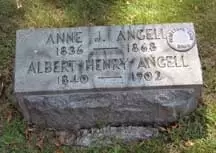
ANGELL, ALBERT HENRY (1840-1902). Landsman, United States Navy. Born in New Haven, Connecticut, Angell enlisted in the Navy as a landsman on September 30, 1862. At the time of his enrollment, he was a gunsmith who was 5′ 7½” tall with a fair complexion, blue eyes, and small indentation over his eye as a result of a childhood injury. His father was an ardent supporter of the Union, but his brother and other relatives served in the Confederate forces. He first served on the receiving ship North Carolina from September 30 through February 24, 1863, then was transferred to the USS Catskill off the coast of the Carolinas until October 5, 1863. He was discharged at the Brooklyn Navy Yard five days later. As per his application for an invalid pension, he suffered from pleurisy while on the Catskill due to exposure and “severe service” at Charleston and Port Royal, South Carolina.
After the Civil War, Angell achieved prominence as a journalist working for the Brooklyn Daily Eagle and rose to the position of city editor and editorial writer. He is listed as an editor in the Brooklyn Directory for 1873-1876. In addition, he served as secretary to Brooklyn Mayor Martin Kalbfleisch, and later was managing editor of the Brooklyn Union and Brooklyn Standard. On his death certificate, his occupation was listed as “advertiser.” Active in community life, he was an early member of the New York Press Club and was president of the Good Roads Association. In 1890, he applied for and received an invalid pension from the Navy under certificate 22,791.
Angell last lived at 513 Vanderbilt Avenue in Brooklyn where he succumbed to Bright’s disease. His obituary in the New York Herald notes that his funeral took place at the Church of the Messiah at the corner of Greene and Clermont Avenues in Brooklyn. That obituary noted that members of the New York Press Club, Good Roads’ Association, Long Island Wheelmen, Masonic Veterans and his local Masonic Lodge were invited to attend his funeral. In 1903, his widow and second wife, Florence Angell, applied to the Navy for a pension, application 21,421, attesting to the fact that she took in lodgers to pay for her mortgage and that she still supported a minor child. In 1908, she received a pension of $12 a month, certificate 19,728. Section 175, lot 18465.
ANGELL (or ANGEL), FREDERICK (1841-1914). Private, 12th Regiment, New York State Militia, Company F; 1st New York Mounted Rifles, Companies M and H; 4th New York Provisional Cavalry, Company K. Born in England, he first served in the 12th New York State Militia for three months in 1861. He re-enlisted on August 12, 1862, mustered immediately into Company M of the 1st New York Mounted Rifles, was captured on April 12, 1863, at Suffolk, Virginia, and was released ten days later. During his service he was transferred to Company H. Angell re-enlisted a third time on September 1, 1864, transferred into the 4th Provisional Cavalry on September 6, 1865, after the 1st Mounted Rifles was consolidated into that unit, and mustered out on November 29, 1865, at City Point, Virginia.
According to the 1880 census, Angell was employed as a hostler, a groom in a stable, often at an inn. The 1890 Veterans Schedule confirms his military service. His application for an invalid pension was approved in 1892, certificate 1,065,728. According to the 1910 census, he was a peddler of oysters and clams. He last lived in Manhattan at 175 West 12th Street. Angell succumbed to heart disease. Shortly after his death in 1914, Amelia Angell, who is interred with him, applied for and was awarded a widow’s pension, certificate 776,099. Section 6, lot 20118, grave 67.
ANGUS, HENRY (or HARRY) (1814-1892). Private, 67th New York Infantry, Company B. At age 44, he enlisted at Brooklyn on June 14, 1861, mustered into the 67th six days later, and mustered out on July 4, 1864. He applied for a pension in 1872, certificate 101,084. He last lived at 606 Franklin Avenue in Brooklyn. He died from pneumonia. Section 49, lot 7313.
ANKETELL, WILLIAM T. (1842-1883). Sergeant, 9th New York Infantry, Company K. Anketell was born in Ireland. During the Civil war, he enlisted at New York City on May 3, 1861, mustered into the 9th New York the next day, was promoted to sergeant at some point but was reduced to the rank of private on August 7, 1862, and mustered out at New York City on May 20, 1863.
As per the Brooklyn Directory for 1873-1876, he was employed as a clerk and lived at 1021 Myrtle Avenue in Brooklyn. According to the 1870 census, he was employed as a cigar sampler. In 1883, he applied for an invalid pension, application 476,415, but he died before receiving it. He last lived in Brooklyn. Shortly after his death from cholera in 1883, Mary Anketell applied for and received a widow’s pension, certificate 291,291. Section 17, lot 17245, grave 876.
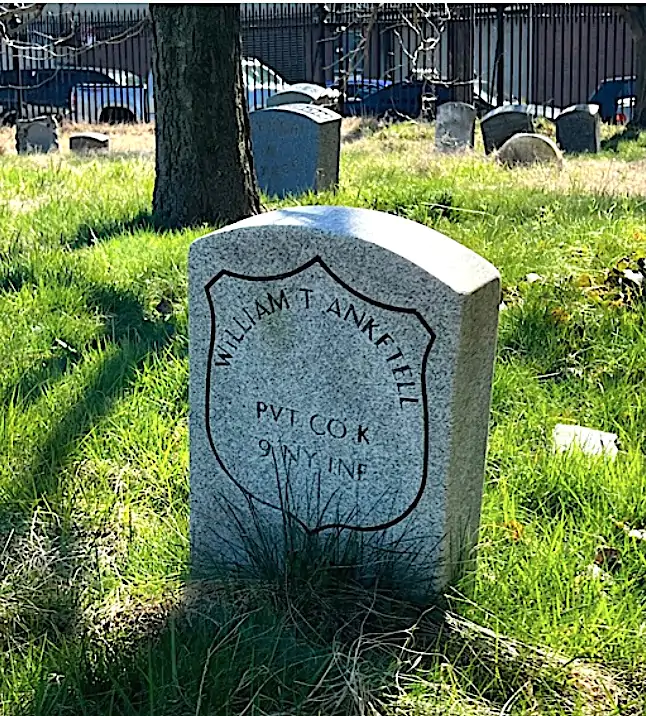
ANSON, JOHN (1840-1910). Corporal, 70th New York Infantry, Company G. A native of Norway, Anson enlisted as a private at New York City on April 28, 1861, and mustered into the 70th on October 8. During his service, he received a promotion to corporal but was later reduced in rank to private. On June 20, 1862, he deserted at Fair Oaks, Virginia. He last lived at 465 Henry Street in Brooklyn. He succumbed to a stroke. Section 189, lot 18500.
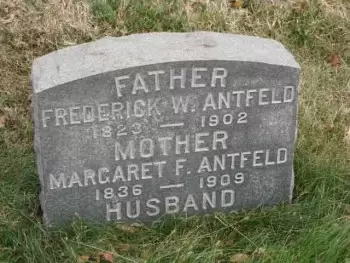
ANTFELD (or ALMFELD), FREDERICK WILLIAM (1823-1902). Artificer, Backof’s Battalion, Missouri Artillery, 10th Missouri Cavalry. Of German origin, he arrived in the United States as a cabin passenger on the New Orleans, a passenger ship that departed from Bremen in 1850. The passenger list for that vessel listed him as a merchant. He was 5′ 6″ tall with blue eyes, medium complexion, and brown hair. Antfeld enlisted and served for three months as an artificer in Backof’s Battalion of the Missouri Light Artillery in 1861. He also served in the 10th Missouri Cavalry.
A resident of St. Louis, Missouri, in 1864, Antfeld signed his citizenship papers there on November 19. He later moved to Brooklyn and according to the 1870 census and the Brooklyn directory for 1888, he was employed as a harness-maker. In 1897, his application for an invalid pension was approved, certificate 994,408. His last residence was 258 22nd Street in Brooklyn. His death was attributed to asthenia (muscle weakness). Shortly after his death in 1902, Margaret Antfeld, who is interred with him, applied for and received a widow’s pension, certificate 554,963. Section 136, lot 28070, grave 184.
ANTHONY, EDWARD (1819-1888). Photographic pioneer. Born in New York City, he studied science and civil engineering at Columbia College and graduated in 1838. One of his first jobs was building the Croton Aqueduct through which the New York City area receives its drinking water. However, in the aftermath of the Panic of 1837, he could not find steady work as a civil engineer, and was soon encouraged by his favorite professor, James Renwick, Sr., to pursue a career in the newly emerging field of photography. He attended an exhibit given by pioneer photographer Louis Daguerre’s representative, Francois Gouraud (who also is interred at Green-Wood), in 1839 and then spent twenty-five cents to make his own camera. In 1840, he paid to study the new art with Samuel Morse (see), the inventor of the Morse Code and the telegraph, and in that same year took the first photographs used by any government when he photographed the Maine/Canada border for a surveying expedition to settle a border dispute with Great Britain. Those photos, helpful in the drafting of the Webster-Ashburton Treaty of 1842, are preserved in the archives in Washington, D.C. In 1843, he established the first American gallery to exhibit photographic portraits of famous individuals. His business of photographic supplies began in 1847 and he was joined by his brother Henry, also a civil engineer with a background in banking, in 1852. The firm took the name of E. & H. T. Anthony in 1862.
The Anthonys pioneered in photographic equipment, chemicals, stereoviews, cartes de visite, and instantaneous photography (reducing exposure times which until then had been thirty seconds down to 1/40th of a second in 1859), ultimately making the firm of E. and H. T. Anthony, the largest photographic supplier in the United States, and perhaps the world. Cartes de visite, which were about the size of calling cards, were popular during the Civil War. The cards were a way in which soldiers and family members and friends could obtain photographs inexpensively and communicate with each other by placing the prints in small envelopes. The firm also employed a large staff to manufacture albums to display collections of cartes de visite. Matthew Brady, the famous Civil War photographer, bought his supplies from the Anthony brothers. When Brady couldn’t pay his bills, the Anthonys owned the negatives and sold the prints that they made from them. Their stereoviews, which were 3-D images when used with the proper equipment, told stories about New York City and about Green-Wood Cemetery. (11,000 different views were for sale in 1873 and their stereoviews are still collected today.)
The New York City Directory for 1875-1876 listed the E. & H. T. Anthony firm selling photographic materials at 591 Broadway, opposite the Metropolitan Hotel; Edward Anthony was also listed in the 1876-1878 New York City Directory as employed in the photographic materials business (as was his brother). In 1883, the firm of E. and H. T. Anthony produced the first commercially manufactured hand instantaneous camera called the Schmidt Patent Detective Camera. The company eventually became the Ansco firm. He died of heart failure. Section 160, lot 9989.
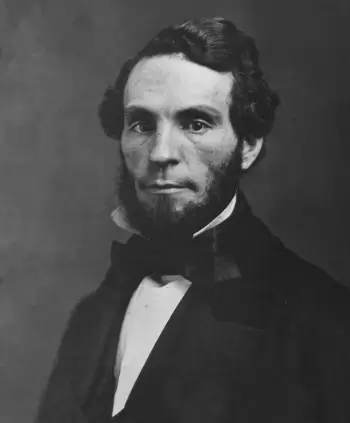
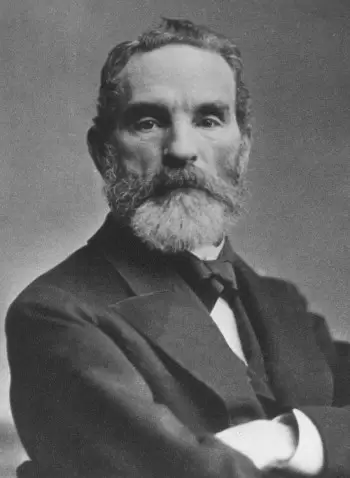
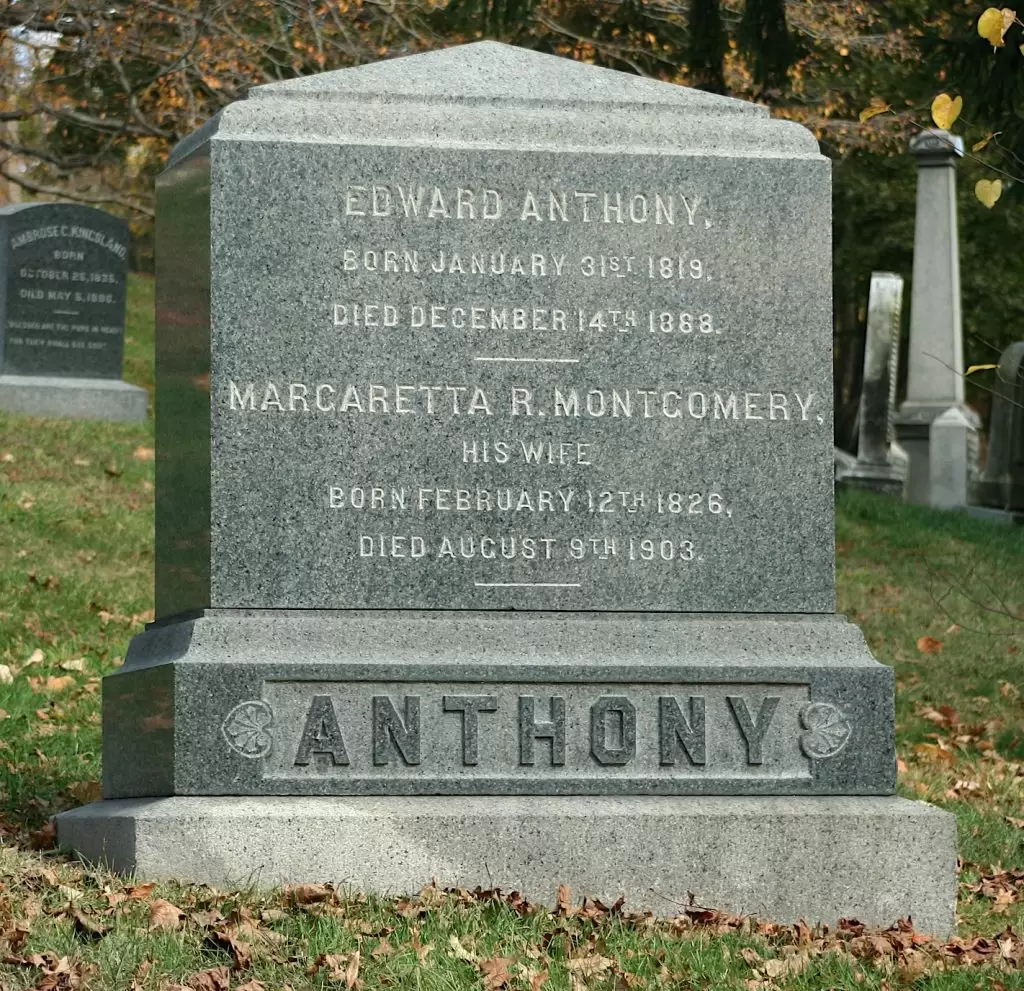
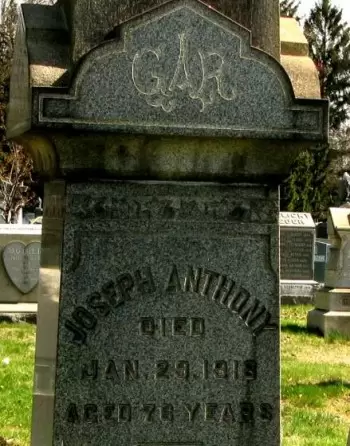
ANTHONY, JOSEPH A. (1842-1918). First sergeant, 13th New York Heavy Artillery, Company A; private, 4th New York Infantry, Company C; 6th New York Heavy Artillery, Company H. A New York City native, he enlisted there as a private on April 23, 1861, mustered into the 4th New York on May 2, and mustered out on May 25, 1863, at New York City. Anthony re-enlisted as a corporal at New York City on July 14, 1863, and mustered into Company A of the 13th New York Heavy Artillery on August 12. On September 1, 1863 he was promoted to sergeant of his company, and was promoted to first sergeant on February 17, 1864. After he was reduced in rank to sergeant on March 19, 1864, he was demoted to private the next month on April 5. On July 18, 1865, he transferred into Company H of the 6th New York Heavy Artillery as a private.
In 1885, Anthony’s application for an invalid pension was granted, certificate 721,328. His last residence was 243a Nassau Avenue in Brooklyn. He died from pulmonary edema. Jane Anthony, his widow, who is interred with him, received a pension after his death in 1918, certificate 859,043. There is an inscription, “G.A.R.,” on his tombstone, but no mention of the post to which he belonged. Section 204, lot 29069, grave 21.
ANTON, AUGUST (1834-1900). Private, 58th New York Infantry, Company D. Born in Germany, Anton enlisted as a private at New York City on September 4, 1861, and mustered into Company D of Morgan’s Rifles (the original name of the 58th New York) on September 21. He deserted two months later on November 23 prior to his scheduled transfer into the same company of the newly organized 58th. He last lived at 59 Stockholm Street in Brooklyn. His death was attributed to pneumonia. Section 185, lot 26650, grave 1.
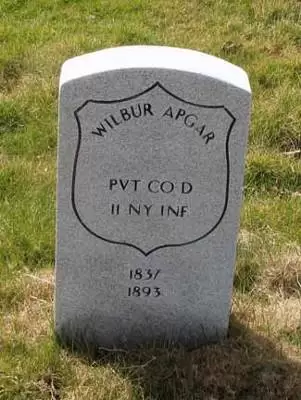
APGAR, WILBUR (or WILLIAM) (1837-1893). Private, 11th New York Infantry, Company D. After enlisting at New York City on April 20, 1861, Apgar, a native of the city, mustered into the 11th on May 7, and deserted at New York City on September 19. Apgar’s last address was 269 East 10th Street in Manhattan. He died from pneumonia. Section 17, lot 17245, grave 1411.
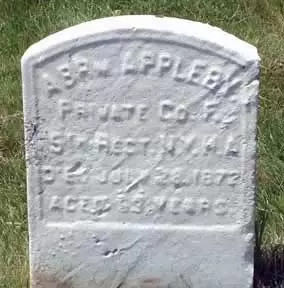
APPLEBY (or APPLIBY), ABRAHAM (1819-1872). Private, 12th New York Heavy Artillery; 15th New York Heavy Artillery, Company F. Appleby enlisted on May 11, 1863, mustered into an unknown company of the 12th Heavy Artillery on June 19, and was transferred into the 15th New York Heavy Artillery three days later. On August 22, 1865, he mustered out at Washington, D.C. According to the census of 1870, he was living in Brooklyn and worked in a tobacco factory. His service is inscribed on his tombstone. Section A, lot 8100, grave 514.
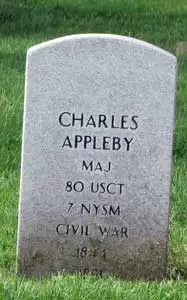
APPLEBY, CHARLES (1844-1891). Major by brevet; captain, 80th United States Colored Troops (USCT), Companies F and G; first lieutenant, 3rd Regiment, United States Infantry, Company F; private, 7th Regiment, New York State National Guard, Company B. A native New Yorker, Appleby began his military service when he enrolled as a private to serve for three months in the 7th Regiment on May 25, 1862. He mustered in on June 19, and mustered out with his company on September 5 at New York City. On February 25, 1863, he re-enlisted as a first lieutenant and was commissioned into the 3rd Regiment, U.S. Army, taking an active part in engagements at Louisiana including the siege and capture of Port Hudson in June 1863. Appleby remained with the 3rd until his promotion to captain of the 80th Infantry, USCT, on March 29, 1864, where he served in Companies F and G. During his service, he was on picket duty in Louisiana and Texas through 1865. At that time, he was detailed as judge advocate to General Andrews at Port Hudson on March 16, 1864, was provost-marshal at Marshall, Texas, and was wounded in the arm in a skirmish near Jackson. On May 21, 1866, he was brevetted major of United States Volunteers “for faithful and meritorious services,” to date from October 6, 1865. He was discharged on March 1, 1867.
A charter member of Lafayette Post #140 of the G.A.R., Appleby held the positions of senior vice-commander and commander. In 1890, he applied for an invalid pension, application 784,706, as did his widow, Mary Appleby, application 626,443, but there are no certificate numbers for either request. His name is displayed on the African American Civil War Memorial in Washington, D.C., plaque C-86. He last lived at 2013 Fifth Avenue in Manhattan. Appleby died from pneumonia. Section 62, lot 5467.
APPLEGATE, EZEKIEL (1836-1869). Private, 83rd New York Infantry, Company C. Originally from New Jersey, he enlisted as a private at New York City in 1861, mustered into Company C of the 83rd New York and mustered out at the expiration of his term. A carpenter by trade, his last residence was 300 West 41st Street in Manhattan. His death was attributed to cholera. Section 66, lot 2066.
APPLEGATE, LEWIS (1840-1870). Major by brevet; assistant surgeon, 102nd New York Infantry; United States Volunteers Medical Staff. A native of New York City, Applegate enlisted at Albany, New York, as an assistant surgeon on September 9, 1862, and was commissioned into the Field and Staff of the 102nd New York that day. As per an undated prison record, L. Applegate, assistant surgeon of the 102nd New York, was listed among those who arrived at Libby Prison the day before. The document noted that 99 prisoners had arrived from Charleston, most of whom were wearing Confederate uniforms when captured. In addition, 13 prisons arrived from Knoxville, Tennessee. Prior to his mustering out on September 24, 1864, he was commissioned into the United States Volunteers Medical Staff on September 9 as an assistant surgeon. He was brevetted to major on October 6, 1865, and mustered out three days later. His last residence was at 304 West 28th Street in Manhattan. Applegate succumbed to a stroke. Section 43, lot 3525.
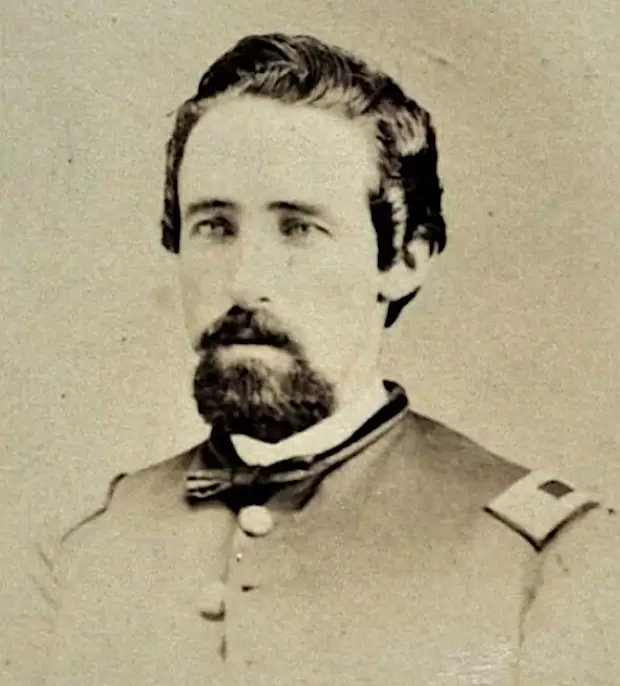
ARCHBOLD, JOSEPH (1837-1878). Second lieutenant, 71st Regiment, New York State National Guard, Company K. Born in New York, he enlisted as a sergeant at New York City on May 28, 1862, mustered that day into Company K of the 71st Regiment, New York State National Guard, and mustered out after three months at New York City on September 2. He returned to the same unit and company on June 30, 1863, this time being promoted to the rank of second lieutenant, and mustered out at New York City after 30 days on July 22. He last resided at 60 5th Avenue, New York City. The cause of his death was Bright’s disease. Sarah Archbold, who is interred with him, applied for and received a widow’s pension in 1908, certificate 6672,600. Section 45, lot 3303.
ARCHER, CHARLES (1837-1880). Private, 1st New York Infantry, Company F; 15th New York Light Artillery, Company F. He enlisted at New York City as a private on March 4, 1862, mustered into the 1st New York on that day, and mustered out on May 25, 1863, at New York City. Subsequently, he served in the 15th New York Light Artillery. He last resided in East Orange, New Jersey. His cause of death was tuberculosis. In 1890, Rachel Archer, who is interred with him, received a widow’s pension, certificate 324,554. Section 15, lot 17263, grave 86.
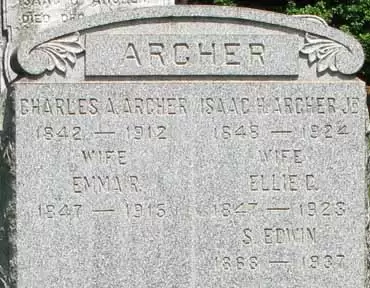
ARCHER, CHARLES A. (1842-1912). Sergeant, 83rd New York Infantry, Company F. Archer enlisted as a private at New York City on May 27, 1861, mustered immediately into his company of the 83rd New York, and was promoted to corporal on January 1, 1863. Two months after he was wounded on July 1, 1863, at Gettysburg, Pennsylvania, he was promoted to sergeant on September 1. On June 23, 1864, he mustered out at New York City.
Archer applied for an invalid pension in 1912, application 1,404,982, but died from heart disease before receiving it. His last address was 227 93rd Street in Brooklyn. His wife, Emma E. Archer, received a widow’s pension, certificate 798,829, after applying shortly after his death in 1912. Section 50, lot 7108.
ARCHER, GEORGE W. (1833-1873). Private, 182nd New York Infantry, Company G. He enlisted as a private at New York City and mustered immediately into the 182nd New York on October 3, 1862. The next day, before muster call, he deserted. He last lived in Brooklyn. Archer died from tuberculosis at Long Island College Hospital. Section 53, lot 12512.
ARMSTRONG, EDWARD (1830-1891). Private, 23rd Regiment, Connecticut Infantry Volunteers, Company B. A native of New York State, Armstrong was living in Danbury, Connecticut, in 1862, with his new wife, the former Rachel Olmstead, and their infant son. According to his descendant, his wife’s family traces its roots to one of the first families in the Danbury/Wilton area. That descendant also notes that Edward Armstrong’s father, James, was a cousin and friend of John Armstrong Jr., the Secretary of War in President James Madison’s cabinet. As per the Catalogue of Connecticut Volunteer Organizations, Edward Armstrong enlisted as a private on September 1, 1862, and mustered into the 23rd Regiment, Connecticut Infantry Volunteers on November 14; his regiment was engaged in action in New Orleans, Louisiana. He was honorably discharged with his company on August 31, 1863.
In 1870, the Armstrong’s newborn son was named William Tecumseh Sherman Armstrong. The Veterans Schedule of 1890 confirms his Civil War service; at that time he lived at 446 Greene Avenue in Brooklyn (incorrectly written as 356 Greene Avenue on that document.) He last lived in Manhattan. Armstrong died from “mania à potu” (delirium) at Bellevue Hospital. As per his descendant, Armstrong was buried in the family lot which was purchased by his parents on February 15, 1848, for $80. Section 57, lot 2283.
ARMSTRONG, JOHN H. (1827-1890). Private, 16th New York Cavalry, Company K; 3rd New York Provisional Cavalry, Company M. Originally from Ireland, Armstrong enlisted as a private at Yonkers, New York, on August 12, 1863, and mustered into the 16th New York Cavalry on September 22. On August 17, 1865, he transferred into Company M of the 3rd New York Provisional Cavalry, a regiment formed from the consolidation of the 16th and 13th New York Cavalries. He was discharged on September 21, 1865, at Camp Barry, Washington, D.C. In 1888, he applied for and was granted an invalid pension, certificate 782,108. His last residence was 143 North 8th Street in Brooklyn. Mary Armstrong applied for and received a widow’s pension in 1894 under certificate 320,852. Section A, lot 8998, grave 414.
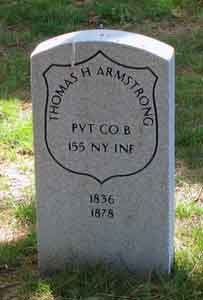
ARMSTRONG, THOMAS H. (1836-1878). Private, 155th New York Infantry, Company B. After enlisting as a private at New York City on September 13, 1862, Armstrong mustered into the 155th on November 18, and deserted on December 24, 1863, at Fairfax Court House, Virginia. He last lived on Washington Street in Hoboken, New Jersey. His death was attributed to mania. Section 162, lot 15445.
ARMSTRONG, WILLIAM (1839-1922). Corporal, 2nd New York Provisional Cavalry, Company D; private, 15th New York Cavalry, Company D. Of Irish origin, Armstrong enlisted as a private at Newburgh, New York, on January 4, 1864, and mustered into the 15th New York Cavalry seven days later. On June 17, 1865, he transferred into Company D of the 2nd New York Provisional Cavalry. He was promoted to corporal of his company on July 1, 1865, and mustered out on August 9, 1865, at Louisville, Kentucky. He applied for and was granted and invalid pension in 1890, certificate 651,684. His last residence was 1482 East 13th Street, Brooklyn. After his death from tuberculosis in 1922, his wife applied for a widow’s pension, certificate 922,988. Section J, lot 34259, grave 2.
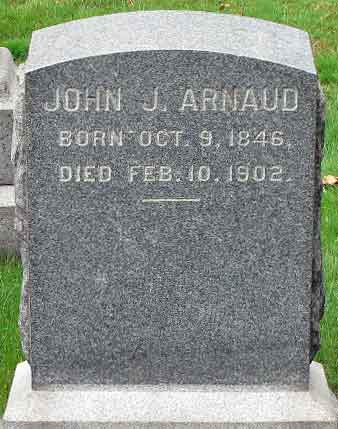
ARNAUD, JOHN J. (1846-1902). Private, 173rd New York Infantry, Company A. Originally from Boston, Massachusetts, he enlisted as a private at Brooklyn on September 4, 1862, mustered into the 173rd New York on October 30, and mustered out on October 18, 1865, at Savannah, Georgia. His pension record indicates that he was a musician in the 173rd but details no further information.
In 1901, Arnaud filed for a pension, application 1,261,479, but no certificate number is listed. A member of the George C. Strong Post #534 of the G.A.R., he died in Bath, New York, most likely as a resident of the Soldiers’ Home there. Upon his death from nephritis in 1902, Anna Arnaud, applied for a widow’s pension which was granted, certificate 539,735. Section 200, lot 26589.
ARNDT, ALBERT (1827-1862). Major, 1st Battalion, New York Light Artillery, Battery A. A native of Germany, Arndt lived in New York City before the Civil War. On July 24, 1861, he enlisted as a captain at New York City, was commissioned into Battery A of the 1st Battalion (also known as the German Rangers) on August 12, and was promoted to major eight days later. After being discharged without being commissioned on October 29, 1861, he re-enlisted in 1862. He commanded the 1st Battalion of Artillery during the Seven Days Battle, Virginia, on June 25-July 2, 1862, and led Battery A of the 1st Battalion at the Battle of Antietam, Maryland, where he was wounded in action on September 17, 1862, and succumbed the next day at Sharpsburg, Maryland.
Brigadier General Henry J. Hunt, United States Army, noted his death in his field report about Antietam written on February 6, 1863, “…The enemy soon opened upon them. The fire was promptly returned, and the enemy ceased his fire and withdrew his guns. In this cannonade Maj[or] Albert Arndt, commanding the First (German) Battalion New York Artillery, an experienced and excellent officer, was mortally wounded while personally directing one of his guns, and died on the 18th …” Section 115, lot 13536 (Soldiers’ Lot), grave 30.
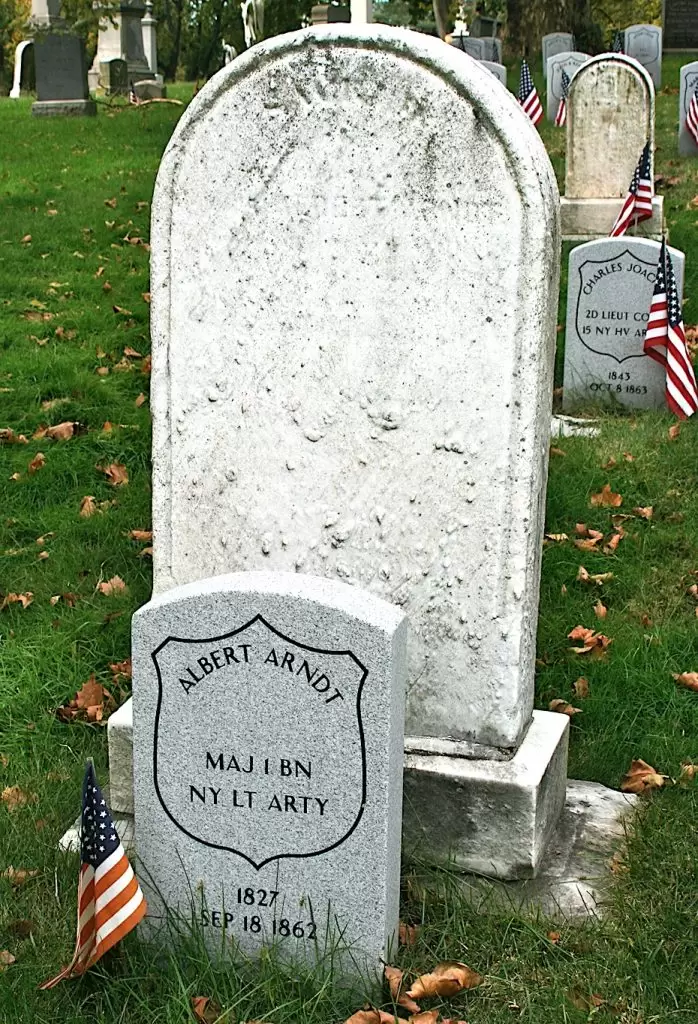
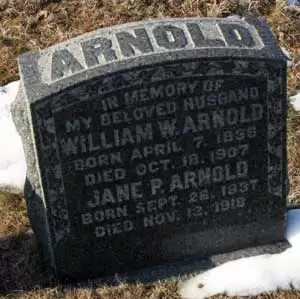
ARNOLD, WILLIAM WILLETS (1836-1907). Private, 12th Regiment, Virginia Volunteers, Company A, Confederate States of America. Arnold was born in New York. As per the 12th’s muster roll, he enrolled in that regiment of Virginia Volunteers, also known as Captain John P. May’s Company of the Petersburg City Guards, on June 12, 1861. His enlistment was for one year and he appeared on the monthly muster rolls for that period. Arnold was present for duty for all months except for the period when he was admitted to Chimborazo Hospital No. 1 in Richmond, Virginia, from June 23 to 30, 1862, and in July 1862, when he was listed as sick and wounded, surgeon’s certificate. Remaining in service after his one year of duty, on October 31, 1862, he was listed as sick in Petersburg as of August 16, 1862, and “Absent without leave.” Arnold was discharged on November 3, 1862, when a substitute, George Williams, replaced him.
In 1863, Arnold married a Virginia-born woman. At some point, they returned to New York where he was a salesman according to the 1880 census. He founded the Brooklyn Branch of the American Legion of Honor and was a Freemason. According to his obituary in The New York Times, Arnold was a Civil War veteran who fought with the Confederate Army. His obituary in the Brooklyn Standard Union reports that he was a salesman who had lived in Brooklyn for forty years. His last address was 782 Nostrand Avenue in Brooklyn; he was survived by his wife, Jane, four daughters and a son. His death was attributed to nephritis. Section 134, lot 16874, grave 98.
ARNOULD, DENIS (1847-1916). Private, 1st New York Light Artillery, Company G. A native of Canada, his family immigrated to the United States in 1848. Arnould enlisted as a private on October 8, 1864, and was discharged on June 19, 1865, at Elmira, New York. According to the census of 1870, he was a compositor but then he was a wholesale confectioner in New York City for more than 50 years. The 1877 New York City Directory lists him in the candy business at 934 Broadway with a home address at 199 Sixth Avenue. The New York City Directory for 1884-85 shows that he was in the candy business at 17 Wooster Street in Manhattan. Arnould became a U.S. citizen in 1888. As per the New York City Directories for 1896-1899, his candy business was at 385 Canal Street; in 1896, he lived in Paterson, New Jersey, and in 1897, he lived at 78 West 68th Street in Manhattan.
In 1909, Arnould successfully applied for a pension, certificate 1,158,460. Active in civic life, he was a member of a Masonic lodge, Shriners, Foresters, and the Abraham Lincoln Post #13 of the G.A.R. He was the brother of Joseph Henri Arnould (see). He last resided at 55 Christopher Street, Greenwich Village, where he succumbed to endocarditis.
On December 16, 1917, The New York Times reported on the appraisal of his estate. As per that article, his daughters, Pauline and Emily Arnould were to receive the total assets of $85,679 (the equivalent of $1.7 million I 2019). The estate’s value was enumerated as follows: real estate from the candy factory at 385 Canal Street was valued at $15,000; cash $30,628; the candy manufacturing business of which he was the sole owner, $40,035. Section 199, lot 24726.
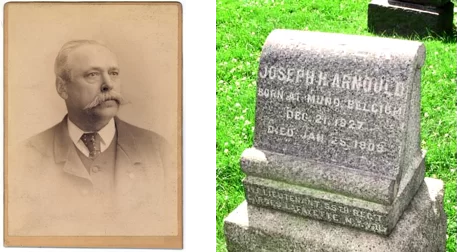
ARNOULD, JOSEPH HENRI (1829-1908). First lieutenant, 55th New York Infantry, Company E. Originally from Muni, Belgium, he immigrated to New York City via Canada circa 1846. According to the 1850 census, he was a cabinet-maker and by 1860, the census listed him as a contractor with a personal estate worth $8,000.
Arnould enlisted as a first lieutenant on July 29, 1861, at Staten Island, and was commissioned into his company the following month on August 28. He was promoted to first lieutenant on January 25, 1862. Wounded in battle on May 31, 1862, at Fair Oaks, Virginia, he was discharged on September 12, and applied for an invalid pension in October 1862 that was granted under certificate 185,132.
In 1868, Arnould became a naturalized citizen. The 1880 census listed him as a building contractor. Arnould was a president of the New York French Concorde Lodge #40. As per his obituary in the New York Herald, members of the Independent Order of Odd Fellows, a fraternal organization to which he belonged, were invited to attend his funeral. He was the brother of Denis Arnould (see). He last resided at 188 Hudson Street in Manhattan, his home for more than 40 years, where he died from diabetes. His funeral took place at the chapel of the Stephen Merritt Burial Company at Eighth Avenue and 19th Street in Manhattan. Section 199, lot 24726.
ARNOUX, WILLIAM (1824-1910). First sergeant, 8th Regiment, New York State Militia, Company I. Arnoux served for three months in 1861 in the 8th New York State Militia. His name is on the list of the Sons of Union Veterans, an organization of Civil War descendants. He last resided at 38 Henry Street in Passaic, New Jersey. His death was attributed to edema of the lungs. Section 35, lot 4250.
ARROWSMITH, GILBERT LANE (1823-1885). Second lieutenant, 7th Regiment, New York State National Guard, Company H. Arrowsmith’s birthplace is unclear; as per the Draft Registration, he was born in New York, but the 1850 census records New Jersey as his place of birth. According to records of the Dutch Reformed Church, Gilbert was baptized at the Northwest Dutch Church (Madison Avenue Reformed Church) in New York City on June 29, 1823, when he was two months old. His parents were John and Eleanor Jane Arrowsmith. The 1850 census shows that he was living with his mother (head of household), Catharine, aged 24, John, aged 22, and the Cammadons and two young children (relationship unknown). He may be the G. Arrowsmith listed in the 1859 Madison University (New York) school catalog.
During the Civil War, he enlisted as a private on April 29, 1861, at Washington, D.C., and mustered into Company H of the 7th Regiment, New York State Militia, the next day. He mustered out on June 3, 1861, at New York City. He returned to the 7th Regiment with a promotion to second lieutenant and was commissioned into Company H on May 25, 1862, serving until September 5 of that year when his unit mustered out at New York City. Arrowsmith returned to the same company and regiment in July 1863. The Draft Registration Records of July 1863 show that he was a clerk.
As per an entry on the Internal Revenue Service Tax Assessment Lists, during the Civil War G. L. Arrowsmith of 249 West 31st Street paid a 5% tax of $20 on his income of $400 and $2 tax on his watch.
Arrowsmith continued his interest in military affairs and was a member of the 7th Veterans. As per an article in the New York Herald on April 12, 1870, he attended the annual meeting of veterans at Delmonico’s, chaired by Colonel Marshall Lefferts (see). At the meeting, Arrowmith was appointed to Board of Management in charge of the commissary. That meeting planned for the annual summer excursion. Arrowsmith’s name was also listed in another article in the New York Herald on January 9, 1871, announcing the first annual Social and Musical Reunion of the Veterans of the National Guard to be held that day at the 7th Regiment Armory.
The 1870 New York City Directory identifies him as a clerk living in New York City at 365 West 31st Street. At the time of the 1880 census, he was living in New York City with his brother-in-law, John Camdemer, and Camdemer’s wife and son (likely the same people as listed on the 1850 census). As per the 1885 New Jersey State census, he was living there with his wife Grace and children, Edith and George. Section 159, lot 13166.
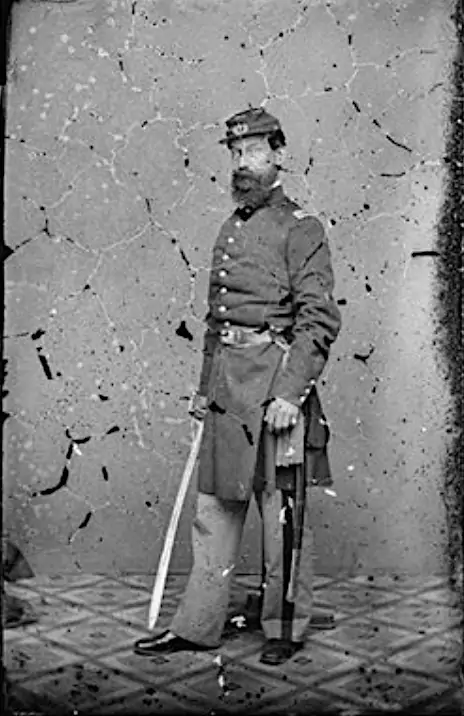
ARROWSMITH, WILLIAM G. (also enlisted as DEMARBY, (or DeMARBEY, De MARBY), THOMAS) (1840-1864). Private, 83rd Pennsylvania Infantry, Company H. As per his pension index card, DeMarbey was an alias; his real name was William G. Arrowsmith. He enlisted as Thomas Demarby on September 28, 1863, mustered into the 83rd Pennsylvania, and was discharged for disability on March 9, 1864. As per his death certificate, Arrowsmith died in Brooklyn on May 1, 1864; his pension lists the same discharge date but reports that he died in May 1863. His death certificate lists his occupation as soldier. On June 30, 1864, his wife applied for and received a widow’s pension, certificate 222,014. In 1879, Kate L. Howell applied as a guardian for a minor’s pension that was granted under certificate 222,015. Section ?, lot ?.
ARTHUR, EDWARD GERALD (1843-1924). Private, 7th Regiment, New York State National Guard, Company I. After enlisting on May 25, 1862, Arthur, a native of New York, served for three months with the 7th Regiment before mustering out with his company on September 5 of that year. He was a member of the Seventh Regiment Veteran Corps and headed its Executive Committee. In 1911, he received a pension, certificate 1,167,521. His last residence was 310 West 80th Street in Manhattan. Arthur died from nephritis. Section 122, lot 2114.
ARTHUR, WILLIAM (1836-1924). Private, 15th New York Engineers, Company B. Of Scottish origin, Arthur enlisted as a private at New York City on May 9, 1861, and mustered into the 15th New York Engineers on June 17. Other details of his service are not known. He last lived on Fifth Avenue in Brooklyn. Section 7, lot 8877.
ASCHE, HENRY THOMAS (1844-1904). Private, 12th Regiment, Company C, National Guard, State of New York; Landsman, United States Navy. Born in New York City, Asche was 5’8″ tall, with a fair complexion, light hair, and blue eyes. He enlisted as a private in the 12th on May 27, 1862, and was discharged on October 2, 1862. He then enlisted as a landsman in the United States Navy on January 16, 1865, and was discharged on September 6, 1865. He served aboard the USS Shamrock, Princeton, and Vermont. As per the census of 1880, Asche was a glove dealer. He last lived at 244 Putnam Avenue in Brooklyn. His death was caused by atrophy. Catherine Asche, who is interred with him, applied for and received a widow’s pension, certificate 21,690. Section 142, lot 24415, grave 11.
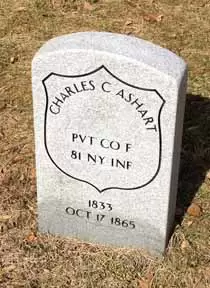
ASHART (or ARHART), CHARLES (1833-1865). Private, 81st New York Infantry, Company F. Of German birth, he enlisted on April 7, 1865, at New York City, mustered into the 81st New York that day, and mustered out on August 31, 1865, at Fort Monroe, Virginia. He died of diarrhea at his Brooklyn residence on October 17, 1865. Section 115, lot 13536 (Soldiers’ Lot), grave 104.
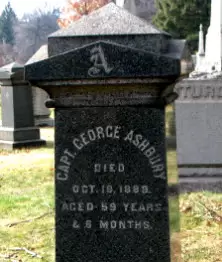
ASHBURY, GEORGE (1839-1889). Acting master, United States Navy. By one account, Ashbury was born in Massachusetts; another has him a native of Ireland. After he was commissioned into the United States Navy on August 25, 1861, as an acting master, he served on board the USS Ohio and the USS Stars and Stripes and engaged in the actions of the East Gulf Squadron prior to his discharge on December 8, 1865. Although his tombstone is engraved “Captain George Ashbury,” it is uncertain when he was promoted to that rank. His last residence was 124½ 11th Street in Brooklyn. Ashbury died from heart disease. Section 138, lot 26829.
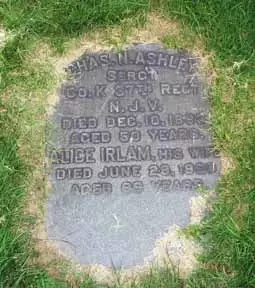
ASHLEY, CHARLES N. (or C.) (1843-1893). Sergeant, 37th New Jersey Infantry, Company E; private, 26th New Jersey Infantry, Company K. Ashley was born in East Hartford, Connecticut. He enlisted on September 3, 1862, served in the 26th New Jersey, and was discharged for disability on December 1, 1862, at Hagerstown, Maryland. He re-enlisted as a private on May 23, 1864, mustered into the 37th New Jersey Infantry on June 23, 1864, was promoted to corporal on May 31, and then to sergeant the next month on June 24. Ashley mustered out on October 1, 1864, at Trenton, New Jersey. He last lived at 264 Lexington Avenue in Brooklyn. His death was caused by heart valve disease. Alice Irlam Ashley, his widow, survived him. Section 135, lot 27263, grave 1714.
ASHTON, HENRY H. (1842-1878). Sergeant, 56th Massachusetts Infantry, Company H; 10th Massachusetts Infantry, Company K. Originally from Lewiston, Maine, he enlisted at Boston, Massachusetts, as a private on January 14, 1864, and mustered into the 56th Massachusetts at Readville, Massachusetts, on January 27. As per his muster roll, he was a painter who was 5′ 7″ tall with black eyes, black hair and a dark complexion; he was paid a bounty of $25 with a one month advance of $13. Ashton was promoted to corporal on April 11, 1864, and detailed to Brigade Headquarters. His muster roll of August 31, 1864, shows that he was due 44 cents for his haversack and $1.50 for his canteen; his muster roll for October 1864 indicates that he was paid a bounty of $125 as a veteran. According to his muster roll of February 1865, he was promoted to sergeant on January 1, 1865. Ashton’s muster roll for April 1865, indicates that he was paid a bounty of $175.00 and was due $225.00. He was reduced to ranks on July 7, 1865, and owed $13.08 for transportation. He also served in the 10th Massachusetts but the dates are unknown. His last address was 47 Bedford Street in New York City where he died from cirrhosis. In 1885, Emma Ashton, applied for a widow’s pension, application 325,108. In 1890, an application for a minor’s pension was filed, application 422,199. Section 17, lot 17245, grave 1370.
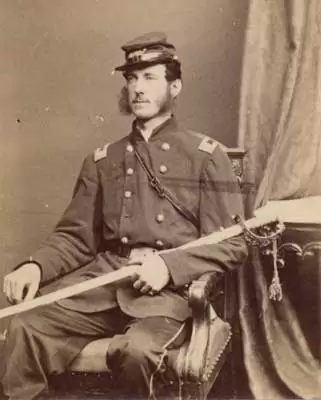
ASPINWALL, LLOYD (1834-1886). Colonel, 22nd Regiment, New York State National Guard. Born in New York City, Lloyd Aspinwall succeeded his father in the shipping firm of Howland & Aspinwall, described by The New York Times as “pioneers in quick transportation cross Panama.” The town of Aspinwall, on the isthmus of Panama, derived its name from the firm.
After eight years with the State troops, Aspinwall enlisted in the Army in 1861, and was active in the organization of the 22nd Regiment of the New York National Guard. When he re-enlisted on May 28, 1862, at New York City, he was immediately commissioned in as its lieutenant colonel, and mustered out after three months on September 5 at New York City. In 1863, he was promoted to colonel on June 18, the same day he was commissioned into the 22nd, and mustered out at New York the next month on July 24. He was in charge of purchase and supply for the vessels that attacked New Berne, North Carolina, and was president of the board of officers that revised Army regulations. He was an aide to General Ambrose Burnside at the Battle of Fredericksburg, Virginia, and delivered the first reports of that engagement to President Lincoln.
Remaining active in military affairs after he returned to his business, Aspinwall was elected brigadier general of the 4th Brigade of the New York State National Guard and had command of the 1st Division. He was also president of the State Military Association and a founder of the Army & Navy Club and became its president in 1877. He was a major force in establishing rifle ranges which were later incorporated into the military system. In 1880, he was appointed engineer-in-chief to the military staff of the governor of New York. A staunch Republican, Aspinwall was approached about becoming a candidate for mayor of New York City in 1880, but he declined to seek the nomination. He last lived at 25 East 10th Street. He died suddenly of apoplexy while vacationing in Bristol, Rhode Island. Section 21, lot 2076.
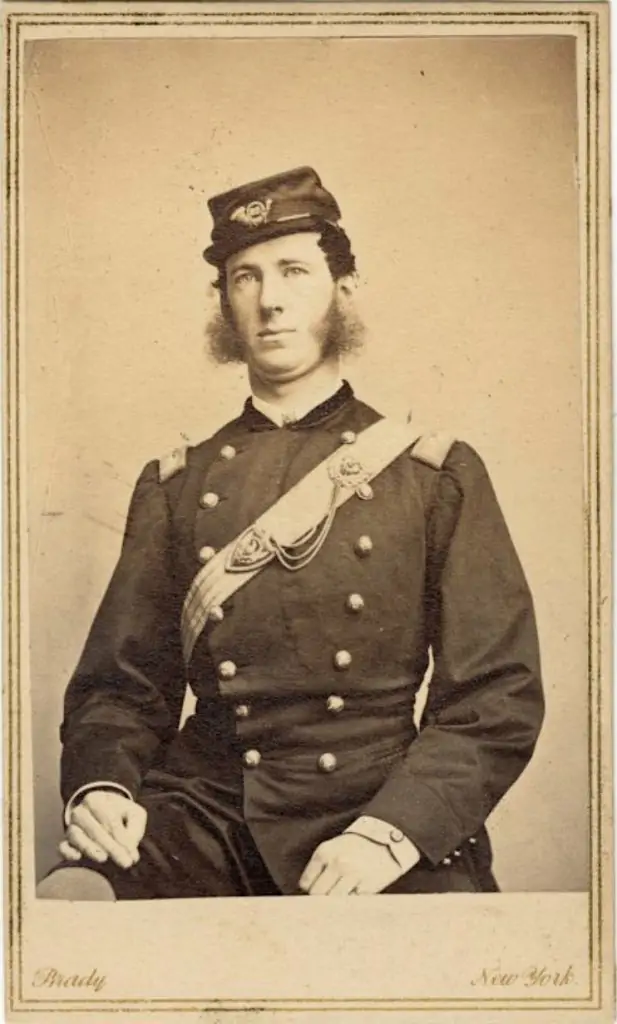
ASPINWALL, WILLIAM HENRY (1807-1875). Merchant and transportation pioneer. Born in New York City, he apprenticed as a clerk to his uncles Gardiner and Samuel Howland (see), whose firm traded with Mexico, England, and the Mediterranean countries. In 1837, he and William Edgar Howland took control of the firm, re-named Howland & Aspinwall, the largest trading house in New York. With a fleet of up to eighteen ships, it had the largest trade with the Pacific of any New York firm, and also traded extensively with the East and West Indies. Aspinwall’s reputation in world trade was unrivaled. His firm had an absolute monopoly on American trade with Venezuela and a virtual monopoly on American trade with Mexico. Propelled by gold fever and the rush to California, he shifted his attentions in 1848 and 1849 to the creation of the Pacific Mail Steamship Company and the Panama Railroad. This fleet of ships, and the railroad, gave him and his partners a virtual monopoly on commerce between New York and California until 1869, when the Union Pacific Railroad was completed. When, in 1855, the railroad across the Isthmus of Panama was completed, the town at its eastern terminus was named Aspinwall in his honor. The railroad’s profits made him one of the richest men in New York.
During the Civil War, he was an active supporter of Lincoln and a founder and vice president of the Union League Club. He offered to send ships at his own expense to privately restock the besieged garrison at Fort Sumter. After Major Robert Anderson surrendered the fort to Confederates, Anderson became a hero of Unionists, and Aspinwall hosted a dinner in his honor in New York. Though Aspinwall supplied many of the Pacific Mail’s ships to the Union, and Howland & Aspinwall acted as a government purchasing agent in England and Europe for arms, ammunition, and other equipment, Aspinwall refused all war profits, returning checks to the government for any payment in excess of costs. In 1863 he went to England as a secret emissary for Gideon Welles, secretary of the Navy, in an effort to convince the British Government to seize the ships and iron-clad rams which were being built there for the Confederacy. He was a leader of the Chamber of Commerce, a founder of the Lenox Library and he Metropolitan Museum of Art, and a charter member of the Society for the Prevention of Cruelty to Animals. At the time of his death he was president of the American Church Missionary Society. He owned one of the finest and largest art galleries in New York, composed largely of paintings by European masters such as Titian, Correggio, and Da Vinci, which he opened on a weekly schedule to the public. Section 21, lot 2076.
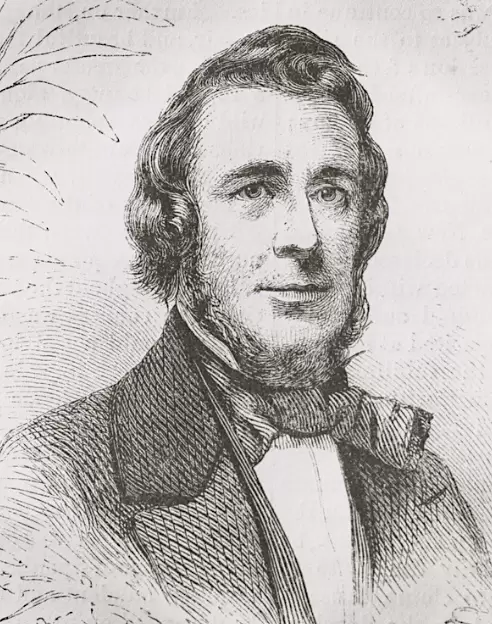
ASTEN, JOHN HENRY (1837-1878). Private, 8th Regiment, New York State National Guard, Company C. Asten, who was born in New York State, enlisted at New York City as a private on May 29, 1862, mustered immediately into the 8th Regiment, and mustered out on September 10, 1862, at New York City. He last lived at 134 Allen Street in Manhattan where his death was attributed to tuberculosis. Section 189, lot 17708.
ASTON, RALPH (1841-1904). First assistant engineer, United States Navy. Born in Middletown, Connecticut, to Henry Hungerford Aston and Ann Shepard Aston, he studied at the Chase Seminary there, then with a private tutor. Ralph began his lifetime career in the United States Navy in 1861, enlisting early in the Civil War as a third assistant engineer. His first assignment was aboard the steam-powered gunboat Cayuga, which was assigned to the West Gulf Station; that ship was the first to pass the lower forts on the Mississippi River during the course of the Union capture of New Orleans. In 1863, he was promoted to second assistant engineer, then first assistant engineer. It was in August 1864 that he took part in the defense of Mobile, Alabama. He also participated in a series of minor engagements along the Gulf Coast.
Long after the Civil War, in 1888, he became a chief engineer, and was promoted to captain in 1899. During the Spanish-American War, he served aboard the cruiser Cincinnati as a part of Admiral William T. Sampson’s fleet. Aston retired from service in 1902, after 40 years in the Navy, due to illness, and went on the retired list as a rear admiral.
In 1869, he married Brooklynite Jennie Preswich. She died in 1876. He married Salena Hinman in 1882. She, as well as two sons, Walter and Albert, and a daughter, Anna, survived him.
He died at his home, 78 Hanson Place, Brooklyn, after two years of battling disease. Section 146, lot 24459.
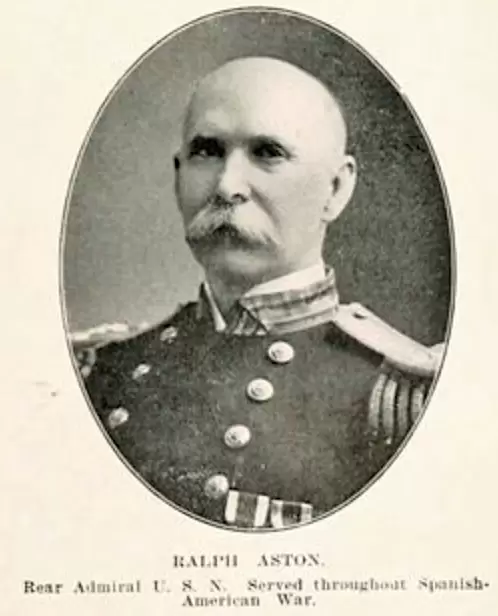
ATKIN, JOHN H. (1835-1887). Private, 13th Regiment, New York State National Guard, Company I. Originally from England, Atkin enlisted as a private at Brooklyn on May 28, 1862, mustered immediately into the 13th Regiment, and mustered out at Brooklyn after three months on September 12. He last lived at 417 8th Street in Brooklyn. Section 181, lot 17650.
ATKINS, THOMAS J. (1838-1909). Private, 67th New York Infantry, Company A. A native New Yorker, Atkins enlisted as a private at Brooklyn on May 14, 1861, mustered into the 67th New York on June 20, and mustered out after three years of service on July 4, 1864, at Brooklyn. In 1892, his application for an invalid pension was granted, certificate 979,573. His last address was on Willoughby Avenue in Brooklyn. Atkins died from pneumonia. Section 153, lot 20407.
ATKINS, WILLIAM H. (1837-1866). Private, 67th New York Infantry, Company G. Serving for three years, he enlisted as a private at Brooklyn on May 20, 1861, mustered into the 67th New York on June 20, and mustered out on July 4, 1864, at Brooklyn. His last residence was at 62 Butler Street, Brooklyn. Section 47, lot 8227.
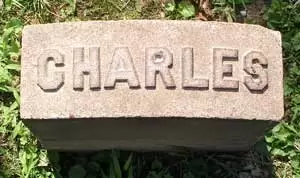
ATKINSON, CHARLES (1829-1888). Second lieutenant, 84th Regiment, New York State National Guard, Company B. Born in Ireland, he enlisted at New York City on July 3, 1863, and was commissioned into Company B of the 84th National Guard as a second lieutenant on the same day. He mustered out at New York City on August 4, 1863. On July 13, 1864, he was commissioned into the same regiment and company and mustered out at the same location on October 29, 1864. He last lived at 846 Seventh Avenue in Manhattan where he died from Bright’s disease. Section 29, lot 13436.
ATKINSON, HOFFMAN (1838-1901). Captain and assistant adjutant general, United States Volunteers Adjutant’s General Department. Atkinson, a native of New York, enlisted as a captain on May 28 1862, was immediately commissioned into the 1st West Virginia Cavalry, but was discharged that same day for promotion and commissioned into the U.S. Volunteers Adjutant General’s Department as a captain and assistant adjutant general. He resigned on April 15, 1863. His last residence was at The Lowell on 120th Street and Amsterdam Avenue in Manhattan where he died from uremia. His obituaries in the New York Herald and The New York Times note that his funeral took place at the Grace Church in Brooklyn Heights; both obituaries refer to Atkinson as a colonel but it is unclear how he achieved that rank. Section 71, lot 2401.
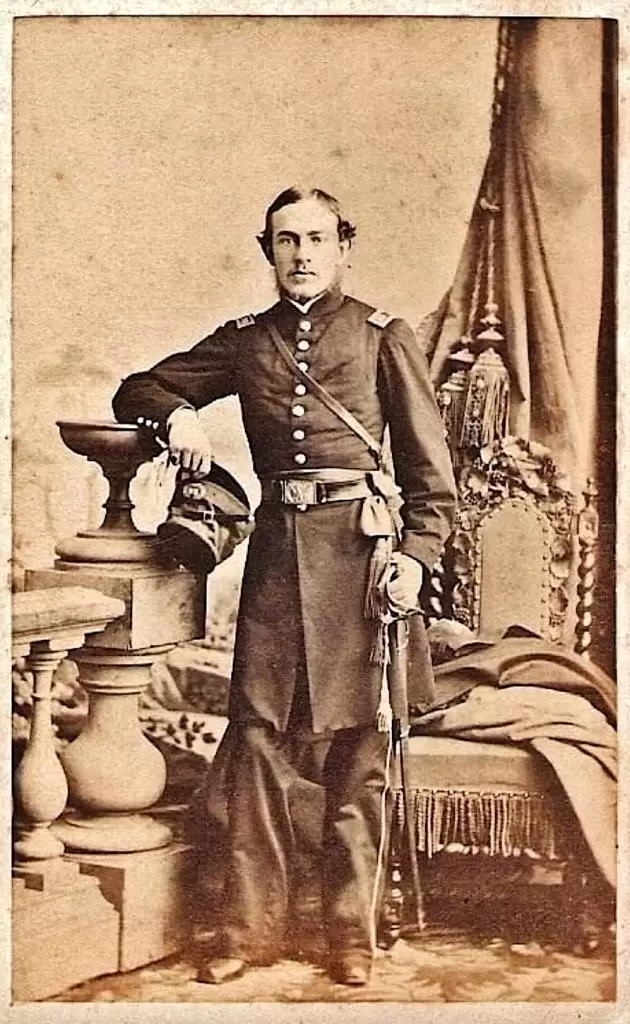
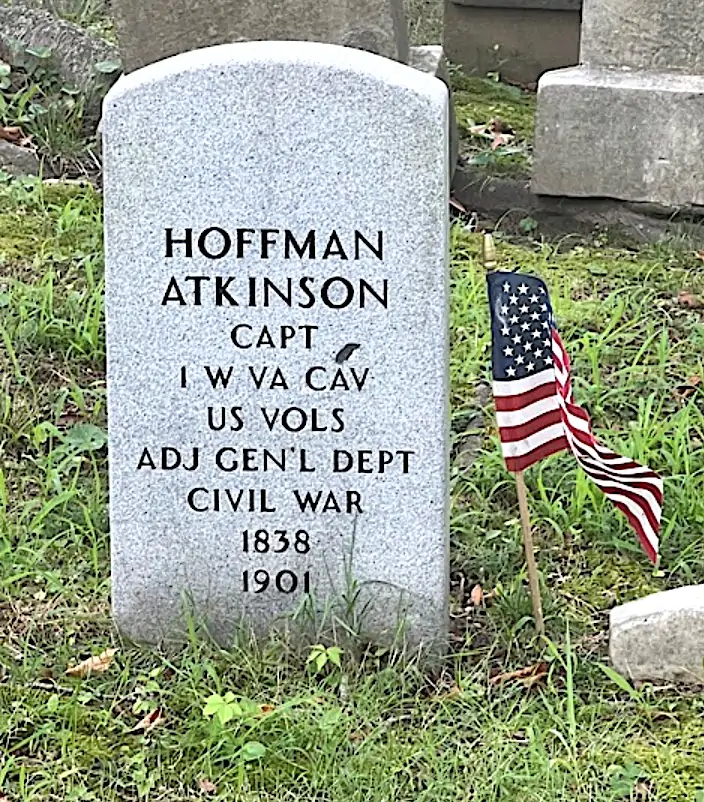
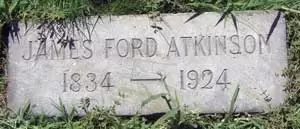
ATKINSON, JAMES FORD (1834-1924). Private, 13th Regiment, New York State National Guard, Company G. Born in Rochester, New York, Atkinson enlisted on May 28, 1862, mustered into the 13th the same day, and mustered out after three months on September 12 at Brooklyn.
In 1904, Ford applied for and received an invalid pension. As per an article in the Brooklyn Daily Eagle on August 30, 1912, a James Ford Atkinson, which may be him, was named as part of a large citizens’ committee preparing for a 50th anniversary celebration of the Battle of Antietam planned by the War Veterans and Sons’ Association. The event, scheduled to take place in Prospect Park on September 21, 1912, had the support of the New York State G.A.R., the 14th War Veterans Association and local leaders; survivors of Antietam would be honored guests. He last resided at 196 Berkeley Place in Brooklyn. Atkinson died from gastric disease.
An article in The New York Times on November 4, 1924, enumerated the appraisal of Atkinson’s estate bequeathed to his son and three daughters. His real estate at 196 Berkeley Place was valued at $14,500; he also had bank deposits and owned jewelry and other personal property. Section 147, lot 22294.
ATKINSON, THOMAS (1842-1918). Private, 9th New York Infantry, Company B. Originally from Ireland, he enlisted as a private at New York City on May 2, 1861. On May 4, he mustered into the 9th New York Infantry and served with the regiment until he mustered out on May 20, 1863, at New York City. He applied for and was granted an invalid pension in 1872, certificate 173,360. Atkinson’s last residence was 221 West 121st Street, New York City. His death was attributed to heart disease. Section 137, lot 27508, grave 3.
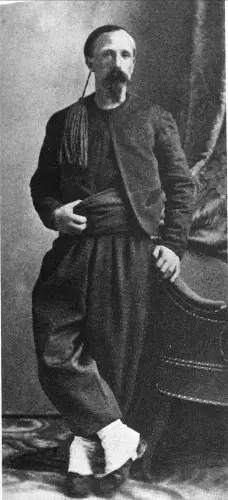
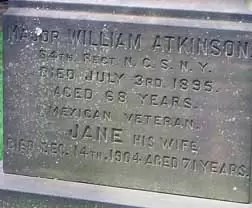
ATKINSON, WILLIAM (1827-1895). Captain, 84th Regiment, New York State National Guard, Company B. Of Irish birth and a veteran of the Mexican War, he enlisted at New York City on July 3, 1863, was commissioned into the 84th that same day, and mustered out at New York City after 30 days on August 4. The next year, when his regiment was reactivated, he was commissioned into the same company on July 13, 1864, and mustered out after 100 days on October 29. He lived in New York City at 154 West 50th Street after the War but died from chronic diarrhea in the New York City Asylum on Ward’s Island. Section 29, lot 13436.
ATTERBURY, WILLIAM (1821-1905). Lieutenant colonel, 83rd New York Infantry, Company G. A native New Yorker, he enlisted there as a captain on May 27, 1861, and was commissioned into the 83rd New York. The next month on June 8, he was promoted to major and transferred to the Field and Staff. After his promotion to lieutenant colonel on January 7, 1862, he commanded the 83rd in Maryland at the Battle of South Mountain on September 14, 1862, and at Antietam on September 17. Atterbury was discharged on September 30, 1862.
As per the Brooklyn Directory for 1867-1870, Atterbury was a clerk who lived at 18 Tillary Street. The Brooklyn Directories for 1870-1873 and 1880-1882 list him as a bookkeeper who lived at 209 Dean Street. In 1894, he applied for and was granted an invalid pension under certificate 907,627. According to his obituary in the Brooklyn Daily Eagle, which reports that he was a Civil war veteran, he had lived in Brooklyn for sixty years and was a Freemason, member of the Society of Old Brooklynites and member of Washington Street M. E. Church, which later merged with the Hansen Street M. E. Church. That obituary notes that his wife’s death in May of 1905 left him depressed. His obituaries in the Brooklyn Standard Union and the New York Herald, which also confirm his Civil War service, report that he last lived at 209 Dean Street in Brooklyn, where he had lived for thirty-six years. He died at 100 Elm Street in Montclair, New Jersey, the home of his son and where his funeral took place. His death was attributed to senility and an intestinal ulcer. Atterbury was survived by two sons and three grandchildren. Section 22, lot 9771, grave 3.
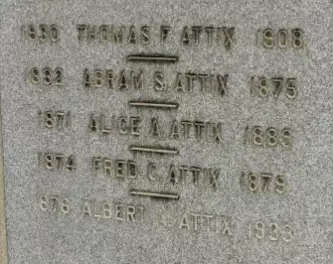
ATTIX, ABRAM S. (1832-1875). Second lieutenant, 1st New York Light Artillery, Batteries B and A. Born in New York and a carpenter by trade, Attix enlisted as a first sergeant at Chicago, Illinois, on September 28, 1861, and mustered into Battery B of the 1st New York Light Artillery the same day. On April 18, 1864, he was promoted to second lieutenant and transferred to Battery A. He was discharged for disability on August 19, 1864, at Tennessee. His last residence was 181 South Oxford Street in Brooklyn where he died from heart disease. Although cemetery records notes that he died on May 27, 1873, his tombstone indicates 1875 as the year of death. His remains were moved to the present location on July 24, 1891. Section 147, lot 27596.
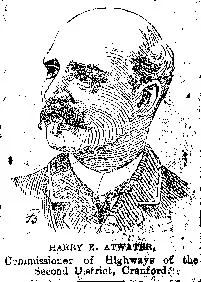
ATWATER, HARRY ELIHU (1845-1918). Private, 162nd Ohio Infantry, Company A. Atwater, an Ohio native, first served when Ohio’s Governor David Tod asked for volunteers on September 1, 1862, to come to the defense of Cincinnati against the menacing Confederate Army led by General Kirby Smith in Kentucky. When the threat passed two weeks later, the 16,000 Ohioans returned home, known as “squirrel hunters” by Confederate scouts who viewed them as “farm boys that never have to shoot at the same squirrel twice.” Subsequently, he enlisted as a private on May 2, 1864, mustered into the 162nd Ohio National Guard on May 20, and mustered out of service on September 20, 1864, at Camp Chase, Ohio. The regiment was assigned to duty at Tod Barracks, near the state capital, Columbus, during its activation.
Atwater and his brother moved to New York City after the Civil War and opened a produce business, J. M. Atwater & Bro., at 61 Pearl Street. After relocating to Cranford, New Jersey, in 1870, he maintained his business and is listed in the New York City Directory for 1875-1876 as being in the produce business at 65 Pearl Street; he then lived at 458 Vanderbilt Avenue in Brooklyn. Subsequently, he became a commission produce merchant, moving to 83 Warren Street in the 1880s and working there throughout his life. Active in community life in Cranford, he was elected to the town committee in 1878 and 1881, and served as commissioner of highways in 1890. In the early 1870s, he and his brother donated the lot on which the Trinity Episcopal Church was built and where he was a warden and vestryman. In 1895, he donated the land for the church rectory. He applied for a pension in 1907, application number 1,364,684. His last residence was 313 North Avenue in Cranford, New Jersey. Atwater died from stomach cancer. His widow, Catharine Atwater, applied for a pension after his death in 1918, application 1,129,486. Section F, lot 20112.
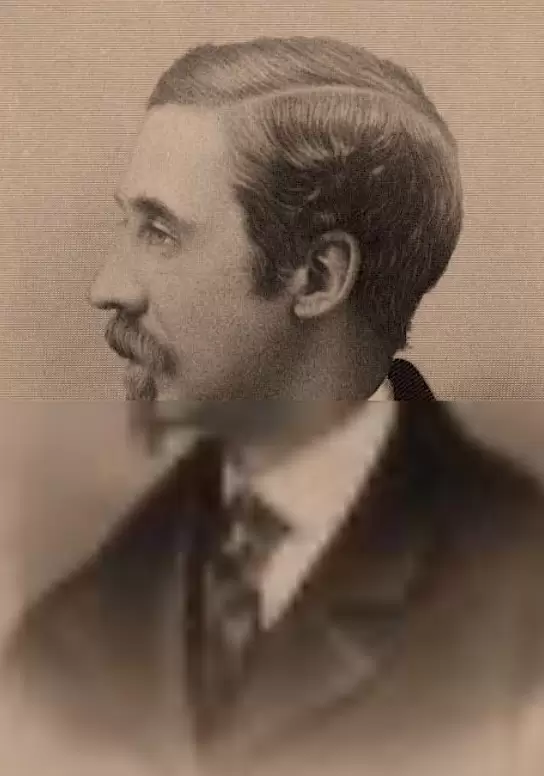
AUCHMUTY, RICHARD TYLDEN (1831-1893). Colonel by brevet and philanthropist; captain and assistant adjutant general, United States Army. Born in New York City into a prominent family, he studied at Columbia College, then studied architecture with James Renwick Jr., and became his partner. When the Civil War began he was commissioned a captain in the Army, and fought with the 5th Corps in many battles. In his field reports, Brigadier General George W. Morell, United States Army, commended Auchmuty and his other aides from New Bridge, Virginia, on June 7, 1862, “for the prompt and cheerful performance of duty and accurate transmission of orders; their zeal at times leading them to incur greater exposure than the exigencies of the moment required…”
Auchmuty described his experience in the Battle of Gaines’ Mill, Virginia, in a letter to his mother on June 28, 1862: I sincerely thank God for my escape. I have had experience in shelling and volleys of musketry, but never, until now, of a continuous sheet of fire for six hours. My horse was shot and ran away with me (my new horse), nearly dashing my brains out against the peach trees. In a letter dated July 5, Auchmuty reflected on the horrors he had experienced over the previous ten days, “War is a horrible thing. I never want to hear anyone talk of military glory; it only reminds me of scenes of horror and anguish.” Worn out with fatigue by a war with no end in sight, he wrote that “England and France will, I suppose, recognize the rebels if nothing more.”
His many intense battle experiences had taken their toll; he decided to tender his resignation from the Army. On July 21, Morell wrote from Harrison’s Bar, Virginia, in response to Auchmuty’s resignation citing his promptness and cheerfulness “…although far from well” since his horse was shot at Gaines’ Mill. Morell added, “Captain Auchmuty has labored faithfully in the office and fearlessly in the field wherever my command has been engaged, at Howard’s Bridge, Yorktown, Hanover, Court-House, Mechanicsville, Gaines’ Mills, Malvern, etc.” Auchmuty’s resignation was accepted on August 18, 1862, but he was reappointed assistant adjutant general in March 1863, and assigned to the staff of General S.W. Crawford, commanding the Pennsylvania Reserves stationed in the “defences (sic) of Washington.” Auchmuty participated in the battle at Chancellorsville, Virginia, and on May 4, 1863, wrote his mother: At 5:30 a really tremendous battle commenced. Three lines were formed, we, with Sykes, being the third. Towards eight o’clock the two outer lines were gone, and we stood face to face with Stonewall Jackson….The Southerners fought more furiously than ever before; we held their line of retreat and they retook it.
Auchmuty served on General Meade’s staff, and with Meade’s approval was brevetted colonel for gallantry at Gettysburg, Pennsylvania. In a letter to his mother on July 6, 1863, he began his long account of the gallant participation of the Pennsylvania Reserves as follows: “The battle of Gettysburg was the greatest engagement this continent has ever seen….We arrived on the battle-field at 11 A.M. [of July 1], lay in a wheat field in the rear until four, when the battle commenced to make the hills roar.” Two weeks after Gettysburg, on July 18, he expressed his frustration over the progress of the war to his mother: “I wish we could catch Lee and finish the war, but the Army of Northern Virginia is not easy either to catch or to beat.” Weakened and sickened by the war, he again offered his resignation in March 1864, but was asked to withdraw it and in July 1864, was assigned as assistant adjutant general to General Cook who was in charge of defending Washington from Confederate General Jubal Early’s attacks. In a final effort, Auchmuty tried again to resign in December 1864, but Lincoln’s Secretary of War, Edwin Stanton, declined to accept it. He was instead awarded the rank of major, and in January of 1865 was recommended for brevet lieutenant-colonel by General S.W. Crawford of the 5th Corps. Crawford cited Auchmuty for “his conspicuous gallantry during the battle of Gettysburg” and “his untiring energy and earnest devotion to the service, not only in his own department, but in other departments of the staff.” The brevet was issued and he was honorably discharged and mustered out on June 7, 1865.
After the Civil War, Auchmuty was a pioneer of the summer colony in Lenox, Mass., which he built into a fashionable residence (still standing) and where he held several public offices. He also worked as an architect, designing St. Mary’s Episcopal Church (1858-1859) at 230 Classon Avenue, Brooklyn; it was designated a New York City landmark in 1981. Following his retirement as an architect he devoted himself to matters in Lenox and to the New York Trade School, which he founded in 1881. This school offered poor young men who were mechanically inclined an opportunity to learn the building trades without a long apprenticeship. His school changed trade education in America by combining theoretical instruction and shop practice. He and his wife (Ellen Schermerhorn Auchmuty) financed this school from 1881 until 1892; it was then incorporated and endowed by J. Pierpont Morgan. He was also a vestryman of Trinity Church in Manhattan. In March of 1893, his leg was amputated and buried at Green-Wood Cemetery; he joined it at Green-Wood four months later. He died from edema of the lungs in Lenox, Massachusetts. Section 112, lot 16135.
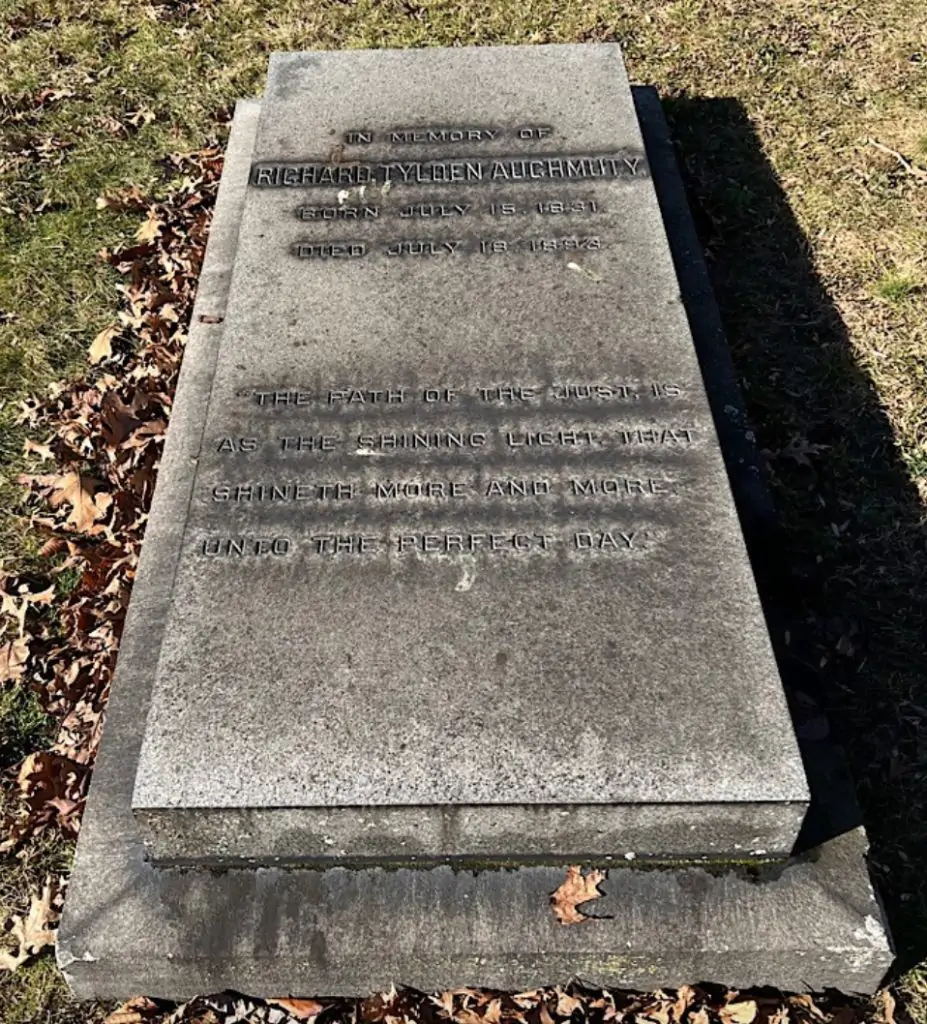
AUERSWALD, BRUNO (1836-1874). Private, 158th New York Infantry, Company E. Originally from Germany, Auerswald immigrated to the United States departing from Bremen, Germany, aboard the Athena and arriving at New York City on November 24, 1858. He enlisted at Brooklyn as a private on August 26, 1862, and mustered into the 158th five days later. He was discharged on May 22, 1865, at New Berne, North Carolina. Auerswald became a naturalized citizen on December 13, 1869. He died from tuberculosis at Long Island Kings County Hospital. Section 17, lot 17245, grave 748.
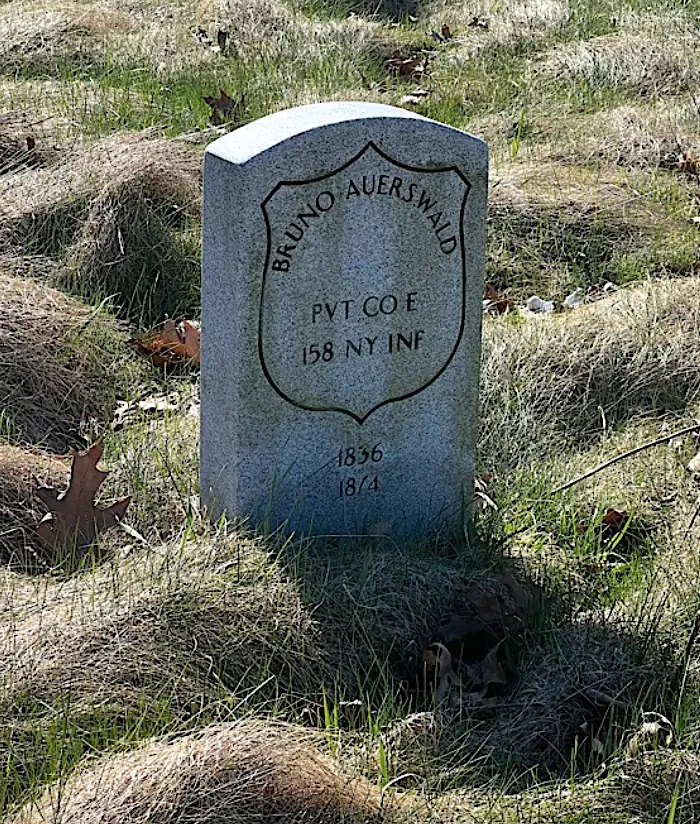
AULT, GEORGE W. (1830-1910). Private, 14th Massachusetts Light Artillery, Battery A. A native of Coventry, Connecticut, Ault was employed as a shirt-maker when he enlisted at Boston, Massachusetts, as a private on February 13, 1865, the same date that he mustered into Battery A of the 14th Massachusetts Light Artillery. As per his muster roll, he was 5′ 9″ tall with black eyes, dark hair and a dark complexion. Ault was paid a bounty of $100, of which $33.33 was paid initially and $66.67 was to be paid later; he enlisted for one year “unless sooner discharged by proper authority.” At the time of his enlistment, the examining surgeon found him to be sober, free of bodily defects and fit for duty; Ault swore his allegiance to the United States of America and promised to obey the orders of the President. He mustered out on June 15, 1865, at Readville, Massachusetts.
As per the Brooklyn Directory for 1873-1876, Ault was in the shirt business at 781 Fulton Street. The Brooklyn Directory for 1880-1882 reports that he was a shirt manufacturer at 769 Fulton Street; he then lived at 111 South Oxford Street in Brooklyn. The 1890-1892 Brooklyn Directory lists him as a shirt manufacturer; his home address was at 17 Greene Avenue in Brooklyn. Remaining active in military affairs, Ault was a member of the George C. Strong Post #534 of the G.A.R. In 1901, he successfully applied for a pension, certificate 1,041,291.
According to his obituary in the Brooklyn Daily Eagle, Ault had been in the shirt-making business for thirty-two years. He was inventor of the coat shirt and yoke that were popular fashions of the day. That obituary states that he was active in the Freemasons as of 1884 and was the commander of the Strong Post of the G.A.R. at the time of his death. His last residence was 17 Greene Avenue in Brooklyn. Ault died from pulmonary edema at St. Mary’s Hospital in Brooklyn, a complication of an earlier bout with bronchitis. He was survived by a daughter, seven grandchildren and one great-grandchild. Section 128, lot 31262, grave 30.
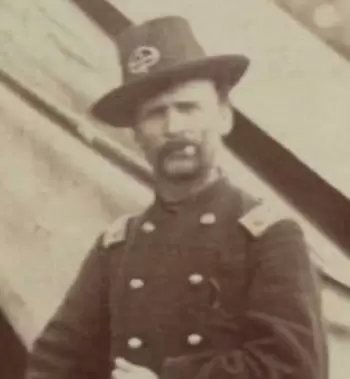
AUSTIN, JOHN S. (1812-1865). Colonel, 72nd New York Infantry, Company K. After he mustered in as captain of Company K of the 72nd New York in 1861, John Austin became acting brigade quartermaster on the staff of Brigadier General Daniel Sickles, and then colonel of the 72nd. On the second day of the Battle of Gettysburg, Pennsylvania, shell fragments injured his right hand and arm. He described this incident in a field report written in Virginia on August 23:
…At 2 p.m. we were ordered to advance across an open field in line of battle, the left of our regiment, which formed the extreme left of the brigade, resting on a cross-road, the line running parallel with the main road and in rear of the peach orchard. We remained in line of battle about two hours, under a most terrific fire of shot and shell, when we were pressed so hard on the left flank that we were obliged to fall back. This we did in as good order as the circumstances would permit. At this time I was wounded in the arm and side and a few minutes after had my horse killed. I was now obliged to give up the command to Lieutenant Colonel Leonard, who fought the regiment after I left. He and the rest of the officers were indefatigable in their exertions to rally the men, who were still hard pressed…
In 1864, Austin was discharged for disability and he died a year later. He last lived on 110th Street in Manhattan where he died from liver disease. Section 45, lot 6218.
AUSTIN, MYRON (1840-1904). Private, 8th Regiment, New York State Militia, Company K. Originally from Connecticut, Austin enlisted in 1861, mustered into the 8th Regiment and served for three months. He was a member of the G.A.R., George C. Strong Post #534. In 1891, his application for an invalid pension was approved, certificate 920,135. His last residence was 773 Putnam Avenue in Brooklyn. Austin died from apoplexy. Section F, lot 19877, grave 5.
AVANT, JOSEPH (1833-1866). Acting master, United States Navy. Born in Ireland, Avant enlisted in the United States Navy as a mate on January 7, 1862, rose to acting ensign on October 22, 1862, and became an acting master on May 8, 1865. He died at the Naval Hospital in Brooklyn of remittent fever. Section 168, lot 17408.
AVERY, CYRUS B. (1834-1879). First lieutenant, 158th New York Infantry, Company B. Avery, who was born in New York State, enlisted as a sergeant at Brooklyn on August 20, 1862, and mustered into Company B of the 158th New York nine days later. On July 11, 1863, he was promoted to first sergeant of his company and became its first lieutenant on September 6, 1864. He was discharged from military service on June 30, 1865, at Richmond, Virginia. His last residence was 116 3rd Street in Brooklyn. His death was attributed to tuberculosis. Section 15, lot 17263, grave 1342.
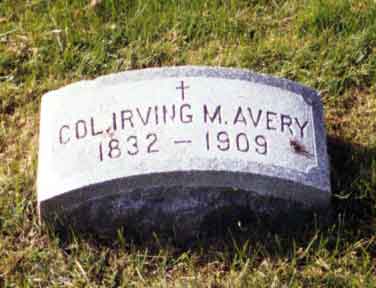
AVERY, IRVING (or IRWIN) MONTGOMERY (1832-1909). First lieutenant and quartermaster, 48th New York Infantry. Avery enlisted as a first lieutenant at Brooklyn on June 24, 1861, and was promoted to the rank of first lieutenant and quartermaster on that date. On September 5, 1861, he was commissioned into the Field and Staff of the 48th Infantry and mustered out on September 20, 1864.
In 1905, Avery applied for and was granted an invalid pension, application 1,342,390. His obituary in the New York Herald confirms his Civil War service. He last lived in Auburn, New York. He died from congestive heart failure at the home of his son, Frank Avery, in Sparta, New Jersey; his funeral was held in Sparta. Auburn newspapers were requested to print a notice of his death. Section 152, lot 17964.
AVERY, WILLIAM N. (1831-1916). Corporal, 46th Illinois Infantry, Company D. Avery, who was born in New York City, enlisted as a private at Freeport, Illinois, on November 30, 1863, mustered into Company D of the 46th Illinois on January 30, 1864, and was promoted to corporal of his company at some point. He was discharged on January 20, 1866, at Baton Rouge, Louisiana. He applied for and was granted an invalid pension, certificate 611,489. His last residence was 213 Watchung Avenue in North Plainfield, New Jersey. Avery died from bronchitis. Section 41, lot 4044.
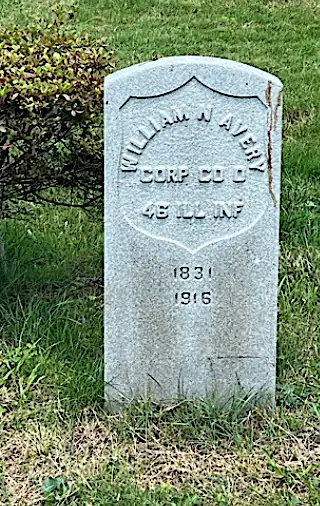
AVILA, EDWARD C. (1844-1920). Private, 84th New York (14th Brooklyn) Infantry, Company D. Avila enlisted at Brooklyn on August 29, 1862, mustered in the next day, and was discharged for disability on February 26, 1863, at New York City. He applied for and received an invalid pension in 1879, certificate 170,921. Avila is listed in the 1890 Brooklyn Veterans Census. He last resided on University Avenue in the Bronx where he succumbed to a cerebral hemorrhage. His widow, Fanny C. Avila, applied for a pension in 1920, application 1,165,493. Section 54, lot 3235.
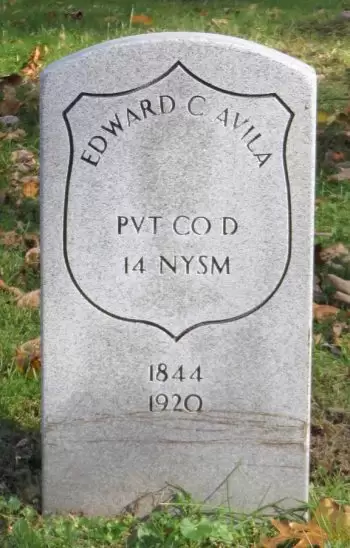
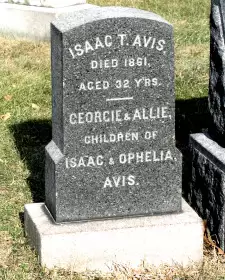
AVIS, ISAAC TUCKER (1829-1862). Private, 84th New York (14th Brooklyn) Infantry, Company C. A salesman by trade, he enlisted on April 18, 1861, and mustered in on May 23. In May of 1862, his fellow soldier Charles B. Tobey wrote, “…he was seized with severe sickness and prevented for some time from performing his duty…” Avis was first treated at the regiment’s hospital and was transferred to Carver Hospital in Washington, D.C., where he died of typhoid fever and pneumonia on May 29, 1862.
Avis’s funeral was held at his father’s residence on Duffield Street in Brooklyn to which members of his regiment were invited. His tombstone incorrectly lists the year of his death as 1861. Two of his children, George and Alfred, who died when they were young, are interred with him. Naomi A. Avis applied for and was granted a widow’s pension on September 9, 1862, application 2,538. Section 174, lot 24573.
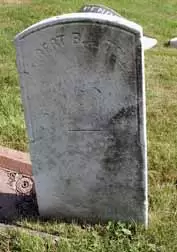
AXTELL, ALBERT BARNES (1832-1893). Acting master’s mate, United States Navy. On January 20, 1862, Axtell enlisted in the United States Navy as an acting master’s mate. Assigned to the John P. Jackson on February 6, 1862, he was listed as an officer of that vessel as of February 22. Subsequently attached to the Courier, his name appeared on the journals of that ship on November 6, November 17, and December 5, 1862. He was engaged in action resulting in the capture of New Orleans, Louisiana, and resigned on December 19, 1862, stating, “I respectfully offer my resignation as an Acting Master’s Mate on account of severe illness of my family, and I beg leave to state that as I am almost wholly ignorant of seamanship and navigation, I find I am incompetent to perform many of my duties satisfactorily.”
Axtell is listed as a seaman in the 1863 Brooklyn Directory. As per the Brooklyn Directories for 1864, 1865 and 1866, he was a milkman. The Brooklyn Directories for 1873-1876 and 1892-1894 list him as a driver (carman); the last directory lists a home address at 781 Union Street. His last residence was 781 Union Street in Brooklyn. Shortly after his death, Alice Axtell applied for a widow’s pension. Section 135, lot 27263, grave 532.
AYER, CALEB R. (1843-1915). Sergeant, 7th Maine Infantry, Company D; private, New Hampshire Militia. Caleb Ayer was born in Newfield, Maine. As per the 1850 census, he was seven years old, living with his father George, mother Deborah, and three siblings. By 1860, when he was 17 years old, he was living in a Somersworth, New Hampshire boarding house and working as a machinist. The census shows several of the residents of this boarding house also coming from Maine, perhaps including friends from home.
As per his enlistment papers, signed on April 26, 1861, he was a moulder who swore allegiance (see below), before a justice of the peace, to the State of New Hampshire and the United States of America when he volunteered to serve in the military. The recruiting officer who signed his enlistment papers noted that Ayer was 5′ 9″ tall, with dark complexion, eyes, and hair. Ayer signed up, in the first days of the Civil War, to serve three months.
After his service with the New Hampshire Militia, according to the Report of the Adjutant General of the State of Maine, he, as an 18-year-old resident of Portland, enlisted as a sergeant in the 7th Maine Infantry on September 7, 1861, and was discharged just over a year later, on October, 22, 1861, at Philadelphia, Pennsylvania. However, the 1890 Veterans Census notes a longer term of service. He is recorded, as living in Jamaica Plains, Massachusetts, and apparently based on information supplied by a resident, as having enlisted on April 11, 1861, and having served in the 7th Maine for two years, five months, and 27 days, with the rank of orderly sergeant, and being discharged on October 8, 1863. His disability is recorded as varicose veins.
On July 1, 1863, Caleb registered for the draft. At that time, he was living in Newfield, Maine; his service in the 7th Maine, and his discharge from that unit, were noted.
After his separation from the military, Caleb worked in various industries: for the newly formed Portland and Ogdensburg Railroad Company, in the asphalt and paving industry, as an agent for Limmer Rock Paving, a boiler manufacturer, and as a contractor. At least twice, his occupation on the Massachusetts, Suffolk, Boston Tax Records, was listed as a “Gent.” He married his bride, Mary E Sprague, on the April 12, 1870, and they made their home in Boston. As per the 1883 Boston Directory, he was working as an agent.
According to his Masonic membership card, he was initiated into the Eliot Lodge in 1888 and became a member in 1889. His occupation was listed on that document as a contractor. Those records confirm his birth and death years.
Caleb filed for a Civil War pension on August 25, 1899, application 1234334, that was approved, certificate 1,001,724. He lived out his life in Hingham, Massachusetts, with his wife, where he died on the April 11, 1915, of pneumonia with a contributing cause of arteriosclerosis. Mary quickly followed him just two weeks later; her cause of death was also listed as pneumonia that lasted 12 days; contributing causes to her death included a blood clot and emphysema. No children were found either in census records or his will prepared in the mid 1880s and his estate, valued at $58.26, was bequeathed to Mary. Their ashes were interred together at Green-Wood on November 14, 1915. Section 74, lot 3582.
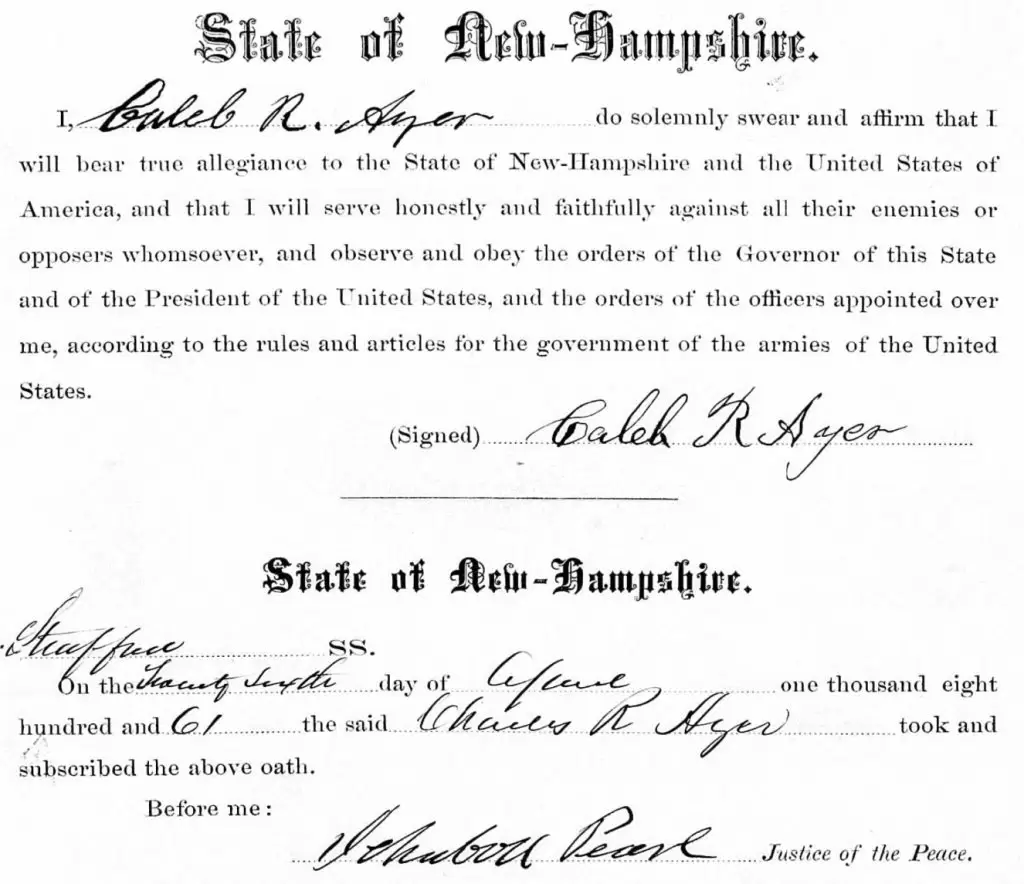
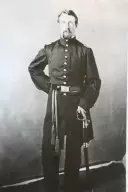
AYER, JR., IRA (1836-1903). Colonel by brevet; lieutenant colonel, 39th Pennsylvania Infantry, Company I. Ayers was born in Evans, New York. After enlisting as a captain on June 20, 1861, he mustered into Company I of the 39th Pennsylvania Infantry that day for a term of three years. He was wounded twice in battle, on August 30 1862, at the Battle of Second Bull Run, Virginia, and on May 6, 1864, at Wilderness, Virginia. Ayer was promoted to major on May 1, 1863, and was transferred to the Field and Staff on that day. He was promoted to lieutenant colonel on February 27, 1864, mustered out on June 11, 1864, at Pittsburgh, Pennsylvania, and was brevetted to colonel on March 13, 1865.
In 1875, he applied for and was granted a pension, application 205,716. As per his obituary in the New York Herald, comrades of the Ulysses S. Grant Post #327 were invited to attend his funeral. He died after a stroke. His last residence was at 37 Cambridge Avenue in Brooklyn. In 1903, his widow, Jennie J. Ayer, applied for and received a pension from New York State, application 779,918. Section 193, lot 31286, grave 2.
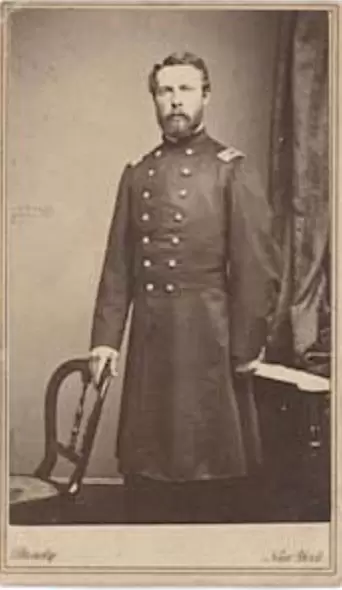
AYERS, JAMES B. (1835-1874). Captain, 14th New York Cavalry, Companies E and B. Originally from England, Ayers enlisted on February 3, 1863, at New York City, as a captain, and was commissioned into Company E of the 14th New York Cavalry on July 20, 1863. The next month, he was transferred intra-regimentally to Company B on August 1. He resigned his commission on December 1, 1863. Ayers’s last residence was in Guntherville, Long Island. He died from pneumonia. Section 7, lot 21832.
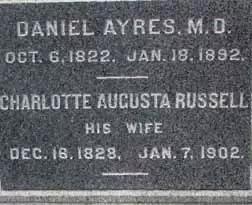
AYRES, JR., DANIEL (1822-1892). Surgeon, Auxiliary Corps of Military Surgeons. The son of a prominent iron merchant, Ayres was born in Jamaica, Long Island, where his family settled during a yellow fever epidemic in New York City. First educated in New York’s public schools, he went to prep school in Middletown, Connecticut, at age thirteen, and then entered Wesleyan University. Disappointed by the scarcity of science courses there, he transferred to Princeton in his junior year and entered New York University Medical School from which he was graduated in 1844. After studying with the renowned physician Valentine Mott (see), he established his practice on Montague Street in Brooklyn. Among the founders of the Brooklyn City Hospital and the Long Island College Hospital, he helped to introduce the practice of clinical instruction and “bedside manner” at the latter.Active in politics, he was among the New Yorkers who met in 1854 to voice their opposition to the Nebraska Act, which allowed settlers in the territories to vote whether their state would enter the Union as a slave or free state, seeing it as a threat to the stability of the country. He was listed as a physician at 156 Montague Street in the 1858 Brooklyn Directory and continued to be listed as such in the Brooklyn Directories for 1862 and 1863.
During the Civil War, Ayres volunteered for the Auxiliary Corps of Military Surgeons, and was commissioned by New York’s Governor Morgan on April 18, 1862. He was sent to Williamsburg, Virginia, where the chapel of William and Mary College was used as an operating room (mainly for amputations) after the capture of Yorktown. According to family history, Ayres recalled that limbs were thrown out the window after amputations; the pile outside the chapel reached to the window sill. Ayres and other volunteer physicians wrote to Dr. S. Oakley Vanderpoel, the surgeon-general of New York, on July 15, 1862, relating their experiences at Williamsburg. An excerpt follows:
…Our services were needed, and we were immediately assigned to the charge of nearly all the wounded in Williamsburgh. These were congregated in William and Mary’s College and the different churches, or scattered about in private dwellings or shanties. The rebel wounded, to the number of seven or eight hundred, were nominally under the care of their own surgeons, some of whom were prisoners, and others of whom had come under a flag of truce for the purpose of attending to their wounded; but from neglect, and the destitution of resources, little regard had been paid to their comfort or to the dressing of their wounds. On our arrival the services of the rebel soldiers were at once dispensed with, and they were sent back to Richmond, and the medical officers of our own army were enabled to join their respective commands, so that we had almost the exclusive care of the wounded. Our work was constant and laborious, a number of capital operations were performed, broken limbs for the first time placed in splints, balls extracted, and a general air of order and cleanliness established. Our visit was a humane one, but has added much to our surgical experience. Our services elicited the surprise and gratitude of the wounded rebels; and independent of any surgical aid afforded, were, we believe, useful in a moral point of view, in showing the wounded prisoners that we still regarded them as our fellow-countrymen, and bore toward them no feelings of hate or hostility….
Ayres went on to thank Drs. Tripler and Smith who were in charge at Williamsburg:
…They were ceaseless in their activity. Possessing, in addition to medical skill, that energy, system and business capacity, without which the operations of an army must be delayed, by the disorder which to a greater or less extent, is consequent upon every battle, they provided for the disabled, sent those that could be removed in safety to the transports in the river, promptly brought order out of confusion, and yet had time to appreciate our services, and to consult for our comfort….
In The Order for the Draft from the New York State adjutant general on October 14, 1862, Ayres was listed as one of the surgeons from Kings County. In March 1863, he was one of the prominent citizens of Brooklyn who attended a rally at the Brooklyn Academy attesting to the loyalty of Brooklynites to the Union and the United States Constitution. He served again in September 1863 when he was re-commissioned by Governor Seymour.
The Brooklyn Directories for 1865, 1866, and 1867-1870 list Ayres as a physician and surgeon at 156 Montague Street; he then lived at 131 Columbia Street. The 1870-1873 Brooklyn Directory notes that he was a surgeon at 198 Montague Street. As per an article in the Brooklyn Daily Eagle on July 27, 1871, he is listed as one of the Brooklynites identified as a “Our Men of Means,” a complete accounting of those citizens identified by the census as having a net worth of over $25,000. Ayres was identified as having a net worth of $49,000 (the equivalent of a million dollars in 2020).
Ayres was well-known in his profession for his scholarship, advances in surgical techniques (e.g., treatment of gunshot wounds, fractures, tumor removal, bladder deformities), and for his philanthropy. Over his lifetime, he contributed $275,000 to Wesleyan University earmarked for an expanded science department, and donated $10,000 to the Hoagland Laboratories at Long Island College Hospital, where he was a professor of chemical surgery until his death. Dr. Ayres gave $250,000 at the 21st anniversary of the Wesleyan Club in New York City where his contributions were reported in The New York Times and applauded by his fellow alums. He also endowed a chair in biology at Wesleyan.
The 1890 Brooklyn Directory, which still lists him as a physician, gives his home address as 91 Lafayette Avenue. He last lived at 91 Lafayette Avenue, near the Brooklyn Academy of Music, another institution that he enjoyed immensely. The top floor of his house was a workshop where he practiced his skills in cabinetry and also in casting wax molds of which he was exceedingly proud. He made sculptures of the human anatomy devising methods for recreating the skin, flesh and tissues that others deemed excellent in quality. Ayres also made charts of the body that were prized for their details. He died from gangrene. Section 153, lot 22452.
AYRES, DAVID COOPER (1820-1890). Surgeon, 7th Wisconsin Infantry. Born in Dayton, Ohio, Ayres was a graduate of New York University and relocated to Green Bay, Wisconsin, in 1849. A physician, he ran for the Assembly in 1858. A Republican, he advocated universal suffrage. He enlisted as an assistant surgeon on August 23, 1861, and was commissioned into the 7th Wisconsin that same day. He was promoted to surgeon on August 29, 1862, and mustered out on July 3, 1865. Among the battles in which he was present include: South Mountain and Antietam, Maryland; Gainesville, Florida; Bull Run, Fredericksburg, Chancellorsville, Brandy Station, Culpepper, Mine Run, Wilderness, 40 days, Petersburg, Yellow House, Hatcher’s Run, Five Forks, Appomattox Court House, all in Virginia; Gettysburg, Pennsylvania, and others. Ayres reported 1,123 casualties in his regiment, and was never off duty at any battle or on any march.
Ayres was elected to the Wisconsin State Assembly in 1868, was a delegate to the Republican National Convention in 1868, and returned to the Assembly in 1871 and 1872. In 1880, he applied for a pension, certificate 246,686. He last lived in Brooklyn. His tombstone inscription notes that he was a surgeon of the Iron Brigade, Army of the Potomac. Section 30, lot 27124.
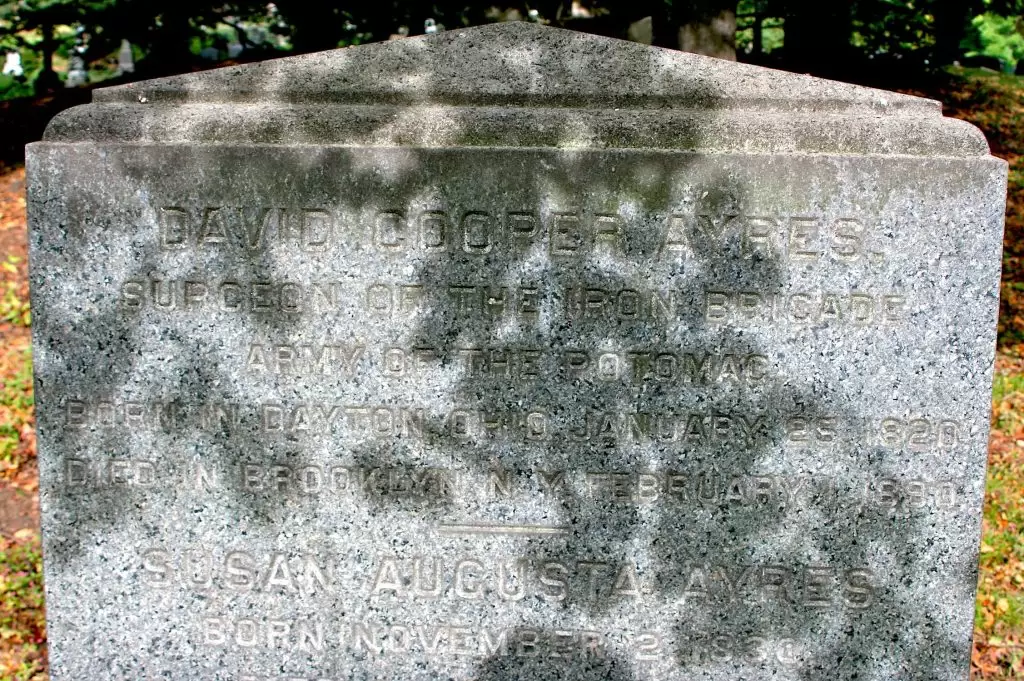
AYRES, GEORGE LOCKWOOD (1840-1930). Second lieutenant, 23rd New York Infantry, Company D; private, 13th Regiment, New York State Militia, Company G. Born in New Berne, North Carolina, Ayres served for three months in 1861 as a private in Company G of the 13th Regiment. He re-enlisted on June 18, 1863, was commissioned into the 23rd New York, and mustered out on July 22, 1863, at Brooklyn. His application for a pension was granted in 1908, certificate 1,150,388. He last resided at 141 Raymond Street in Rockville Centre, Long Island, where his death was attributed to heart disease. Section 75, lot 24797.
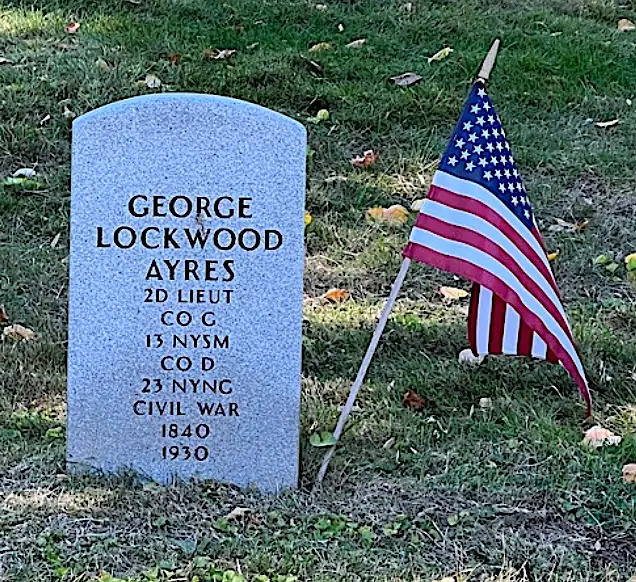
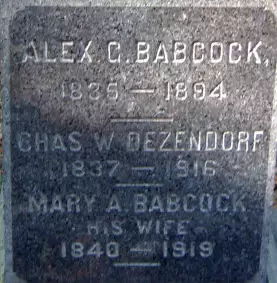
BABCOCK, ALEX G. (1835-1894). Fourth sergeant, 71st Regiment, New York State Militia, Company D. After Babcock enlisted in 1861 at New York City as a fourth sergeant, he served in the 71st Regiment for three months. He was treasurer for the Brooklyn Atlantics, a baseball team, in 1861 and 1862. The gravestone inscription may be a cenotaph; no cemetery records confirm his burial at Green-Wood. Section 109, lot 10447.
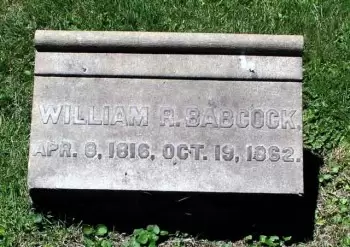
BABCOCK, WILLIAM R. (1816-1862). Cotton dealer. Born in Rhode Island, he was a cotton merchant who headed a firm that bore the name Babcock Bros. & Co. When he filed for a passport at age 35, he was 5′ 7½” tall with black eyes, brown hair, a broad forehead, large mouth and a dark complexion. Babcock was killed by gunshot at Bledsoe’s Landing, Tennessee, while aboard the federal steamer Gladiator plying the waters between Memphis, Tennessee, and Helena, Arkansas, when it was boarded by guerillas on October 18, 1862. As per The Daily Dispatch from Richmond, Virginia, Babcock was killed, several others were wounded, and the steamer was then set on fire. His obituary notes that he died the next day from the gunshot wounds. General William Tecumseh Sherman wrote from Union Headquarters at Memphis on October 19, 1862:
…Yesterday, or rather this morning at 2 a.m., the Gladiator touched at Bledsoe’s Landing, on the Arkansas shore, about 50 miles below this, and was boarded by a party of guerillas, who set fire to her in several places, killed the engineer and one passenger, wounded others, and as the boat took fire a rush of passengers for the shore disconcerted the guerillas, and during the confusion the boat backed off and managed to reach Memphis. Thirty-two of her passengers and crew are missing, but some are supposed to have reached you, in a yawl. Now, I beg you to consult with General Carr, who, I hope, coincides with me in opinion that we can not reach the guerillas, that they are gone, but we must make the people feel that this species of warfare can have but one result, viz, utter ruin to the country. I hope, with General Carr’s consent, you will proceed to Bledsoe’s Landing and then destroy all the houses and cornfields for miles along the river on that side.
The gunboat De Kalb is now below at the second bend below, having a similar destination, where the Catahoula was attacked (sic).
I think you should shell the whole river whenever one of these raids occurs, so as to make the inhabitants feel your power. I know it is cruel to make the innocent suffer for the acts of the guilty; but what can be so diabolical as these attacks on unarmed boats?
In addition, as a result of the guerilla efforts to cut off communication, General William T. Sherman issued Special Order #42 ordering that twenty families, selected from a lottery of forty-two families that had husbands in the Confederate Army, leave the Memphis area within three days and relocate twenty-five miles from the lines. Ultimately, twenty-seven women and seven men were ordered out of the area. He last lived at 75 3rd Place in Brooklyn. Section 48, lot 11161.
BABCOCK, WILLIAM V. (1833-1915). Second sergeant, 71st Regiment, New York State Militia, Company D. Born in Kingston, New Jersey, Babcock was a second sergeant with the 71st Regiment for three months in 1861. Active in the St. Albans Masonic Lodge, he served as its master in 1883-1884. In 1890, his application for a pension was approved, certificate 669,707. He last lived at 196 15th Street in Brooklyn. Section 204, lot 29752, grave 2.
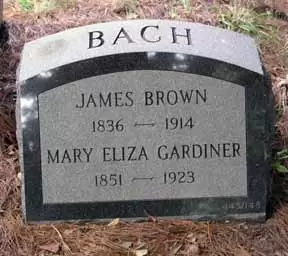
BACH, JAMES B. (1836-1914). First lieutenant, 13th Regiment, New York State National Guard, Company H. A Brooklyn native, he enlisted there and was commissioned as a first lieutenant into Company H of the 13th Regiment on May 28, 1862. He mustered out at Brooklyn after serving three months on September 12. Returning to service for 30 days in 1863, he was commissioned as a first lieutenant into Company H of the 13th Regiment, New York State National Guard, and mustered out on July 21 at Brooklyn. He last resided at 447 Belmont Avenue in Haledon, New Jersey. Bach died from a cerebral hemorrhage. Section 96, lot 145.
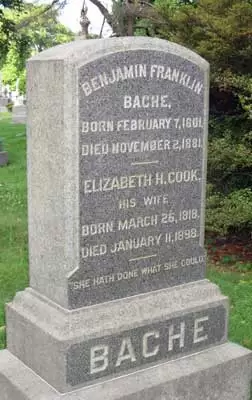
BACHE, BENJAMIN FRANKLIN (1801-1881). Surgeon, United States Navy. Born in Monticello, Virginia, on February 7, 1801, he was a great grandson of Benjamin Franklin. Richard Bache, his grandfather, was a Philadelphia merchant and patriot who was appointed Postmaster General of the United States from 1776-1782. During the Revolutionary War, his grandmother, Sarah Franklin Bache, supervised over 2,200 women in providing clothing and necessities to soldiers in 1780 and also served in hospitals during that conflict.
Dr. Bache graduated from Princeton College at the age of 18, and from the medical department of the University of Pennsylvania in 1823. He entered the United States Navy as an assistant surgeon in 1824, and in 1828, was promoted to the rank of surgeon. He was fleet surgeon of the Mediterranean Squadron from 1838 to 1841, was in charge of the Naval Asylum at Philadelphia from 1845 to 1847, served at the Naval Hospital of New York from 1850 to 1854, and was director of the laboratory at the Brooklyn Navy Yard from 1855 to 1872.
After the onset of the Civil War, Bache discovered that the supplies and drugs being furnished to the government were poor in quality and deficient in weight. With this knowledge, he undertook the reorganization of the department. He analyzed samples provided by the contractors and compared them to the products being delivered and marked “condemned” on the ones that were not up to standard, thus saving the government millions of dollars. Although many hoped to profit from disreputable practices, Bache saw himself as a defender of the government and worked to end fraudulent activities. His persistence in setting high standards made the laboratory under his administration one of the most efficient and thoroughly equipped in the nation. He retired from the service February 1, 1863, and in 1871, was appointed medical director with the rank of commodore.
His wife, Elizabeth Bache, was noted for her charitable interests in New York City where she was active in the affairs of the Home for the Friendless. According to his obituary in The Brooklyn Daily Eagle, he was an admired and knowledgeable conversationalist whose profile bore a resemblance to his ancestor, Benjamin Franklin. He died from kidney disease at his residence at 283 Henry Street in Brooklyn. Section 168, lot 20780.
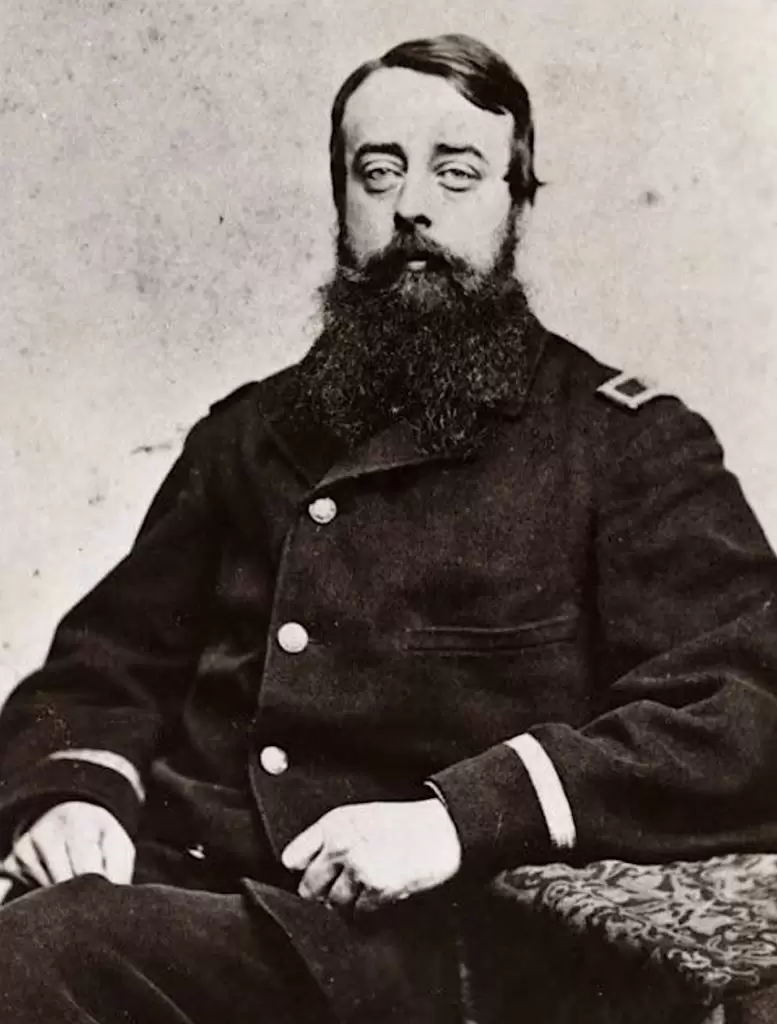
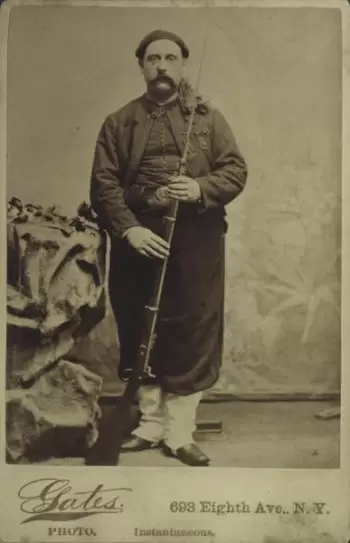
BACHMAN (or BACHMANN, BACKMAN), FREDERICK H. (1844-1900). Corporal, 48th New York Infantry, Companies B and I. Born in New York and a house painter by trade, Bachman was 5′ 8″ tall with blue eyes, dark hair and a dark complexion. After enlisting as a private at New York City on September 2, 1861, he mustered into the 48th three days later. He was shot in the head at Drewry’s Bluff, Virginia, on May 16, 1864. The bullet entered the left parietal bone, fractured his skull, and caused a two inch long wound. After spending two days in a field hospital, he was transferred to Hammond General Hospital at Point Lookout, Maryland, then on July 5 to St. Joseph’s Hospital in Central Park, New York City (although the transcript from the Surgeon General’s Office incorrectly listed him as a deserter during his hospitalization). He was promoted to corporal on September 27, 1864, was later transferred to Company I, and was reduced to ranks at some point. Bachman was absent and sick when his company mustered out on September 1, 1865, at Raleigh, North Carolina. He was discharged for disability on September 11, 1865.
After the war, Bachman was employed as a milkman and later as a janitor at his Manhattan residence but was unable to work steadily because of epileptic seizures, headaches, dizziness and other problems that stemmed from his head injury. In 1898, when a monument was dedicated to the colonel of the 48th, James Perry, who was the pastor of the Hanson Place Methodist Church in Brooklyn and who died on June 18, 1862, at Fort Pulaski in Savannah, Georgia, Bachman spoke eloquently about the War and Perry’s leadership. “…But while these solemn thoughts of our colonel fill our hearts, it is but natural that our minds should also revert to the battlefield, the prison-pens, and other death bed scenes of those with whom we stood ‘shoulder to shoulder’ in the great struggle for our flag and country. Therefore let us pause;-and while we are reminded of our beloved comrades, we will with the same tenderness, drop a flower, and place a flag on the graves of those noble comrades in arms, who died that the nation might live-and whose memory we also cherish and hold dear.”
In 1891, Bachman served on the reunion committee for Civil War veterans and wore his Zouave uniform to the event. His application for an invalid pension, filed in 1875, was approved under certificate 137,868. His last residence was at 137 Centre Street in Manhattan. After his death from appendicitis in 1900, Catherine Bachman, who is interred with him, applied for and received a widow’s pension. Although he spelled his surname, Bachman with one “n,” his ancestors and descendants used the spelling, “Bachmann.” Section 112, lot 12611, grave 11.

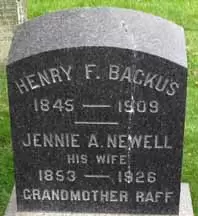
BACKUS, HENRY F. (1845-1909). First class fireman, United States Navy. Originally from Boston, Massachusetts, Backus enlisted in the United States Navy at Brooklyn as a first class fireman in October 1864. He served on board the USS North Carolina, the Tallapoosa (on her first wartime voyage) and the Powhatan in the Atlantic Blockading Squadron. He was discharged in October 1865 at Boston.
In 1891, Backus received an invalid pension from the Navy citing a disease of the nervous system, certificate 14,274. His last address was 162 Willoughby Avenue in Brooklyn. Shortly after his death from ataxia in 1909, Jennie A. Newell-Backus, who is interred with him, applied for and received a widow’s pension, certificate 20,859. Section 59, lot 1459, grave 51.
BACON, BENJAMIN D. (1838-1896). Private, 7th Regiment, New York State National Guard, Company B. A native of Newton, Massachusetts, his ancestry can be traced back to the Puritans who settled in the colonies in 1711. His family moved to New York City when Bacon was six and he later graduated from the College of the City of New York. Bacon served with the 7th Regiment when it was activated for three months in 1862 and returned to the same regiment and company for 30 days in 1863.
After settling in Brooklyn in 1865, Bacon was engaged in the stationery business for eighteen years, then joined William J. Matheson & Company, an establishment that manufactured dyes, in 1886, and was secretary and treasurer of that company. Bacon remained active in military affairs achieving the rank of captain in the 12th Regiment, New York State Militia. A Freemason, he also was a director of the Hanover Club in the Eastern District of Brooklyn. He last lived at 155 Rutledge Street, in the same house that he purchased in 1865. Section 154, lot 22104, grave 4.
BACON, RICHARD SMITH (1839-1897). Private, 7th Regiment, New York State National Guard, Company G. A native of New York City, he was a graduate of the Columbia College School of Law, class of 1862. Bacon was 5′ 10″ tall with a light complexion, blue eyes, and light hair when he enlisted and mustered into the 7th Regiment on May 25, 1862. He served with the 7th Regiment in July at Baltimore, Maryland, and mustered out on September 5 at New York City. Bacon returned to the same company when the 7th National Guard was reactivated for 30 days in 1863 from June 16 until July 20.
Bacon was admitted to the bar in 1863, then studied medicine, graduating from the College of Physicians and Surgeons in 1865. According to an obituary, he practiced medicine for about a year during which time he was associated with the Kings County and Maternity Hospitals. He then became associated with his brother, Dr. George W. Bacon, who was an instructor at the Columbia Grammar School. Richard Smith Bacon later became headmaster of the institution, and remained in that position until he retired a year before his death. Active in Republican Party politics, he lived in Flushing for many years. He last lived on West 104th Street and Riverside Drive in Manhattan. His Civil War scrapbook is part of the collection of The Green-Wood Historic Fund. The album includes ephemera from his career, a $10 Confederate note, military passes for the 7th Regiment and pen and pencil sketches. Section 122, lot 1535.
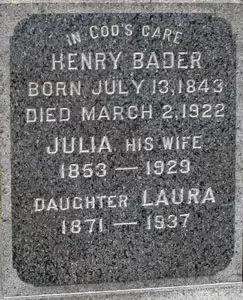
BADER, HENRY (1843-1922). First class musician, New York State Militia. A German native, Bader enlisted as a private at New York City in April 1861 and served for 30 days in the Field and Staff of the 7th Regiment. In 1862, he returned to the 7th, now part of the New York State National Guard, and was a first class musician assigned to the Field and Staff for the three month activation from May 25-September 5. He served again in the 7th as a musician for 30 days in 1863.
In 1908, Bader applied for and received a pension, certificate 1,152,873. His last residence was 121 East 95th Street, New York City. Shortly after his death from heart disease, Julia Bader, who is interred with him, applied for a widow’s pension that was granted, certificate 916,237. Section 148, lot 21080.
BADER, JOHN (1837-1905). Corporal, 90th New York Infantry, Company F; private, 1st New York Engineers, Company M. A native of Germany, Bader enlisted as a corporal at Brooklyn on October 10, 1861, and immediately mustered into the 90th New York. He was discharged for disability on March 6, 1862, at Key West, Florida. Subsequently, he re-enlisted as a private at New York City on February 18, 1865, mustered immediately into Company M of the 1st New York Engineers, and mustered out on June 30, 1865, at Richmond, Virginia.
In 1879, Bader’s application for an invalid pension was approved under certificate 177,976. The 1890 Veterans Schedule confirms his Civil War service. He last resided at 5020 Third Avenue in Brooklyn. Bader died from pneumonia. Section 128, lot 31394, grave 263.
BAGLEY, BENTON B. (1847-1921). Private, 91st New York Infantry, Company H. Bagley enlisted as a private at New York City on September 10, 1864, at the age of 17. After mustering into the 91st New York, he deserted from the regiment. His last residence was 1793 Montgomery Avenue in the West Bronx. He died from pneumonia. Section 118, lot 5937.
BAGLEY, JAMES (or AUSTIN) (1835-1907). Private, 109th New York Infantry, Company G. Of Irish birth, he enlisted at Enfield, New York, on August 11, 1862, mustered in on August 18, and mustered out on June 4, 1865, at Delaney House, Washington, D.C. His army and pension records indicate that he was also known by the first name “Austin.” Bagley applied for and was granted an invalid pension under certificate 694,973. He was a resident of 39 West 21st Street in Manhattan at the time of his death from enteritis. As per his obituary in the New York Herald, California newspapers were asked to print a notice of his death—indicating that he had a connection to that state. His widow, Sarah Bagley, applied for and received a pension in 1914, certificate 788,786. Section 196, lot 30774, grave 2.
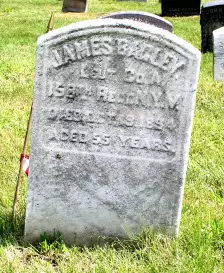
BAGLEY, JAMES (1841-1894). Second lieutenant, 158th New York Infantry, Company A. A native of Ireland, he enlisted at Brooklyn as a first sergeant on August 8, 1862, and mustered into the 158th New York on August 30. Bagley was promoted to second lieutenant on January 18, 1865, and mustered out on June 30, 1865, at Richmond, Virginia.
In 1893, Bagley applied for an invalid pension, application 1,152,210, but he died from tuberculosis before it was certified. His last address was 663 DeKalb Avenue in Brooklyn. Catherine Bagley applied for and received a widow’s pension, certificate 401,954. Section 135, lot 27263, grave 801.
BAILEY, GEORGE W. (1820-1863). Private, 127th New York Infantry, Company A. Born in Tennessee, he enlisted at New York City on August 13, 1862, mustered into the 127th the next month on September 8, and died of chronic diarrhea at the hospital at Fort Schuyler, New York Harbor, on October 24, 1863. He last lived at 80 Louis Street in Manhattan. Section 115, lot 13536 (Soldiers’ Lot), grave 76.
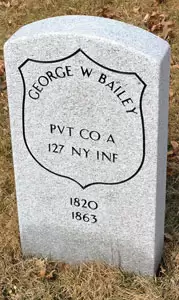
BAILEY, SAMUEL H. (1845-1892). Private, 47th New York Infantry, Company C. A New Yorker by birth, Bailey enlisted as a private at New York City on May 18, 1861, and mustered into the 47th New York on August 7. According to his obituary in the New York Herald, he entered service as a drummer boy at fifteen and soon shouldered a musket. He was discharged on August 7, 1864.
After the war, Bailey returned to New York City where he became a marble-cutter. A commander of the Judson Kilpatrick Post #143 of the G.A.R., he was a member of a Masonic lodge and the order of Foresters and Chosen Friends. He was also president of the 47th Veterans and hosted their reunion on September 16, 1882, at the Atlantic Park Hotel in Rockaway, New York. Among his duties as commander, as noted in The New York Times was to preside over the viewing of General Judson Kilpatrick’s body at City Hall on October 18, 1887, and to call on fellow members to escort the body to Jersey City and then travel by train to West Point for funeral services. Bailey’s tribute to Kilpatrick said in part, “How truly it may be said that such a loss to our fair Republic is irreparable. Its cities may be destroyed, and it can rebuild them; it can lose its wealth and it can regain it; but its great men, its good men, its brave men–their loss can never be retrieved. A gallant and intrepid soldier, a wise and honest statesman, a true and courteous gentleman–these are the qualities which endear our brave comrade to us, and bind the memories of his deeds around our standard.”
Bailey was elected alderman of the 23rd district in 1890, taking office in January 1891. On May 28, 1891, an article about Alderman Bailey’s silver wedding anniversary party at Stuyvesant Hall on Third Avenue and 106th Street appeared in The New York Times describing a lavish affair with music, supper, and elegant gifts to the couple who had eight children. On October 5, 1892, he resigned his position as alderman citing ill health over the past several months. In 1892, his application for an invalid pension was granted, certificate 882,066. He last lived at 114 East 103rd Street in Manhattan. His death was attributed to apoplexy. In 1893, Mary Bailey was awarded a widow’s pension, certificate 371,503. Section 85, lot 1594, grave 274.
BAINES, EDWARD (1839-1863). Musician, 5th United States Cavalry; 2nd United States Cavalry. A native of Germany, he may be the Edward Baines who enlisted as a musician and served with the 5th United States Cavalry and the 2nd United States Cavalry. At some point during the Civil War, he was wounded and died in New York City from those injuries on January 6, 1863. His last residence was on West 41st Street in Manhattan. Section 115, lot 4196, grave 325.
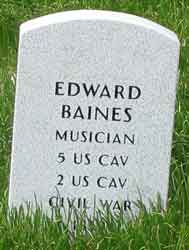
BAIRD, MARCUS H. (1838-1915). Acting ensign, United States Navy. Born in Watertown, New York, Baird enlisted in the United States Navy as a mate on November 1, 1862. He resigned on July 9, 1863, then re-enlisted as a mate on August 31, 1863, and was promoted to acting ensign on November 5 of that year. He resigned on January 4, 1865.
After the War, Baird relocated to Brooklyn where he was active in Republican Party politics and was a member of the Republican General Committee at Albany for three years. He was a member of the Marine Society, the New York Produce Exchange, and was involved in the development of Glen Island, a summer resort on Long Island Sound in New Rochelle, New York. His last residence was 1191 Dean Street in Brooklyn. Baird died from a cerebral hemorrhage. Section 196, lot 30137, grave 1.
BAIRD, THOMAS W. (1818-1886). Captain, 82nd New York Infantry, Company B. At age 42, he enlisted at New York City as a first lieutenant on May 17, 1861, and was commissioned into the 82nd New York four days later. Baird was promoted to captain on September 7, 1861, and mustered out at New York City on June 11, 1864. In 1880, he applied for an invalid pension, application 380,875. His last residence was at 3 Bank Street in Manhattan. Baird died from paralysis. Section 143, lot 23567.
